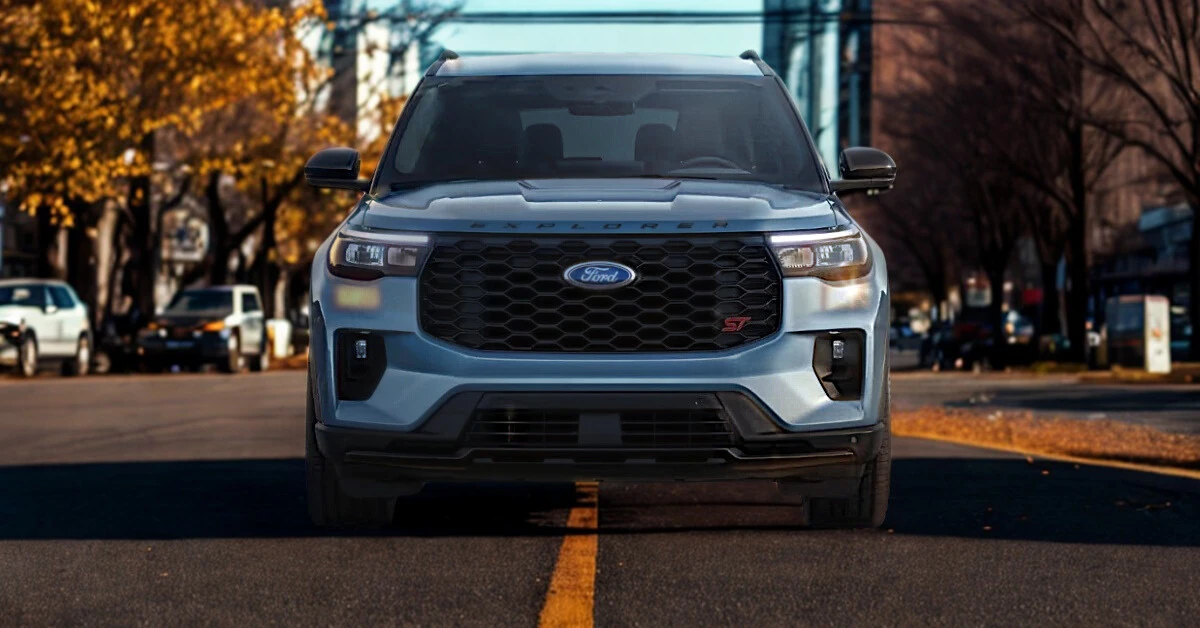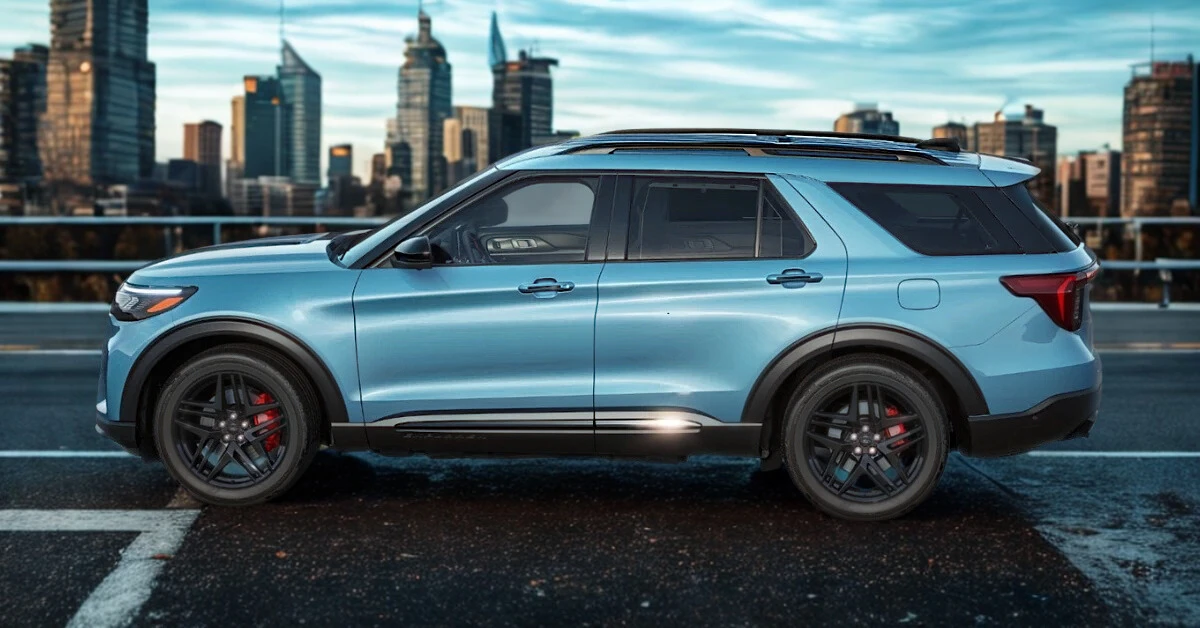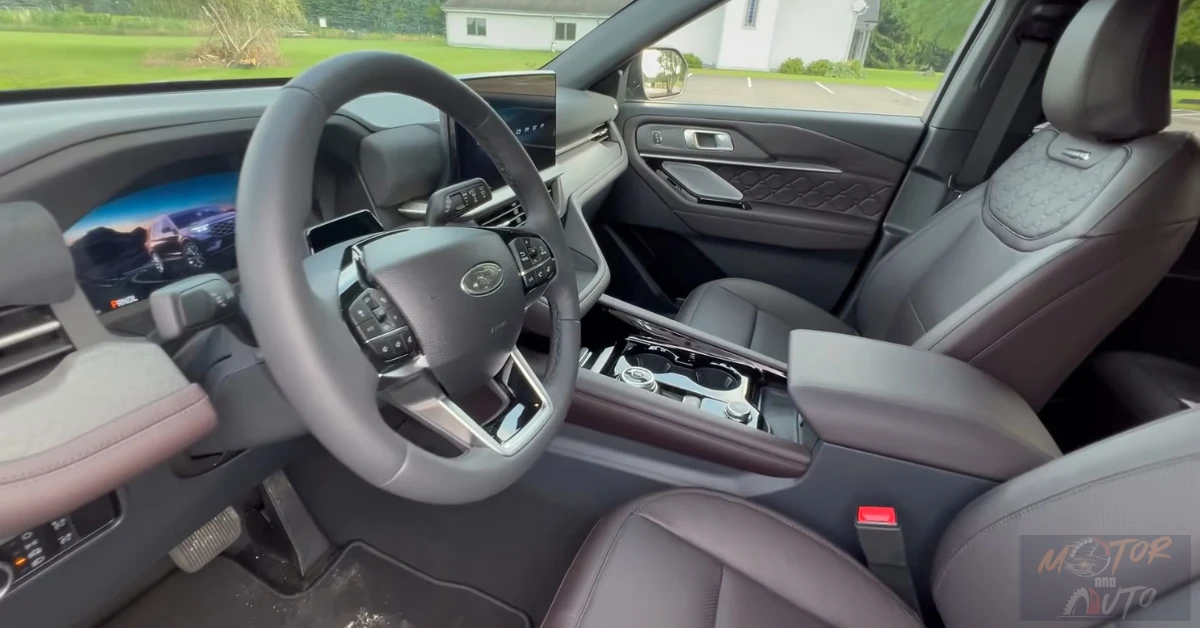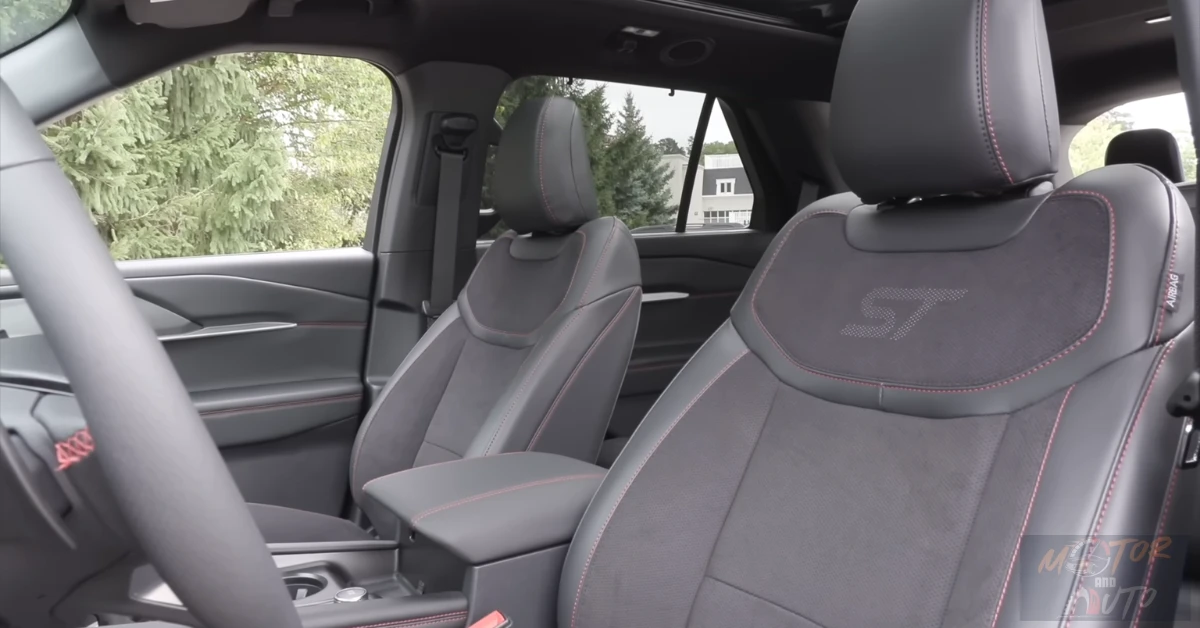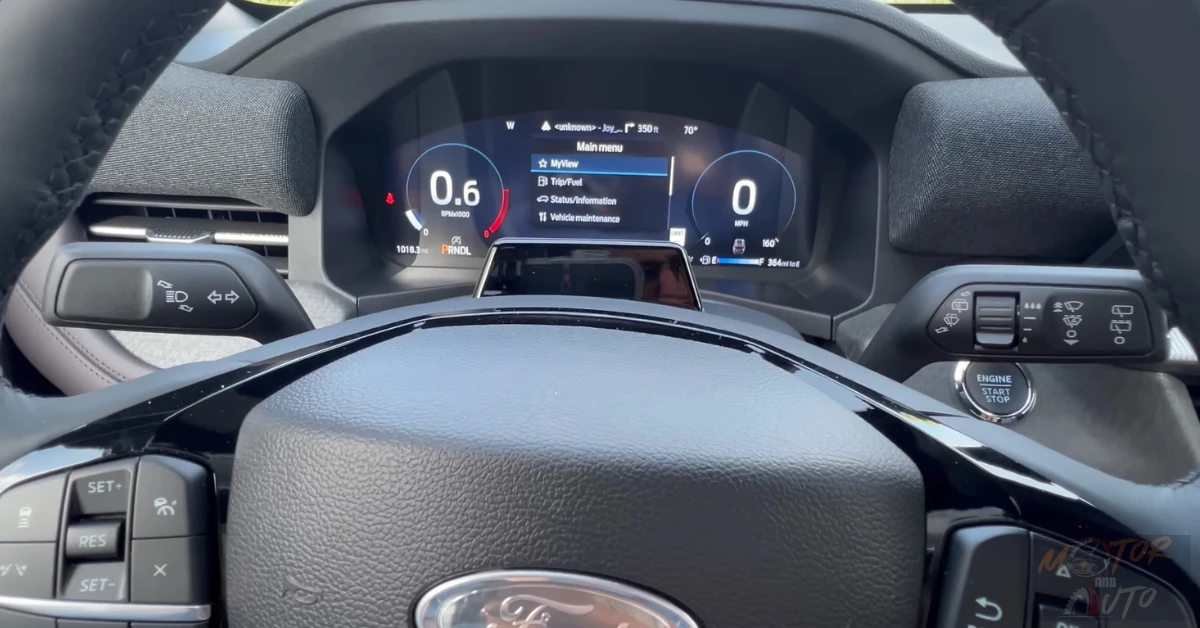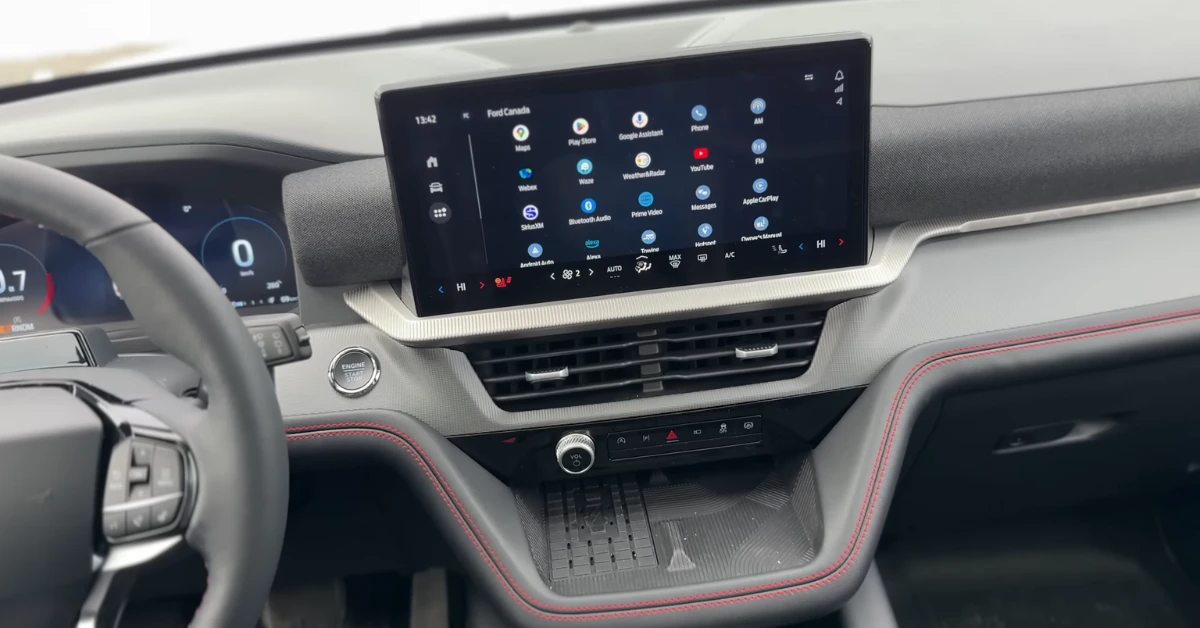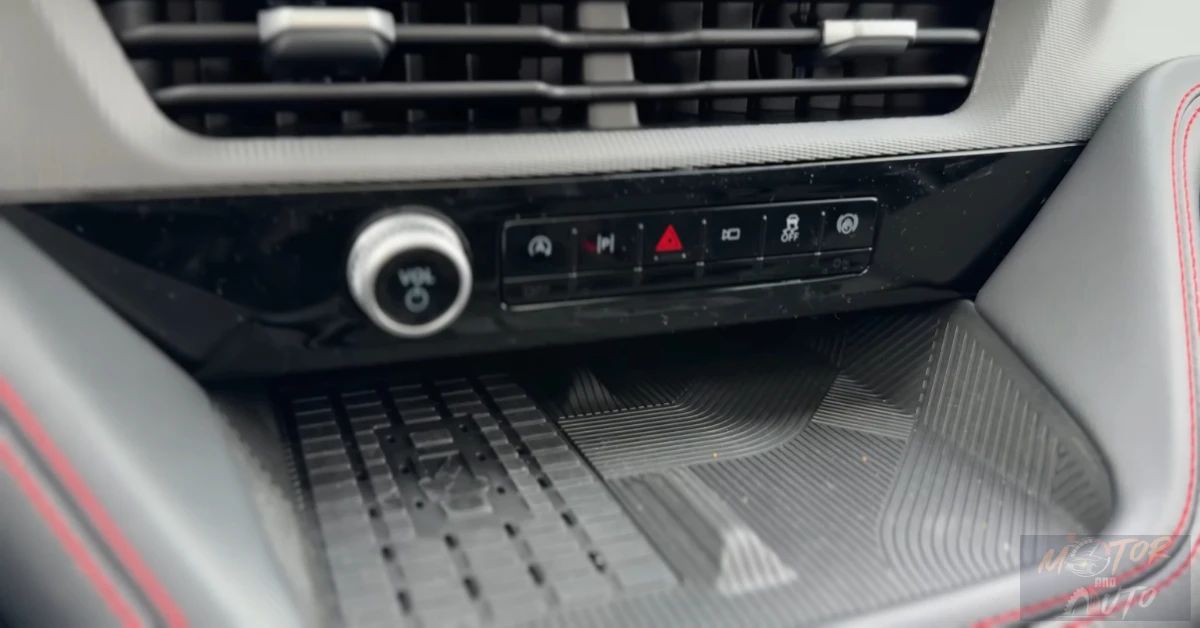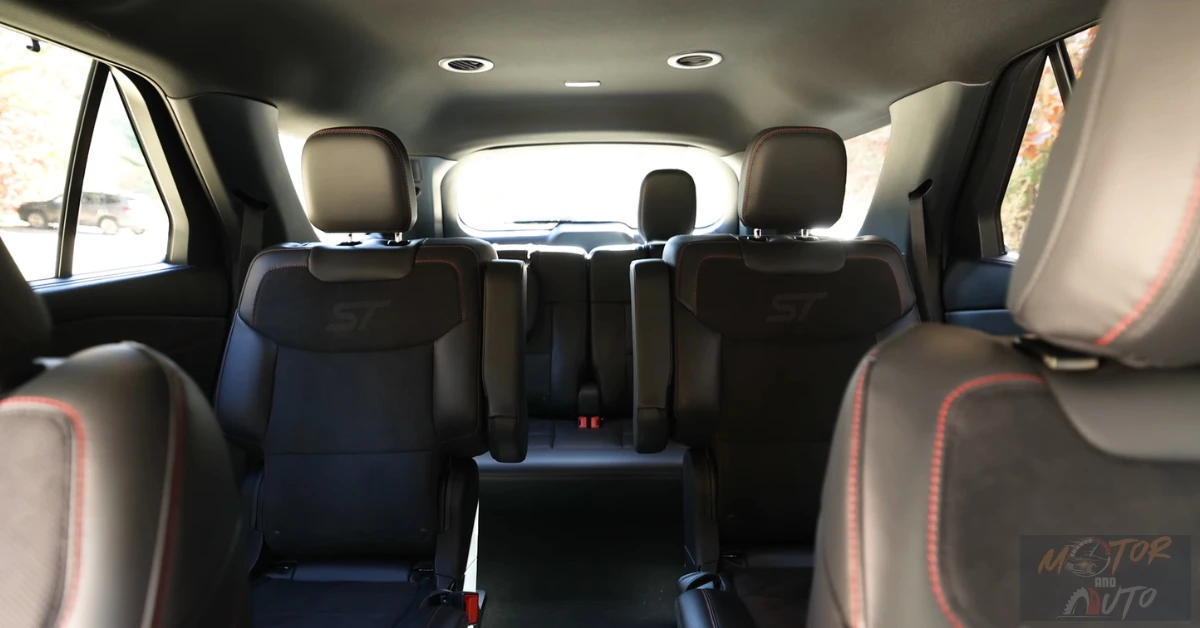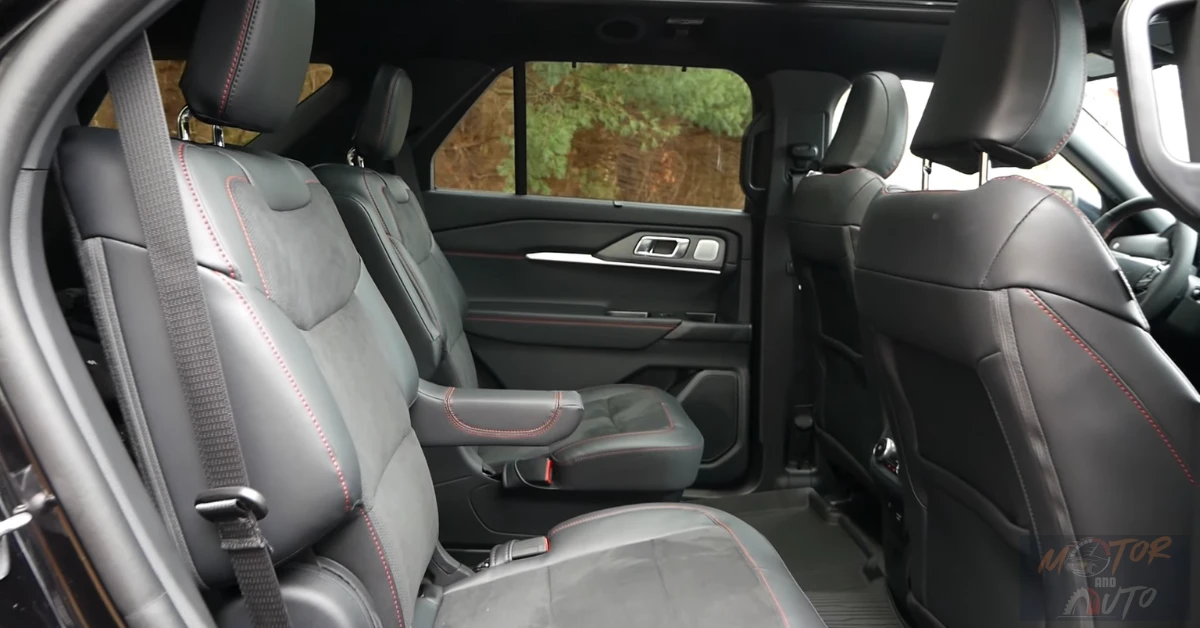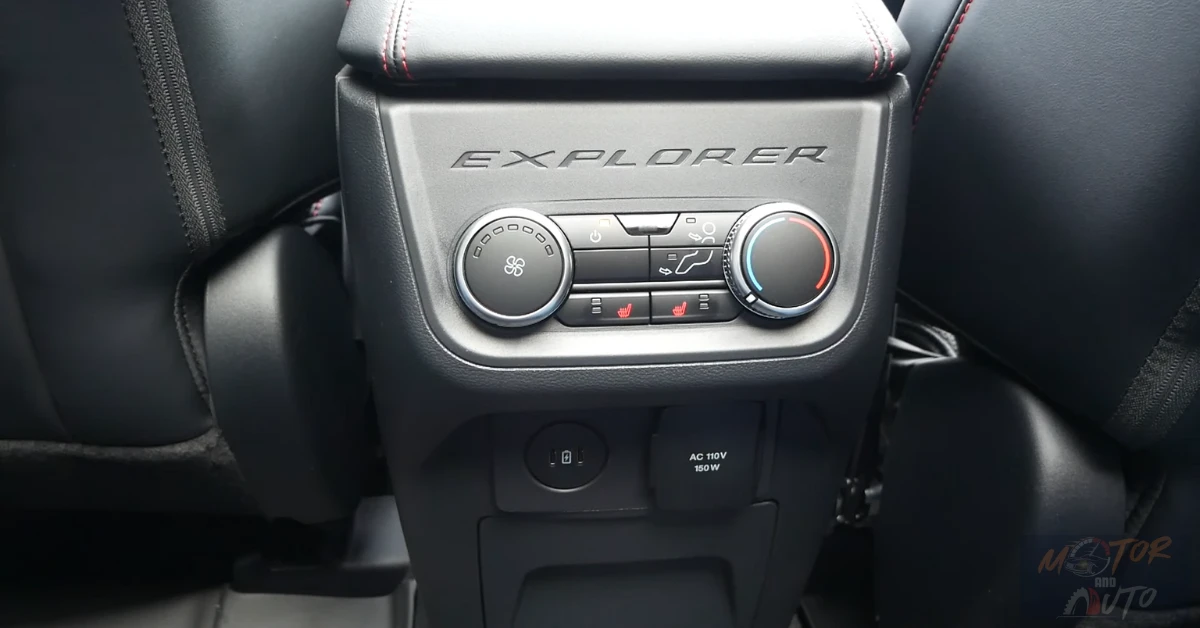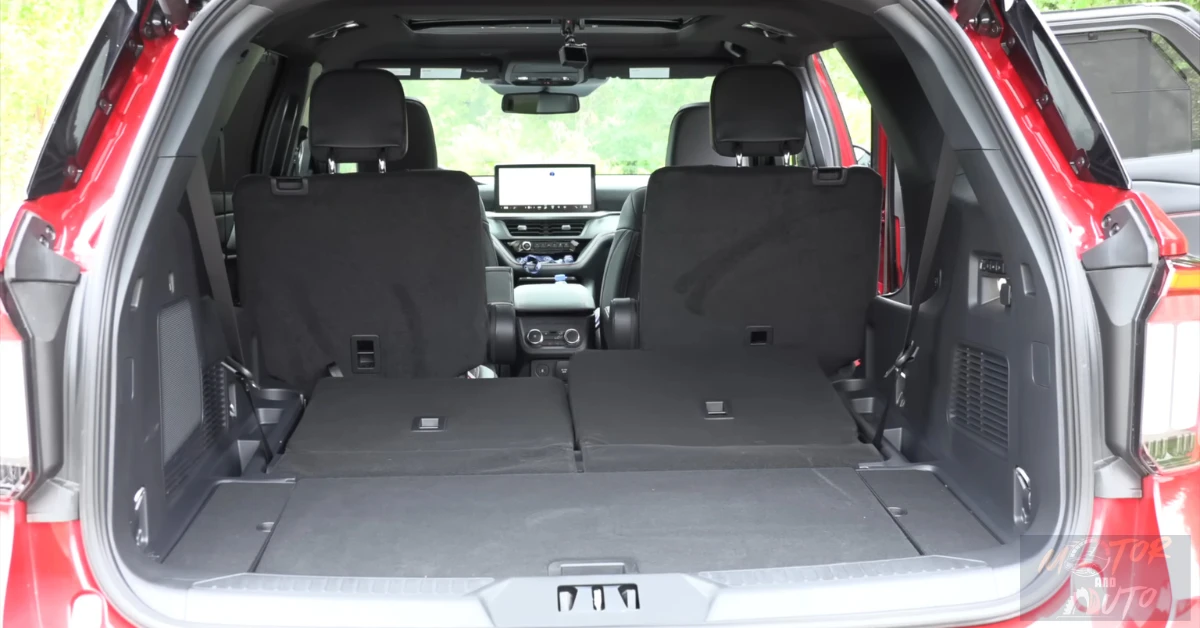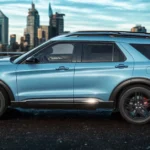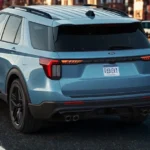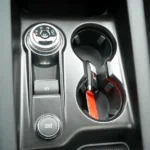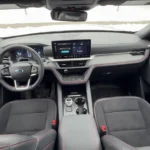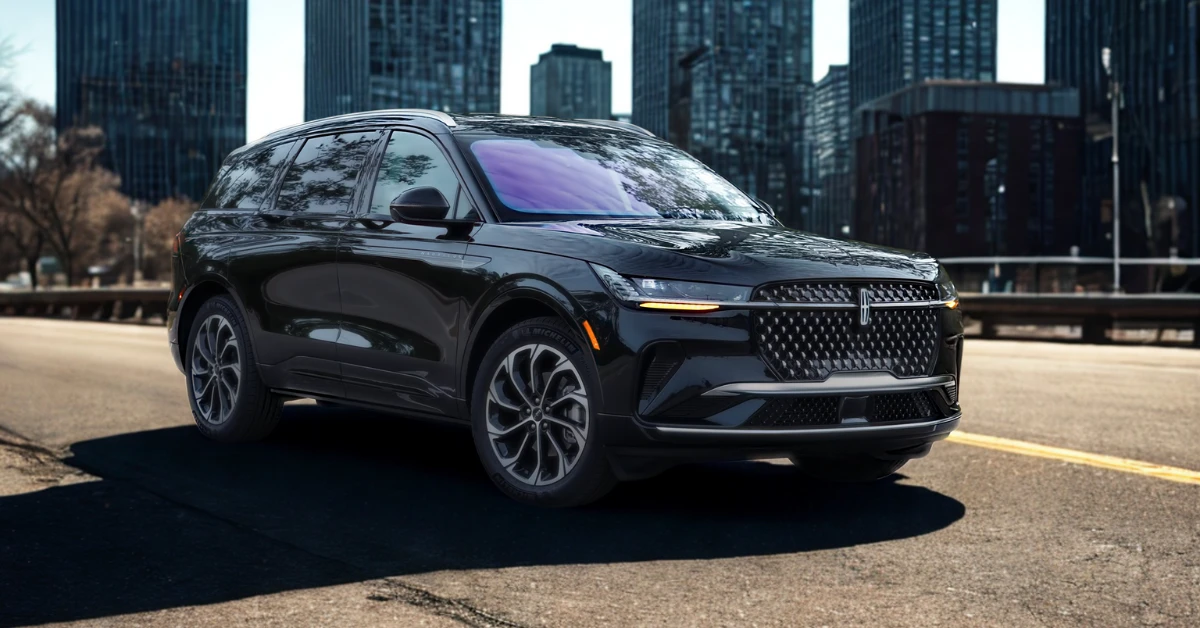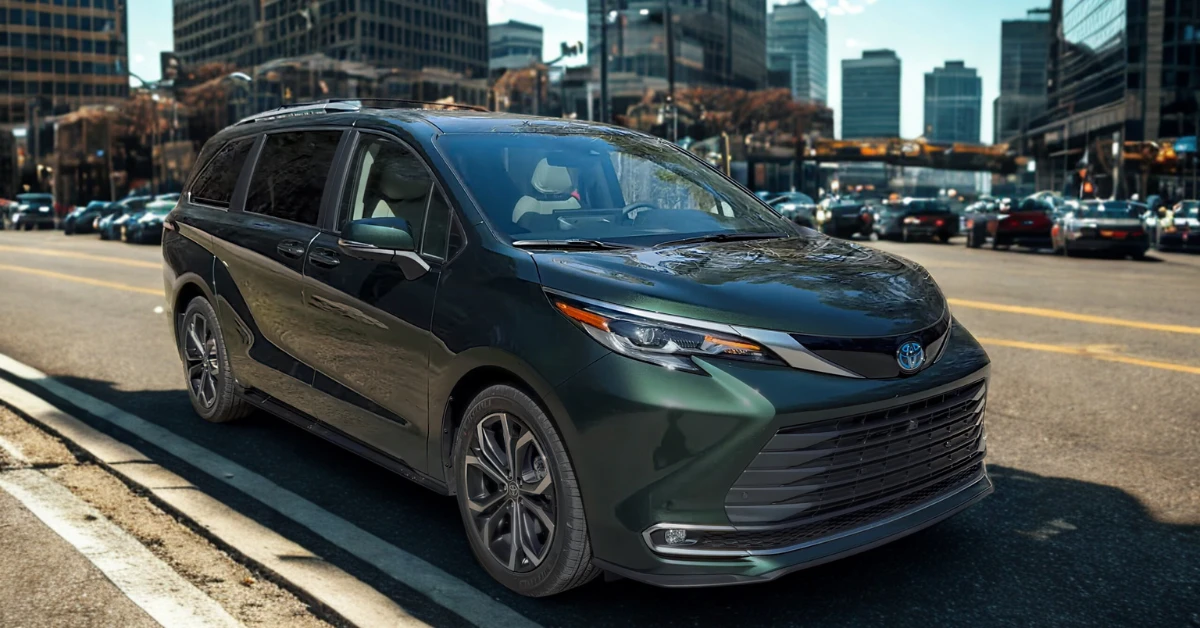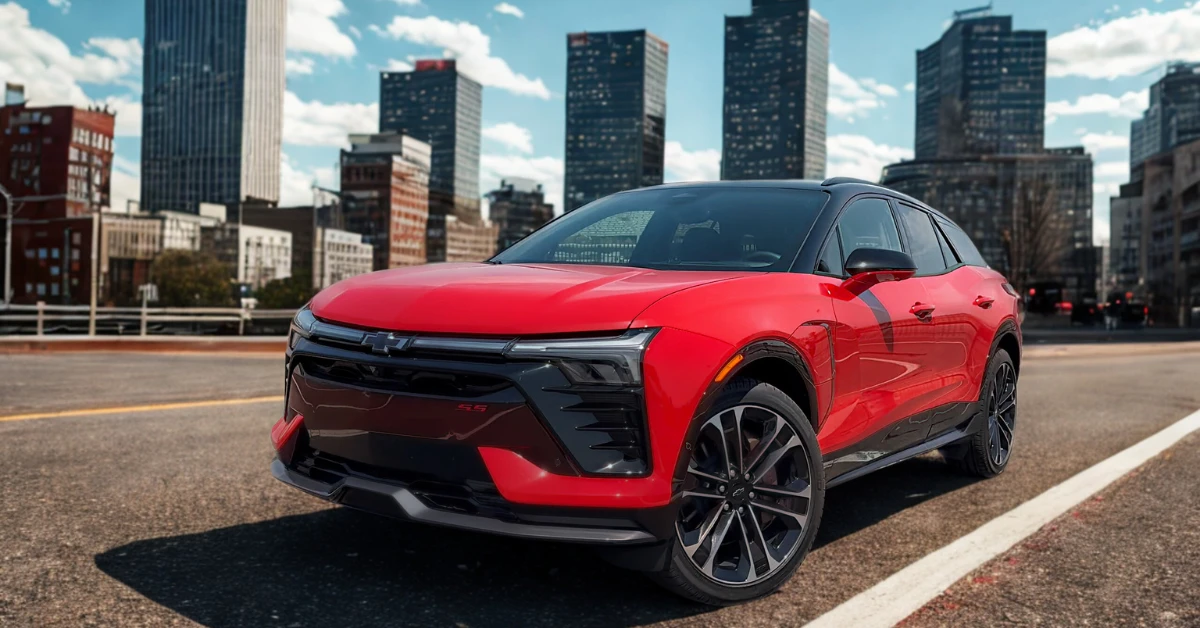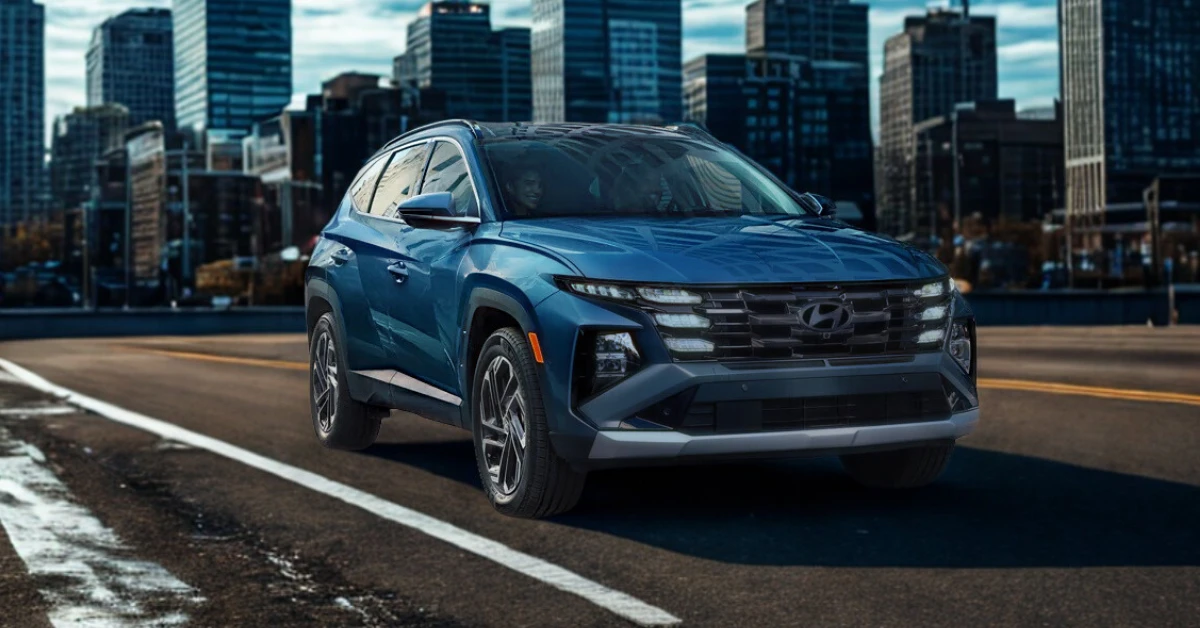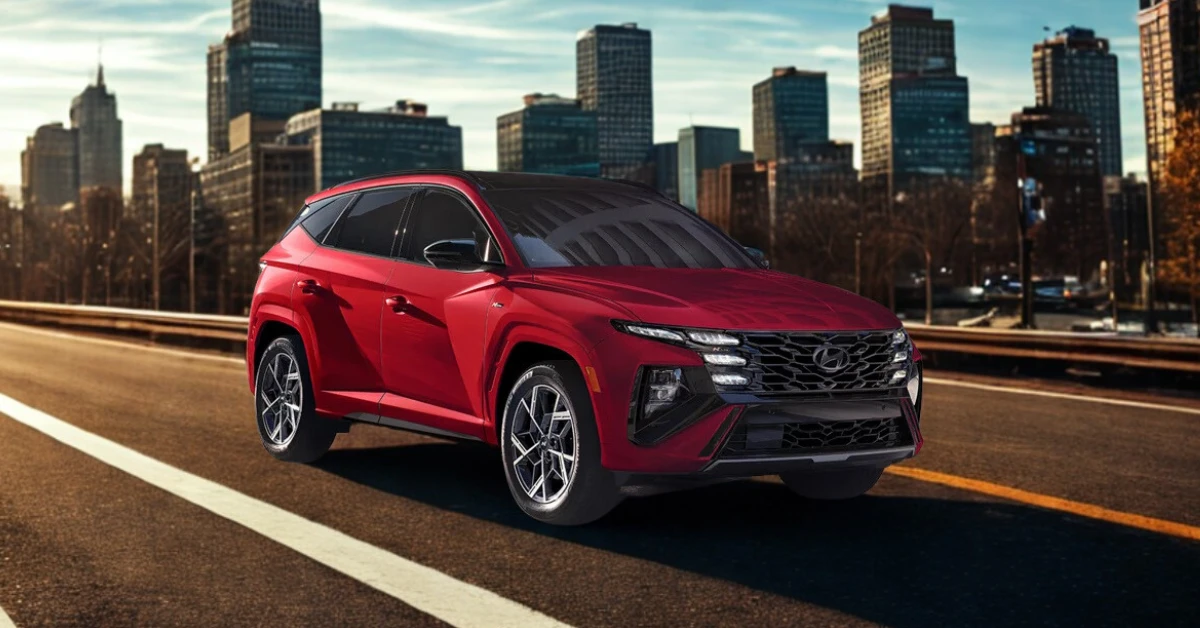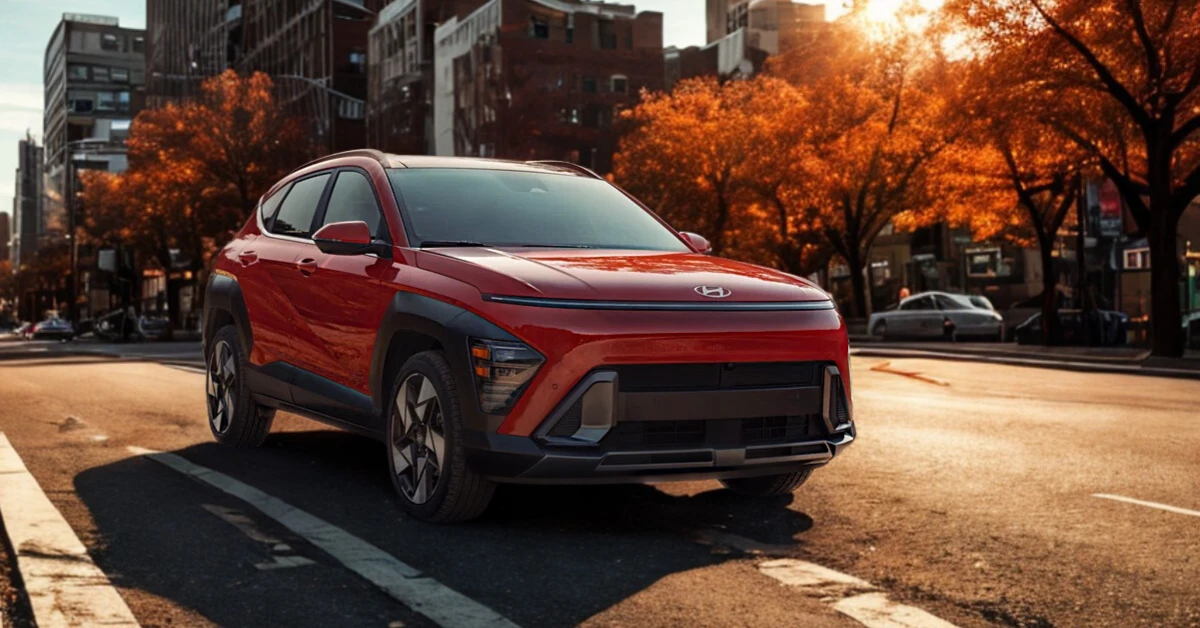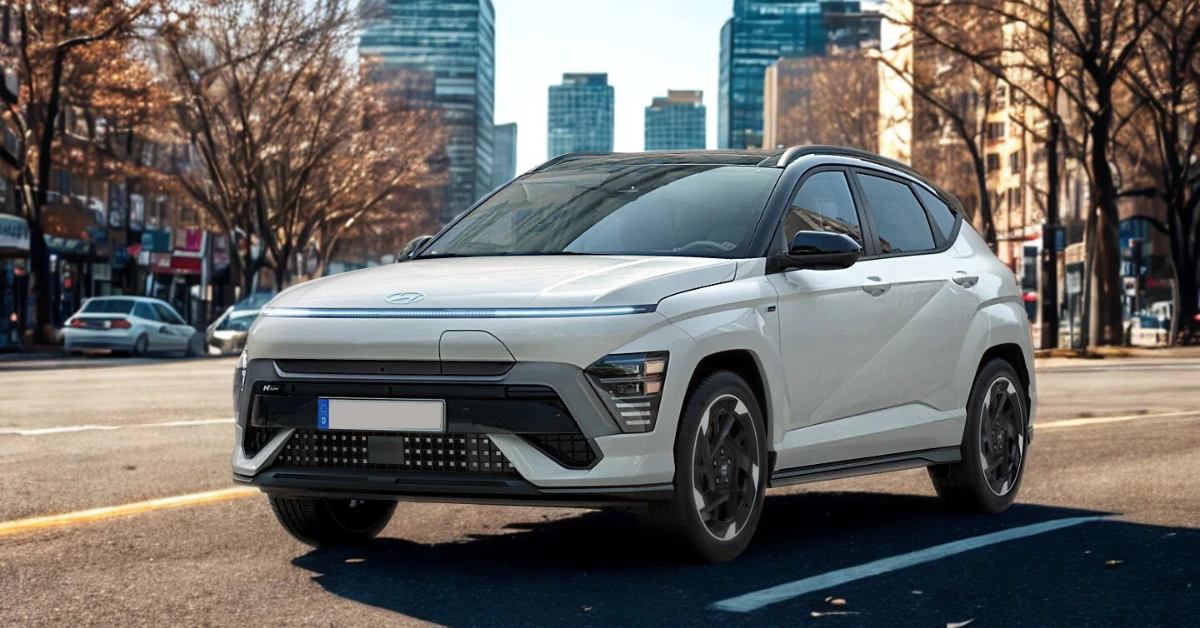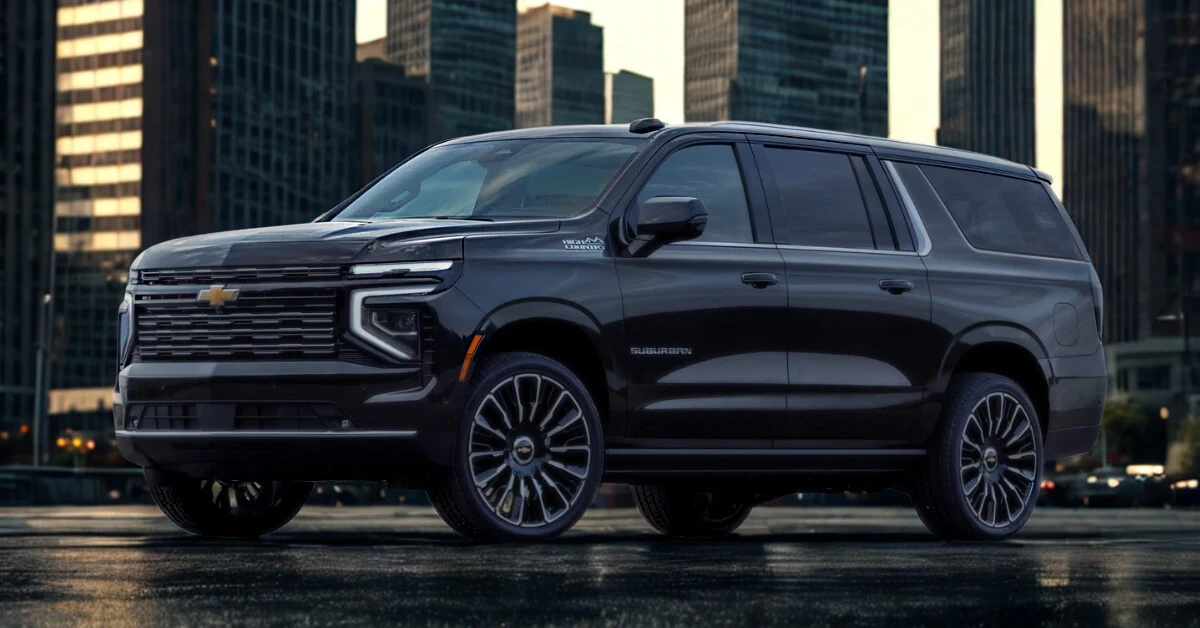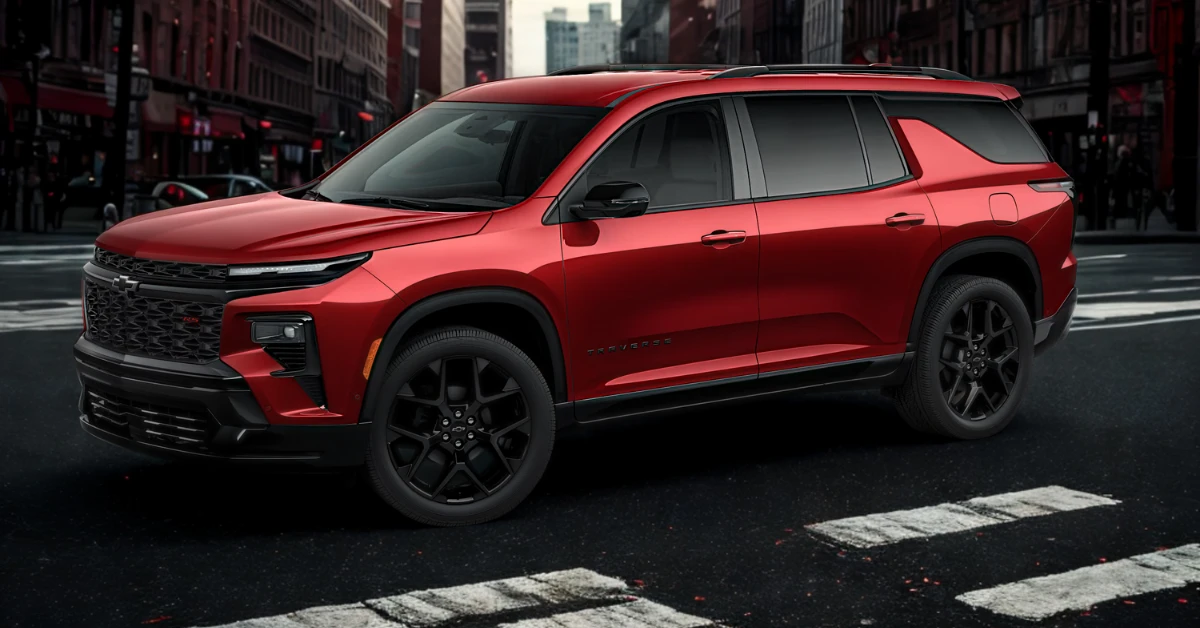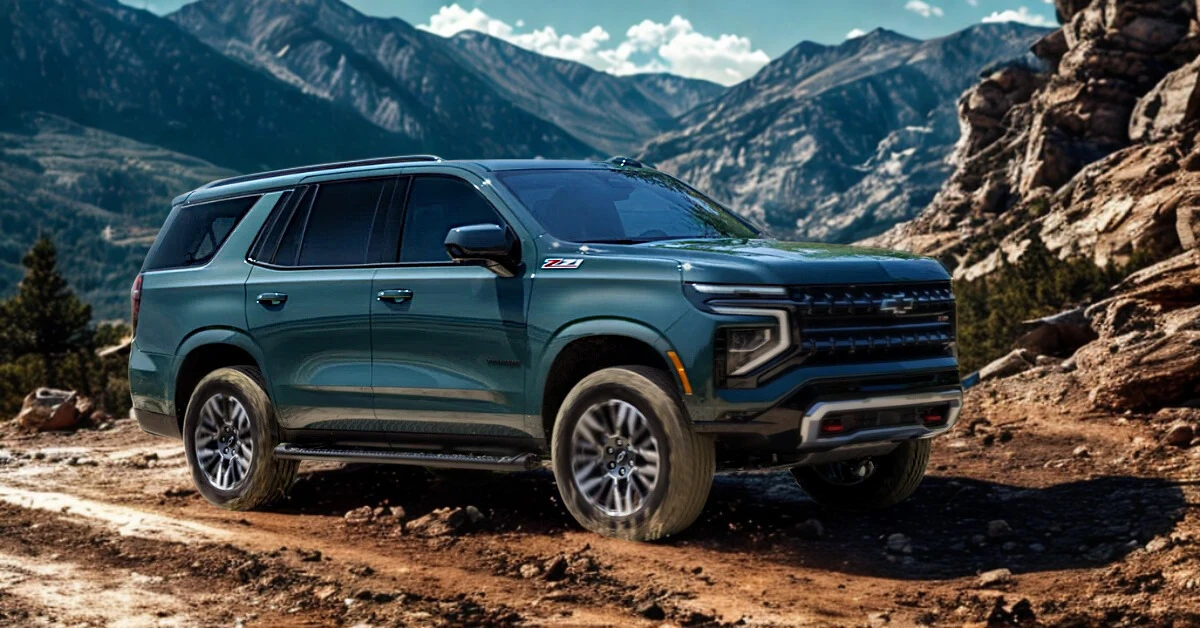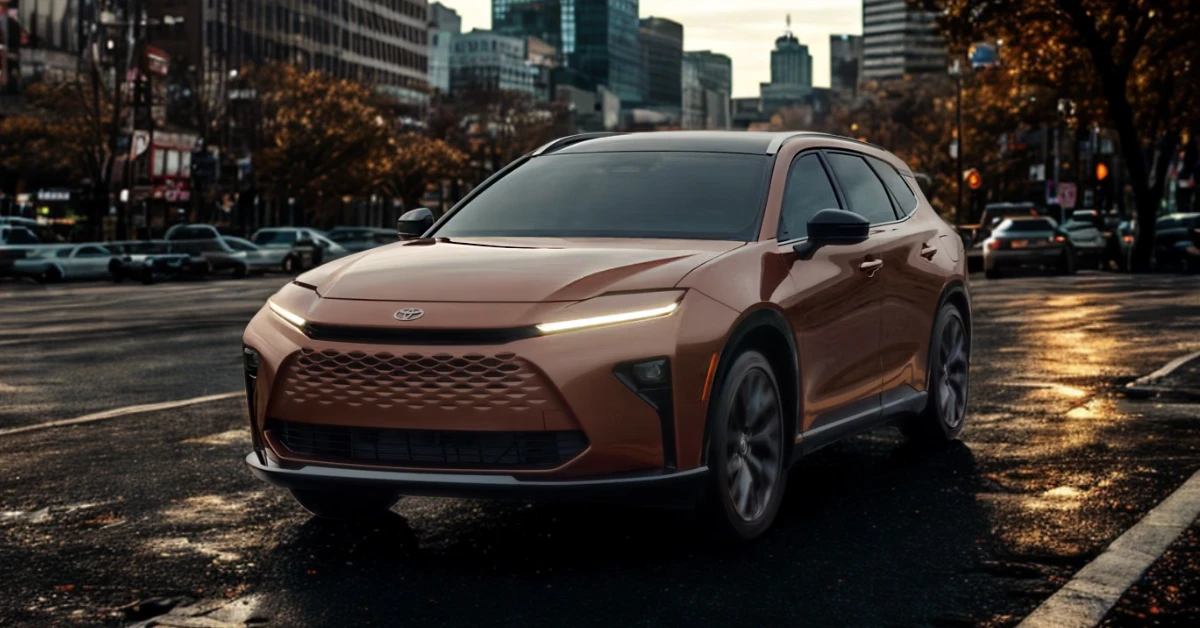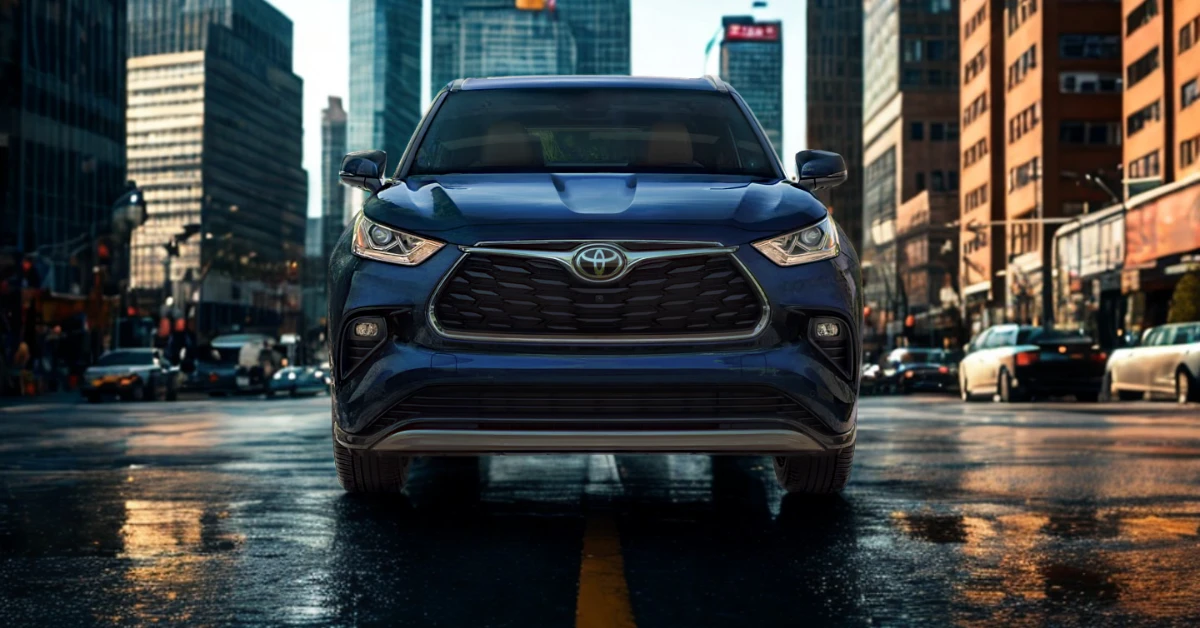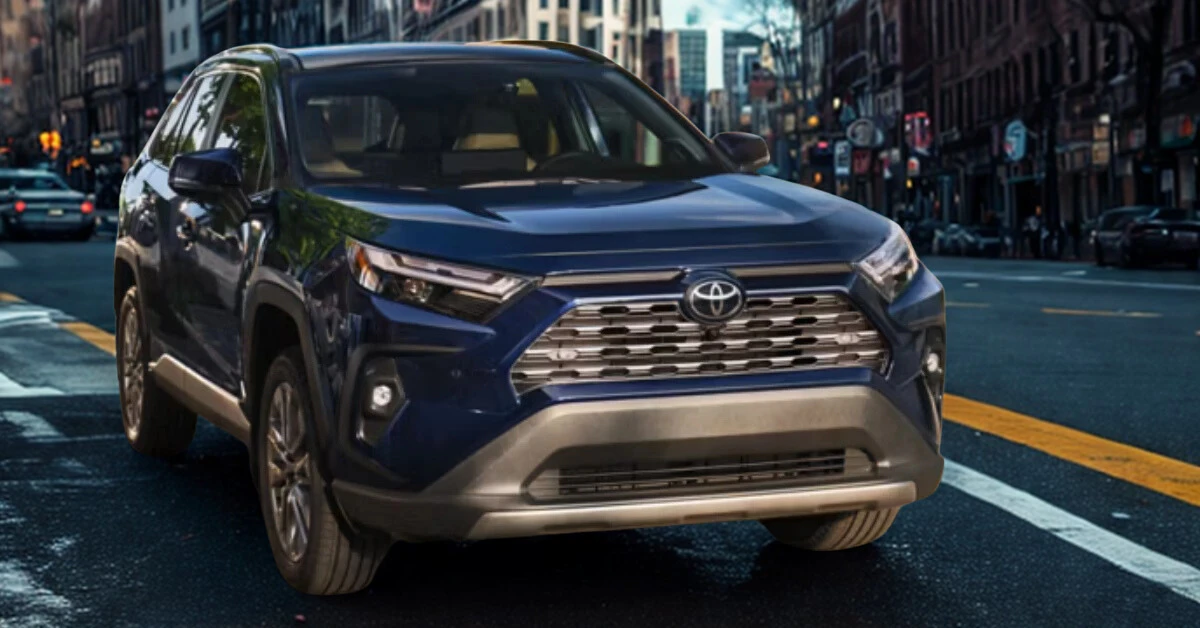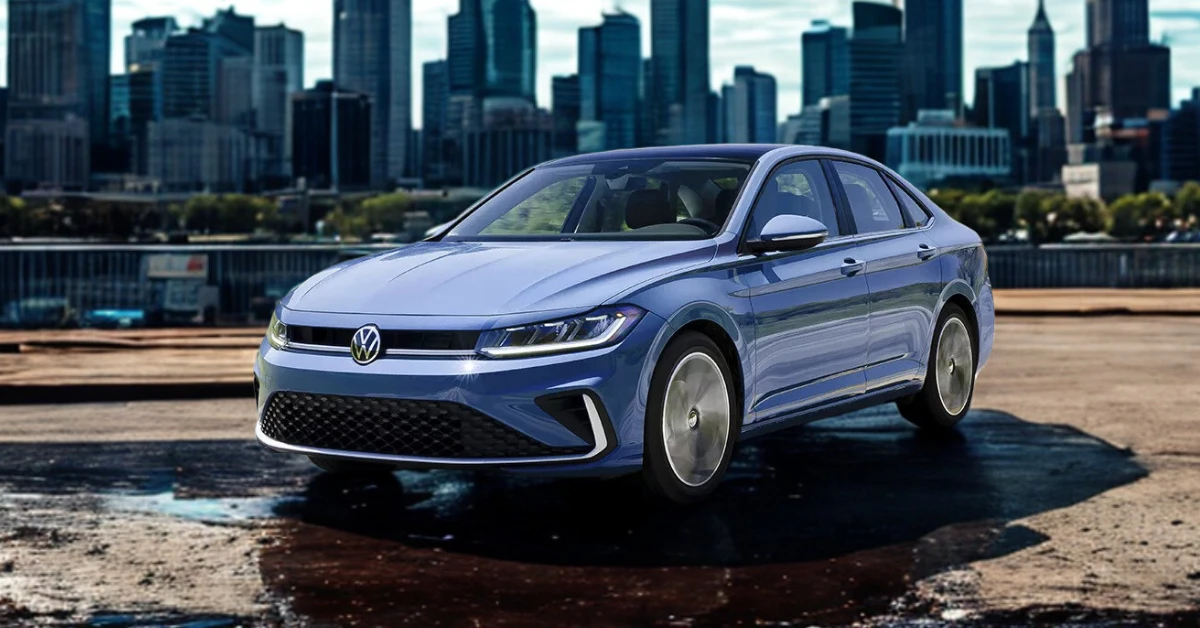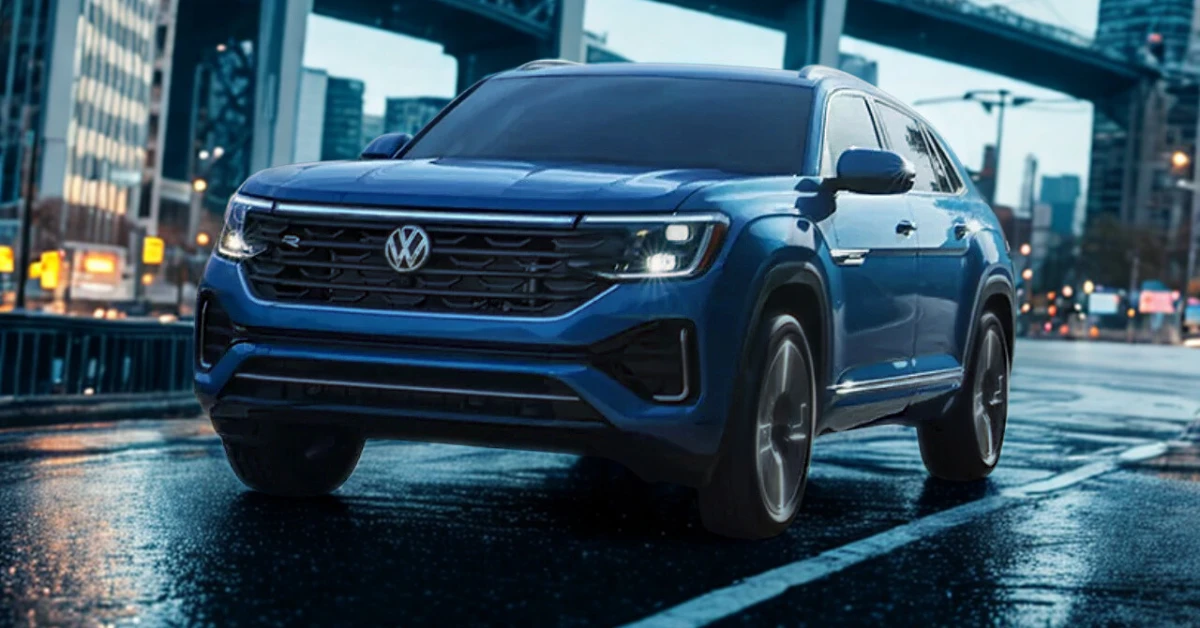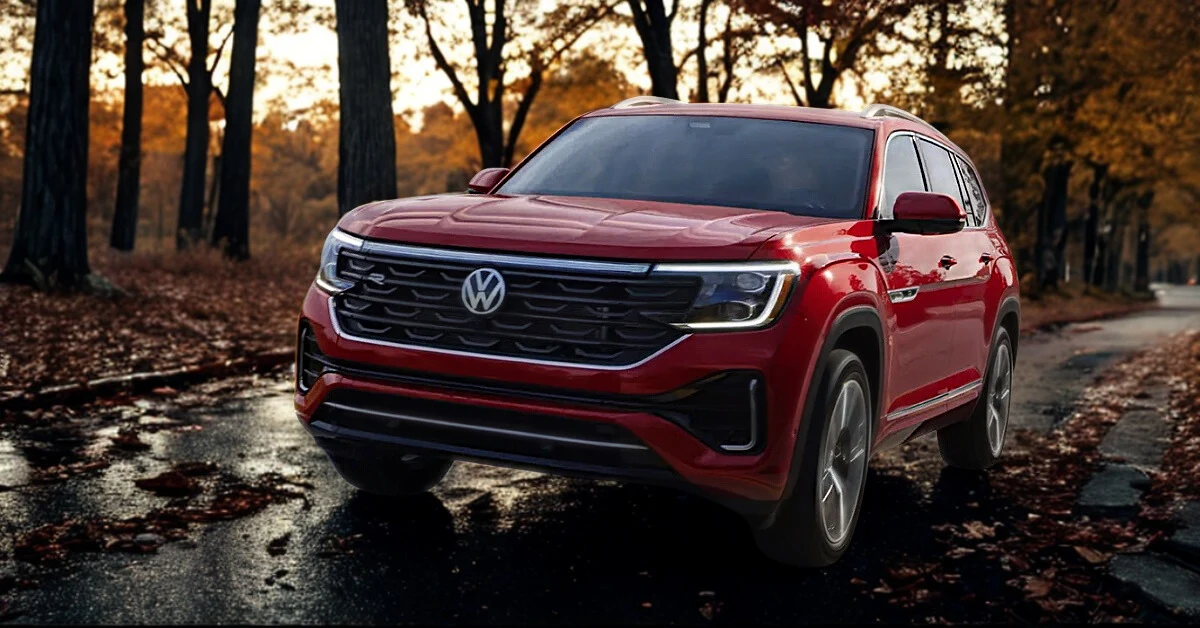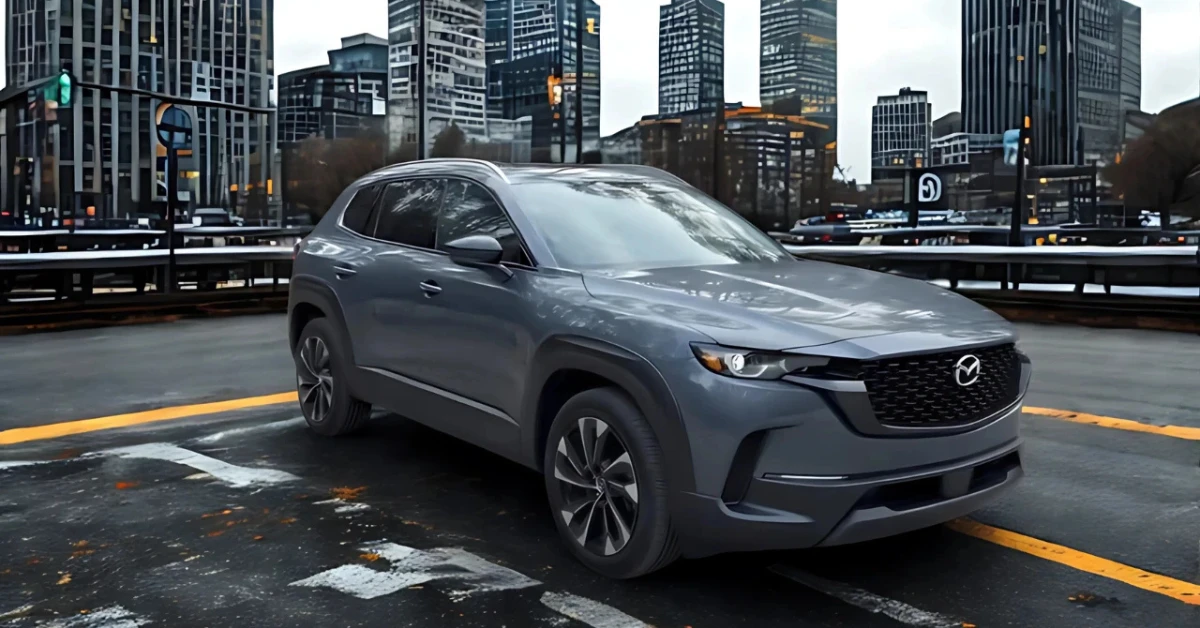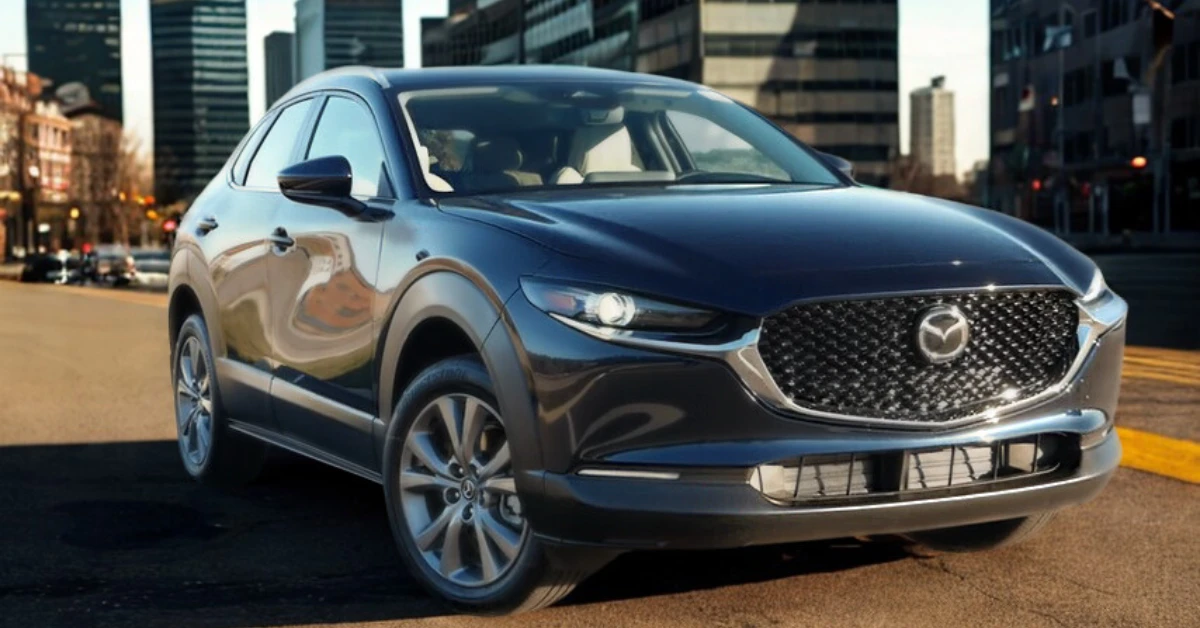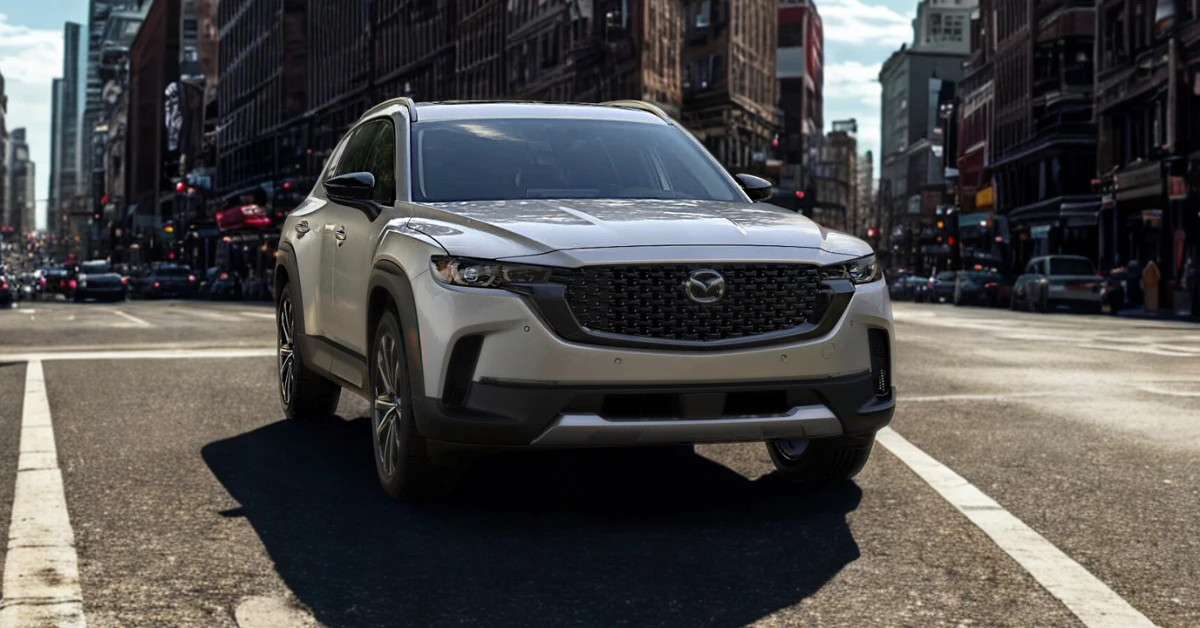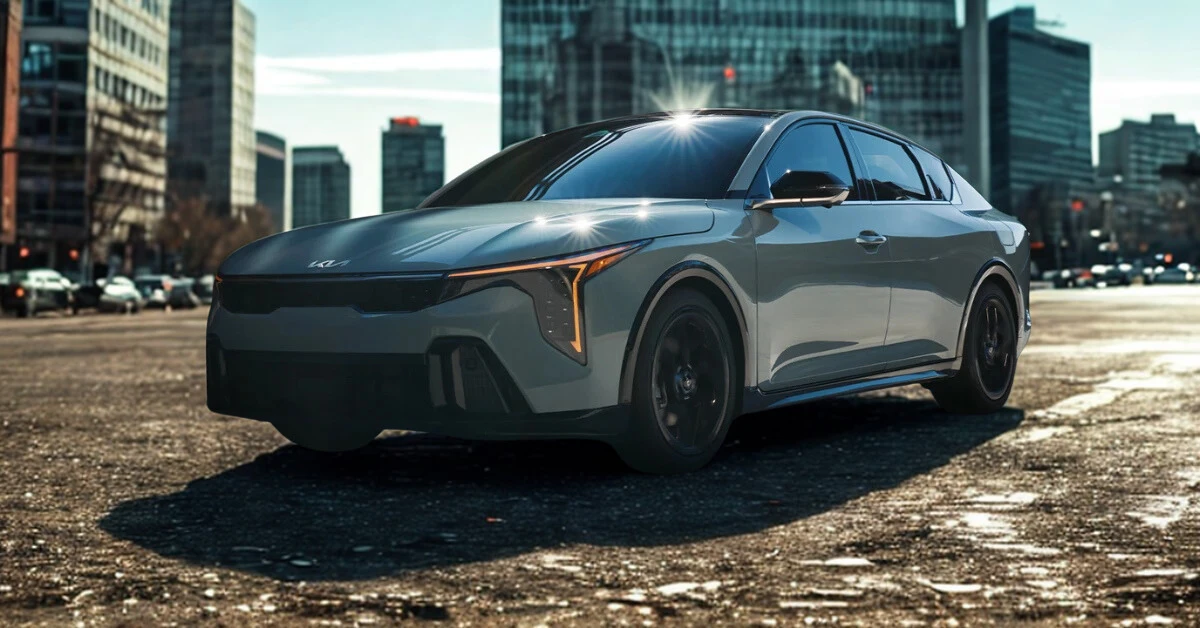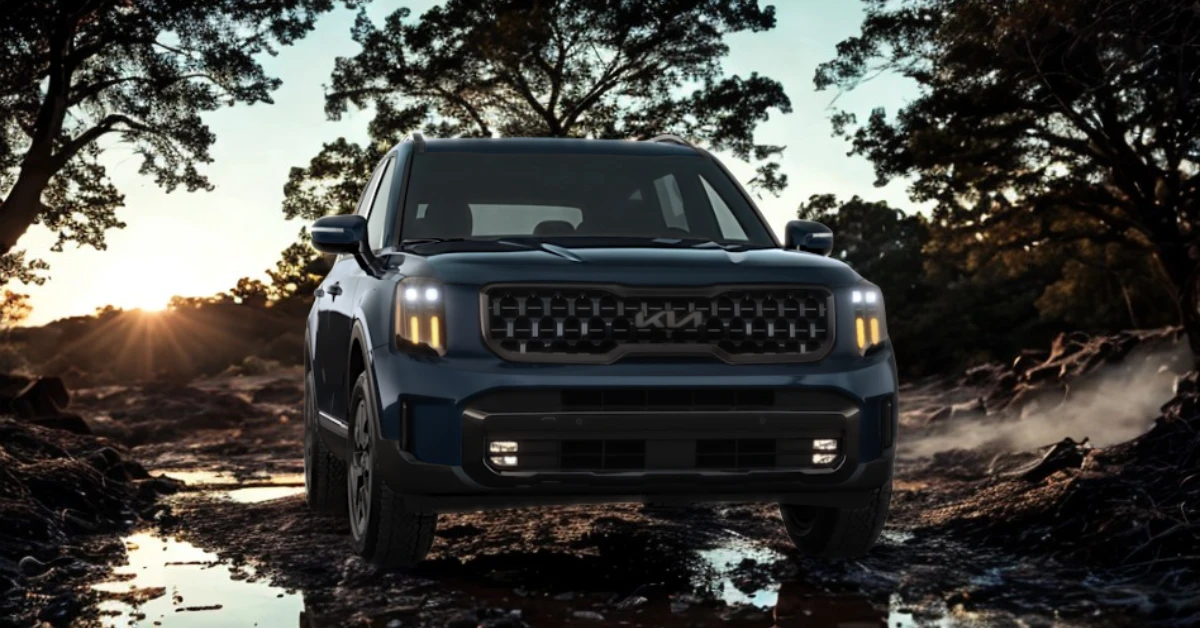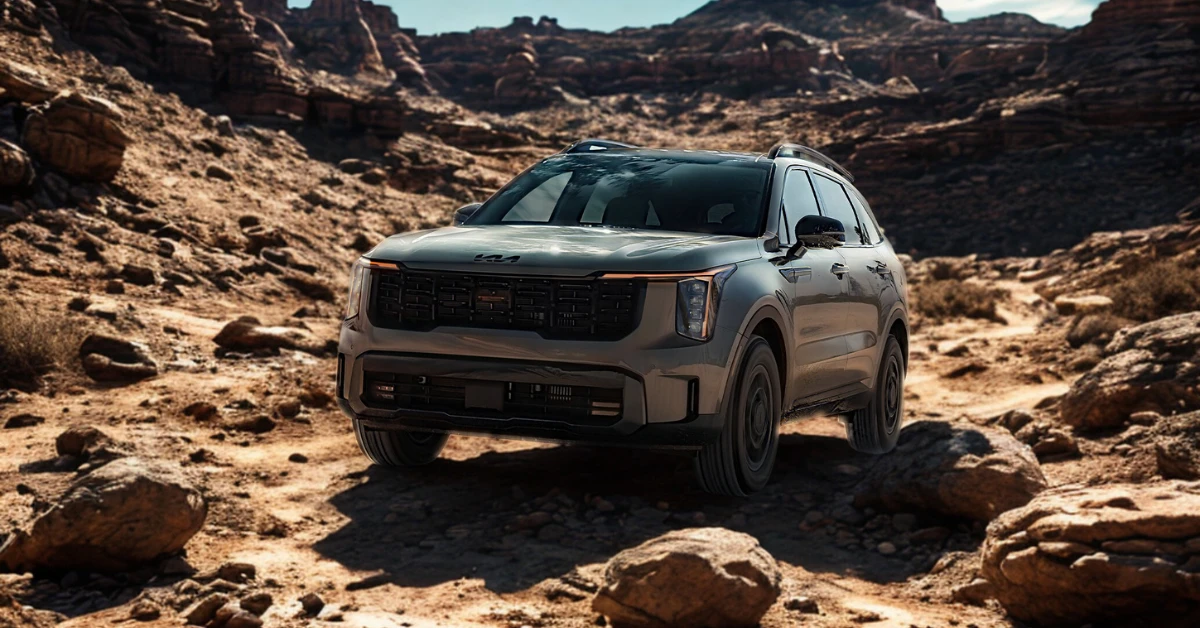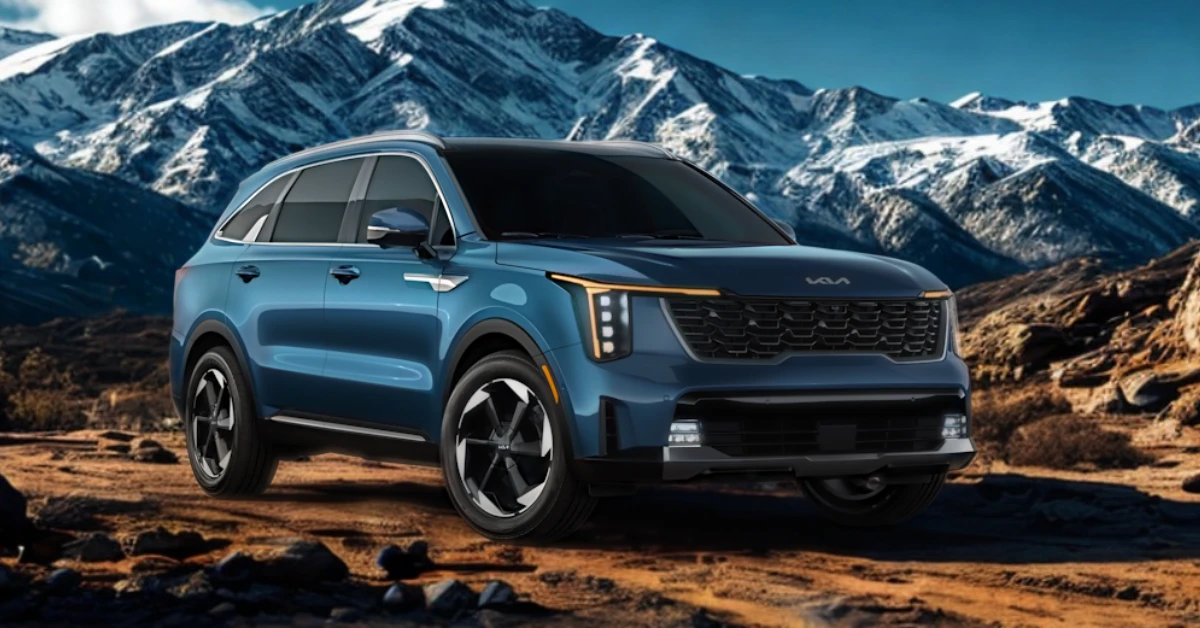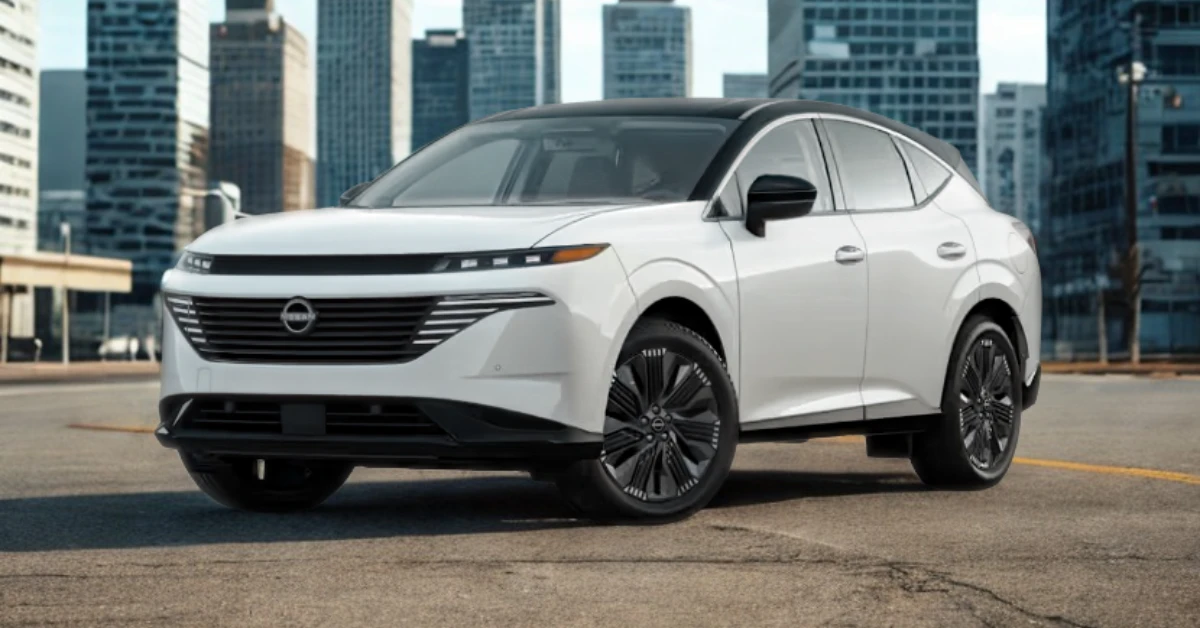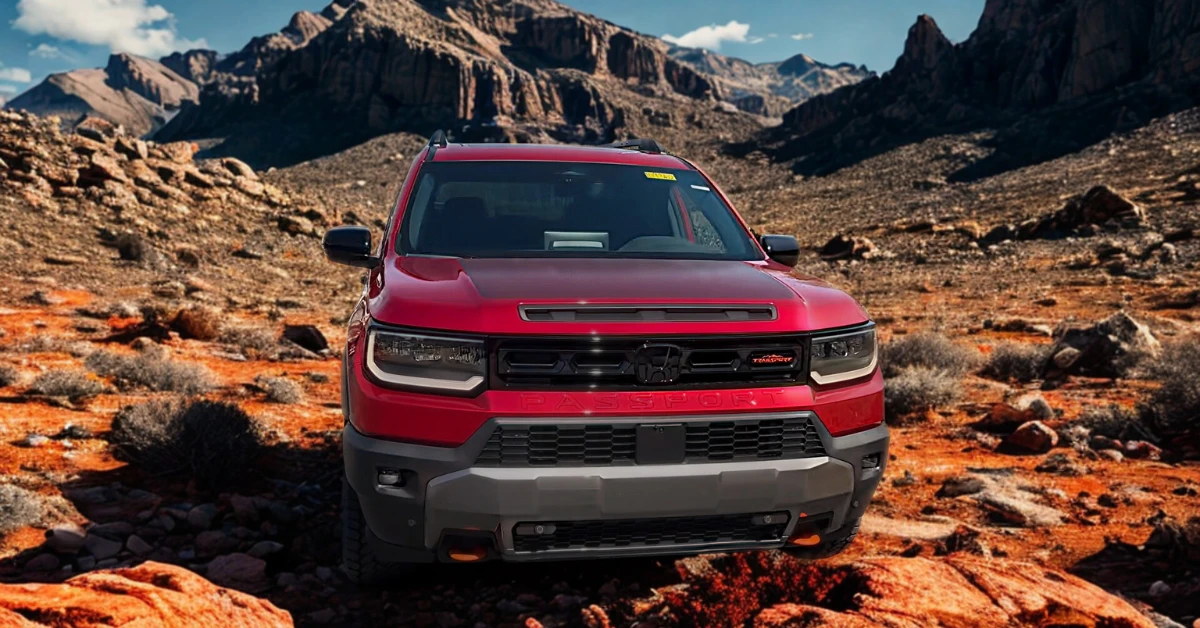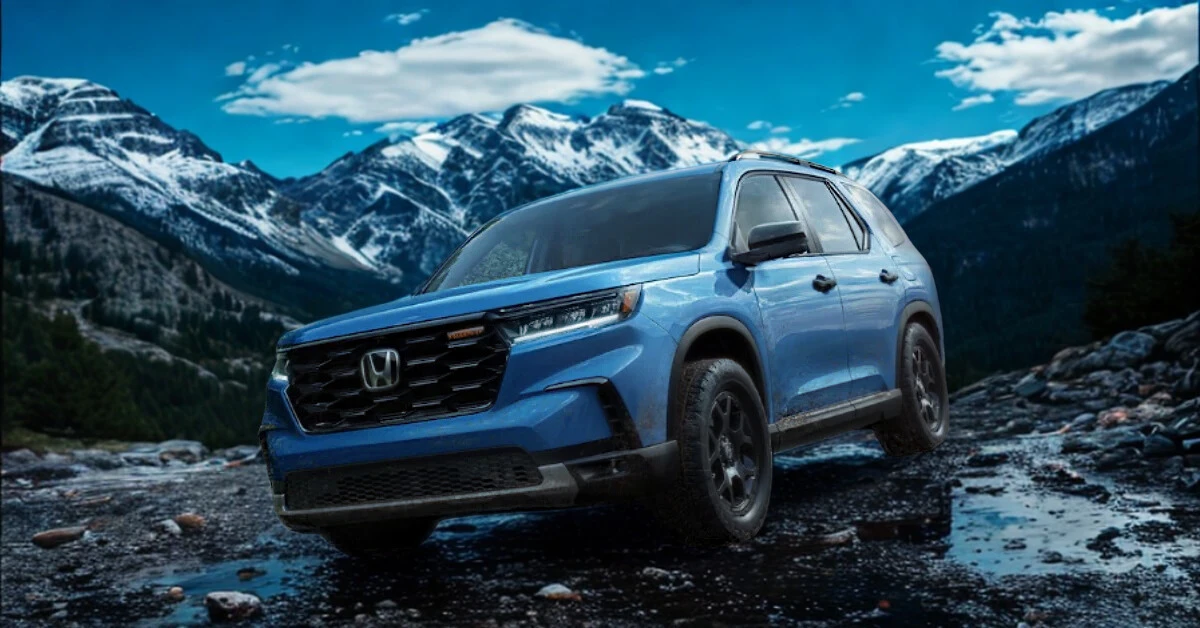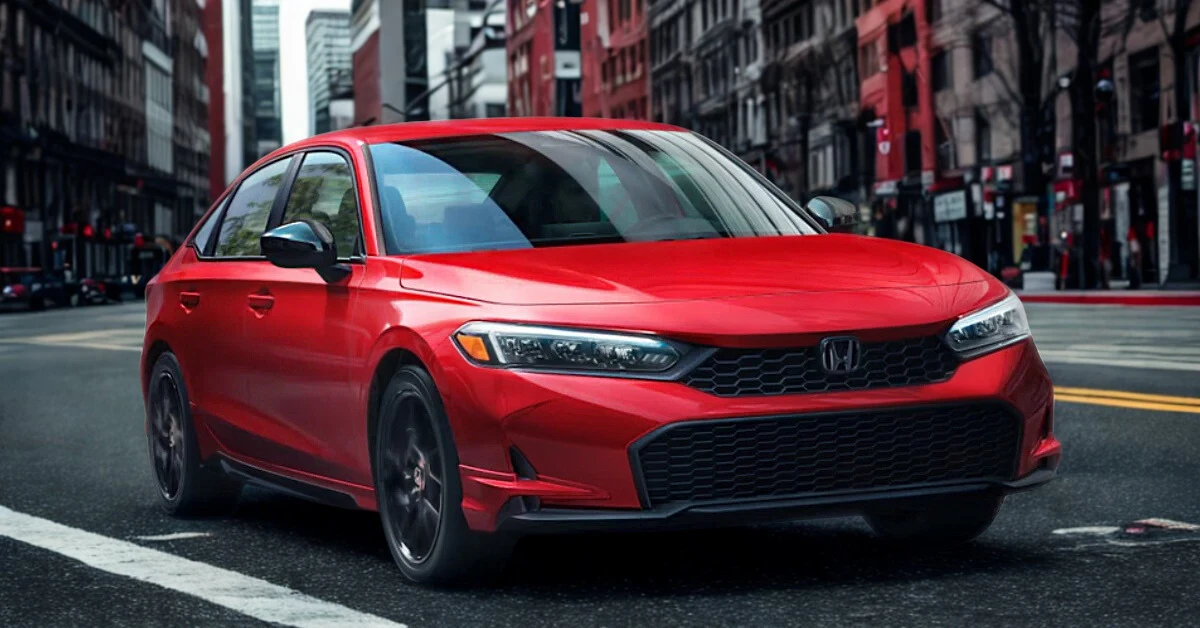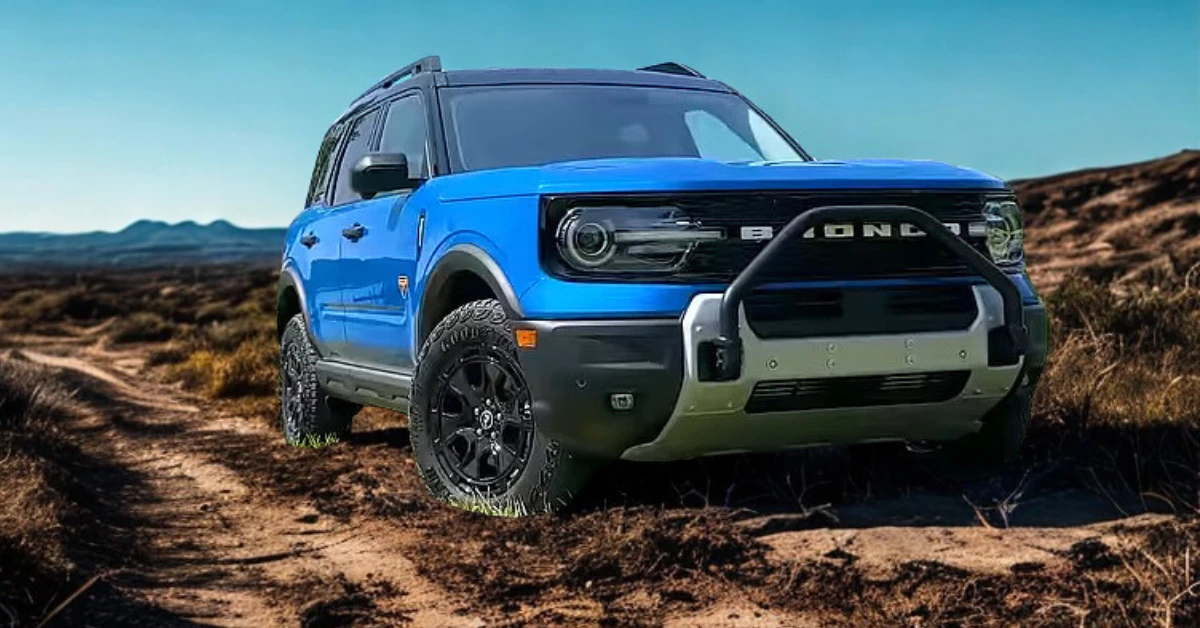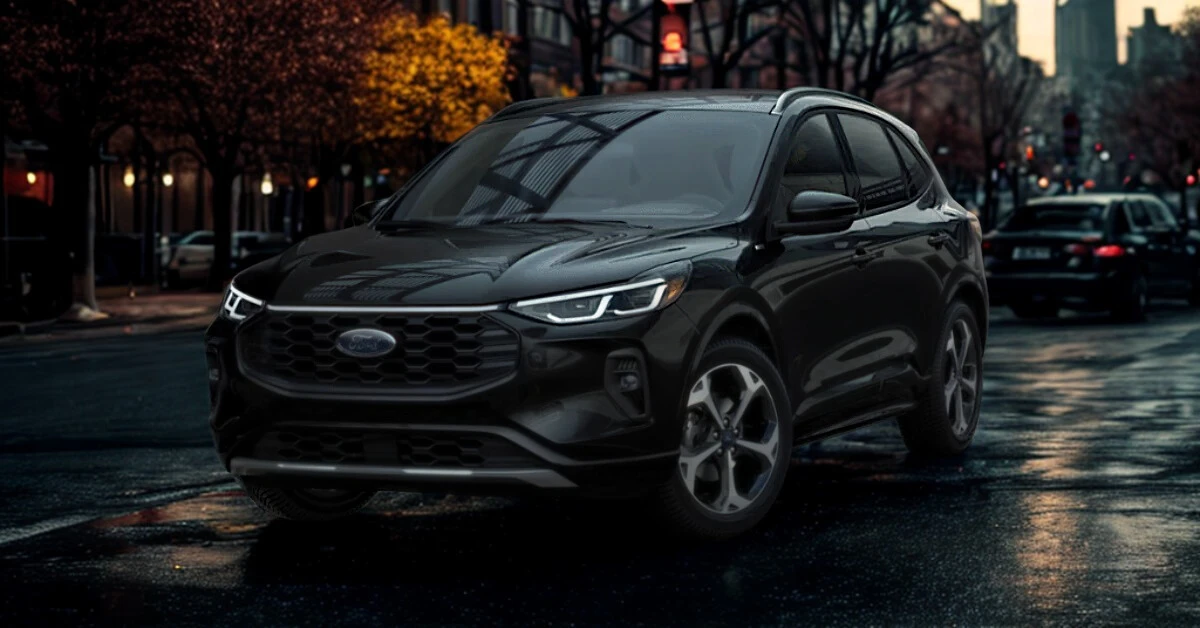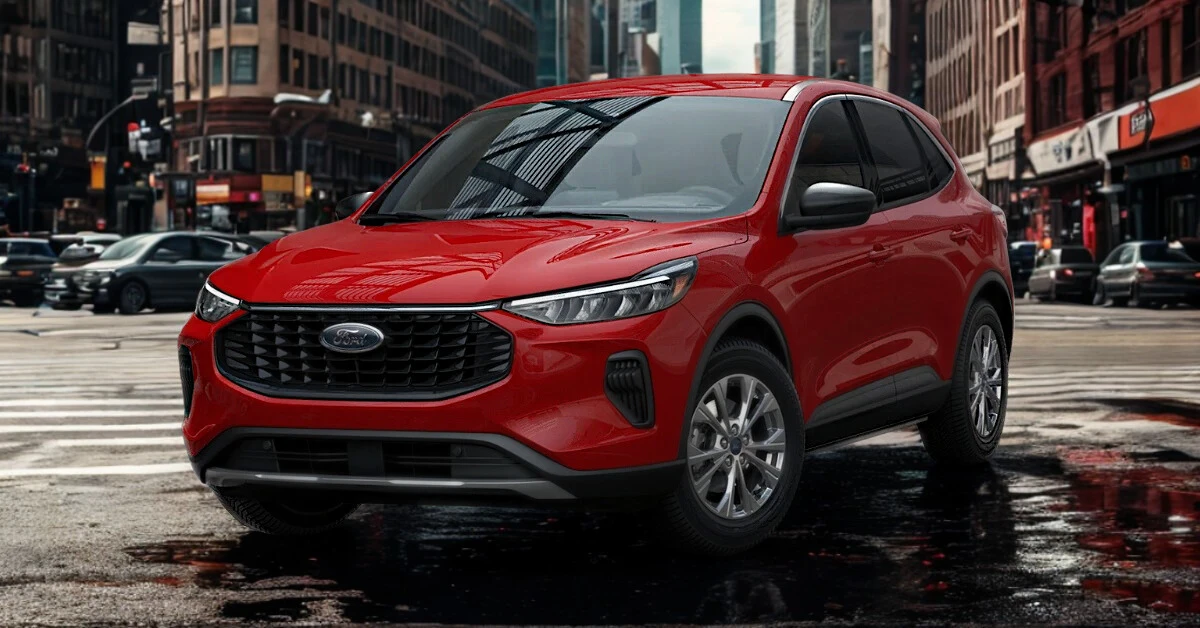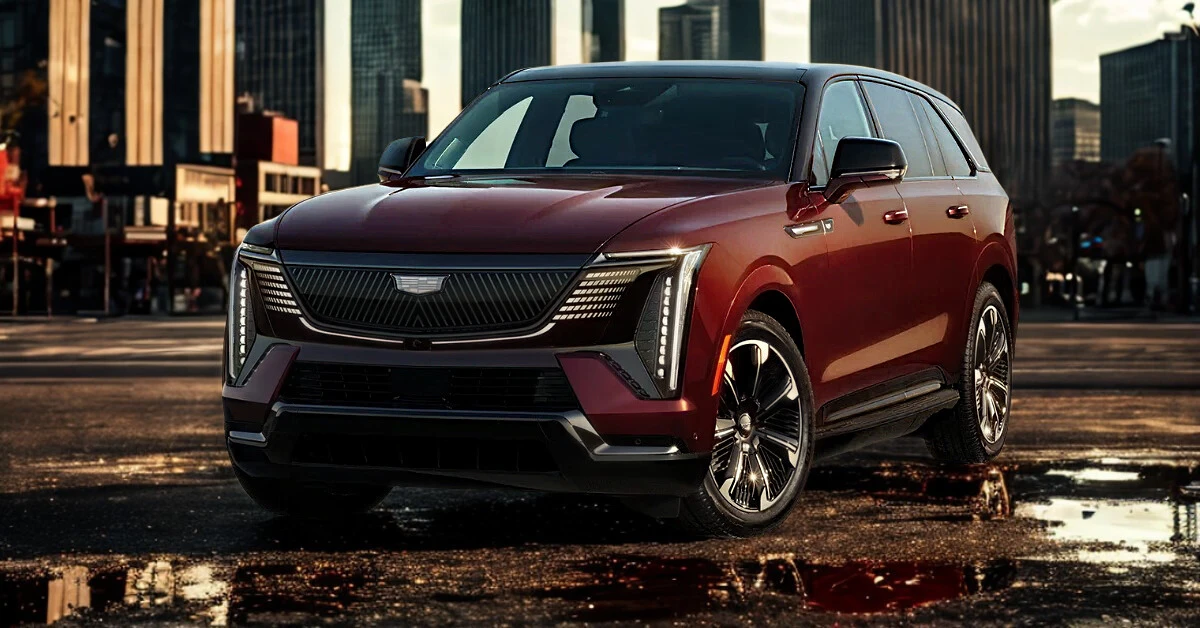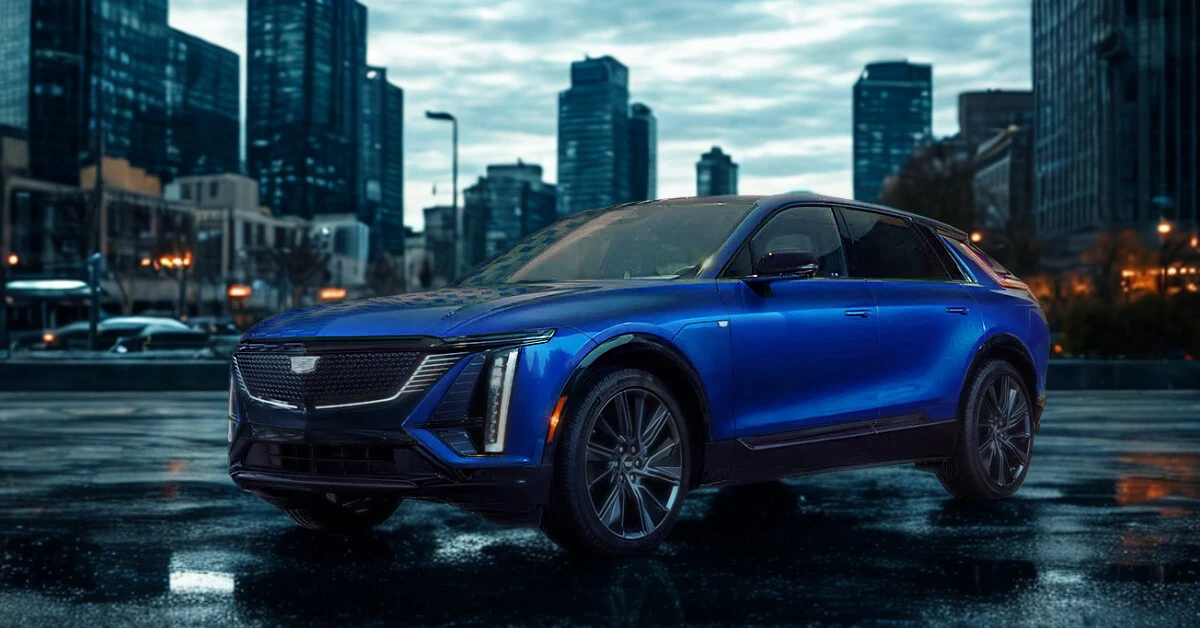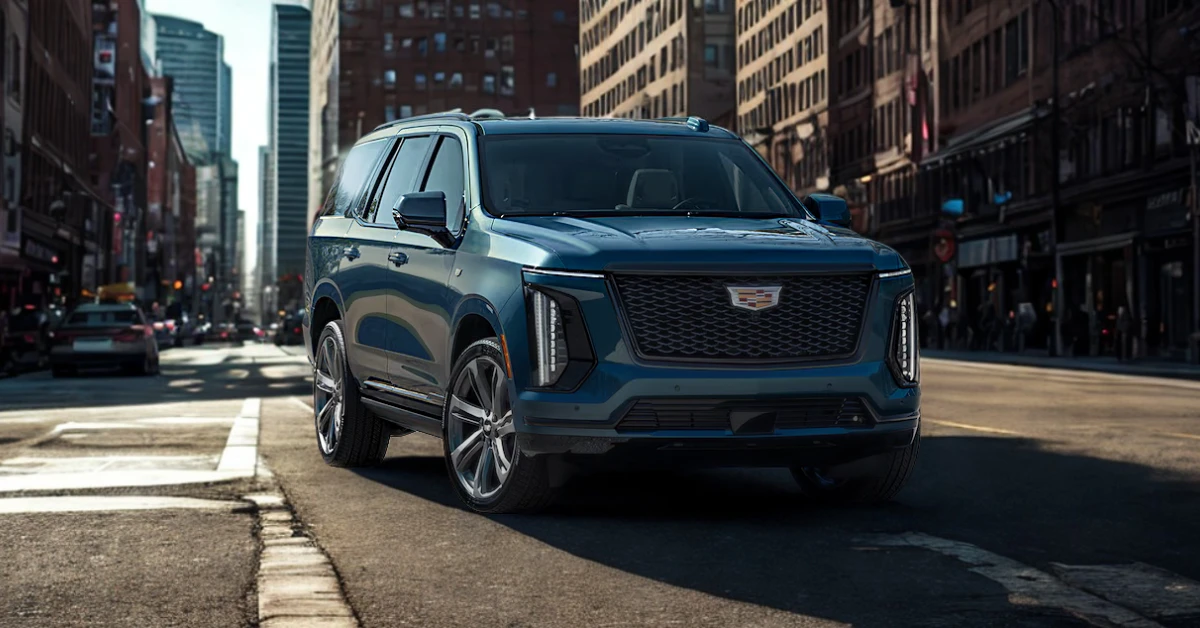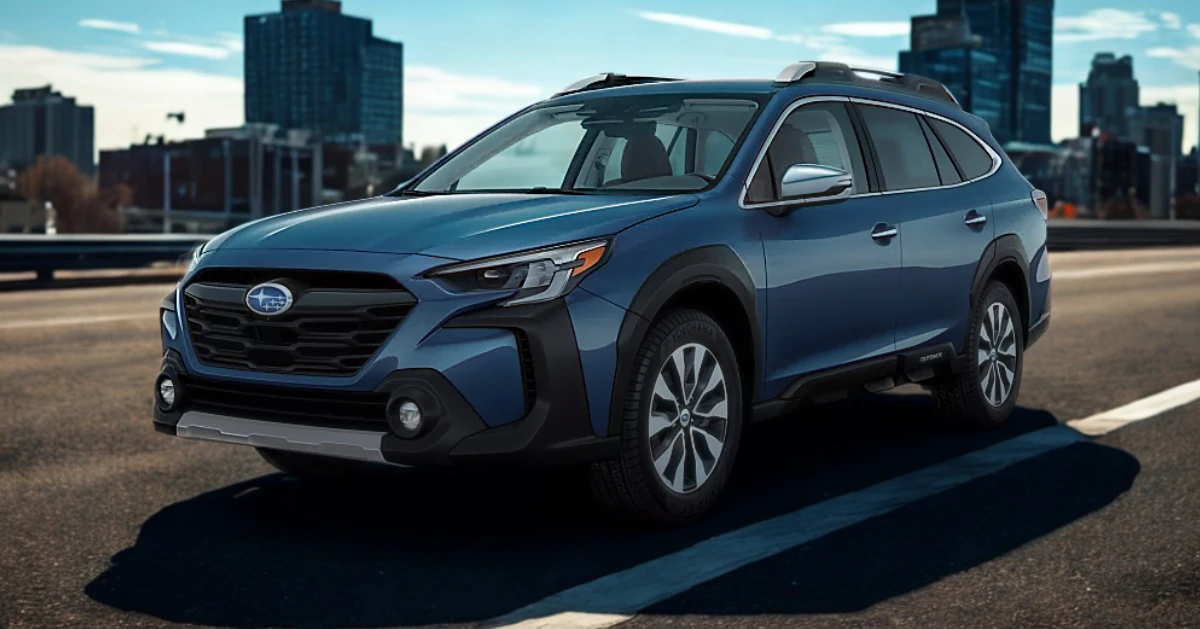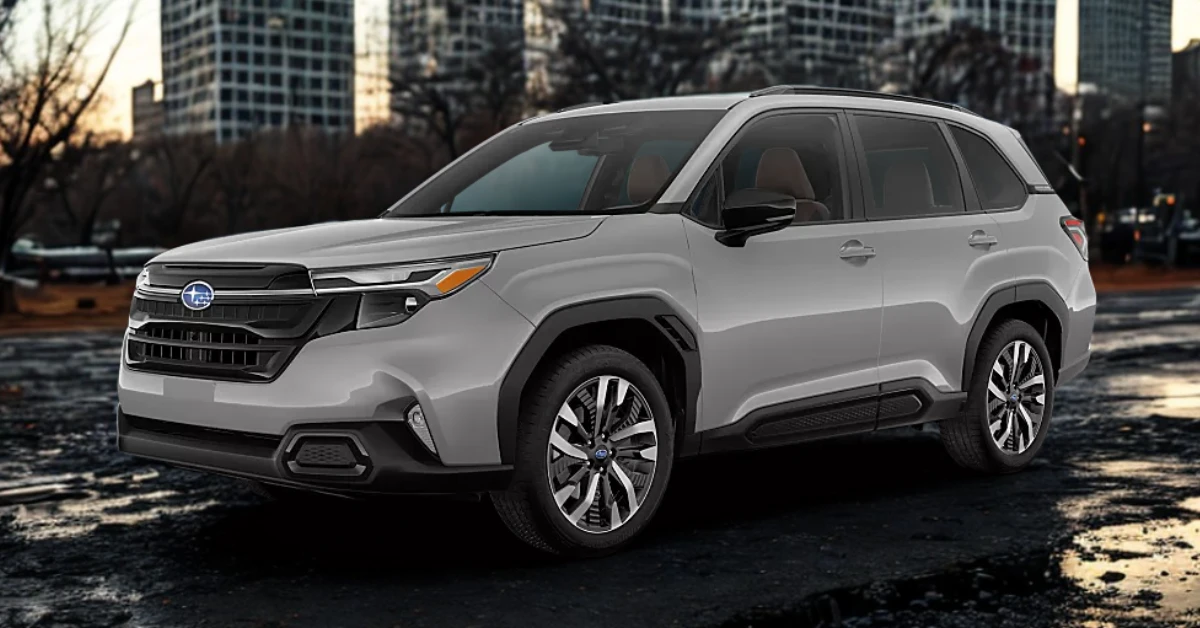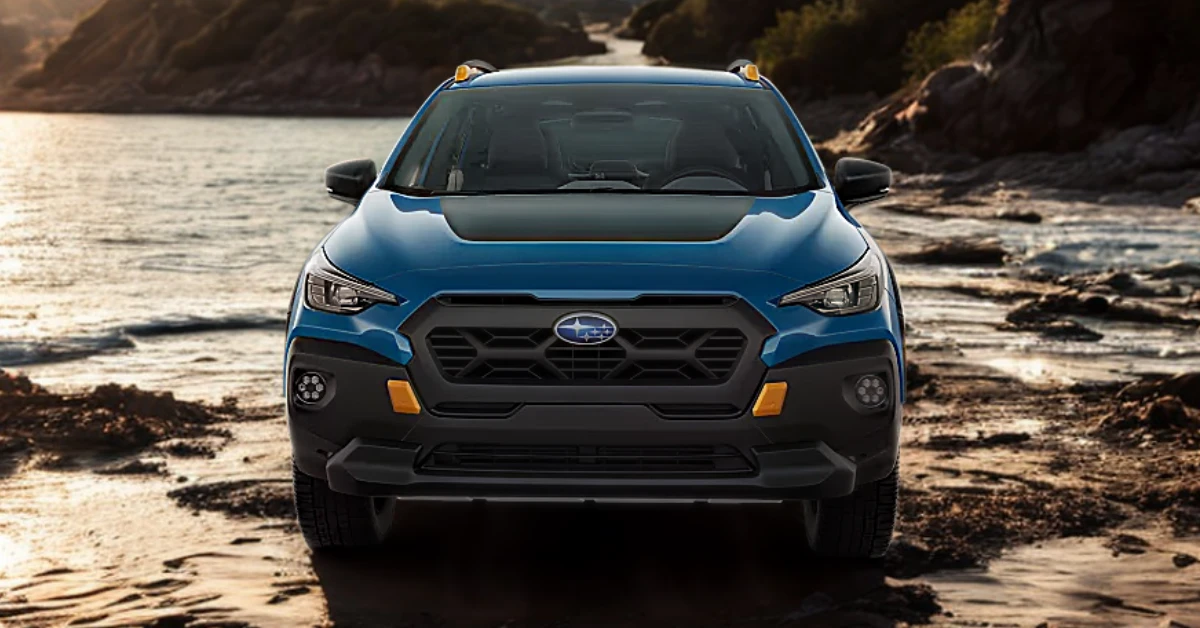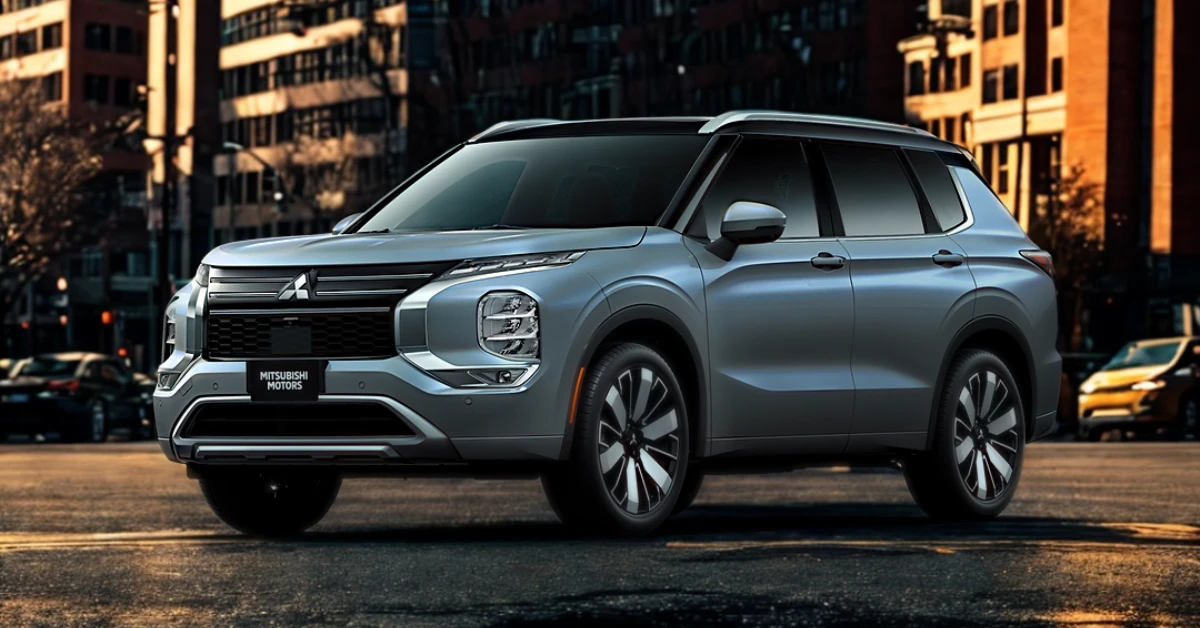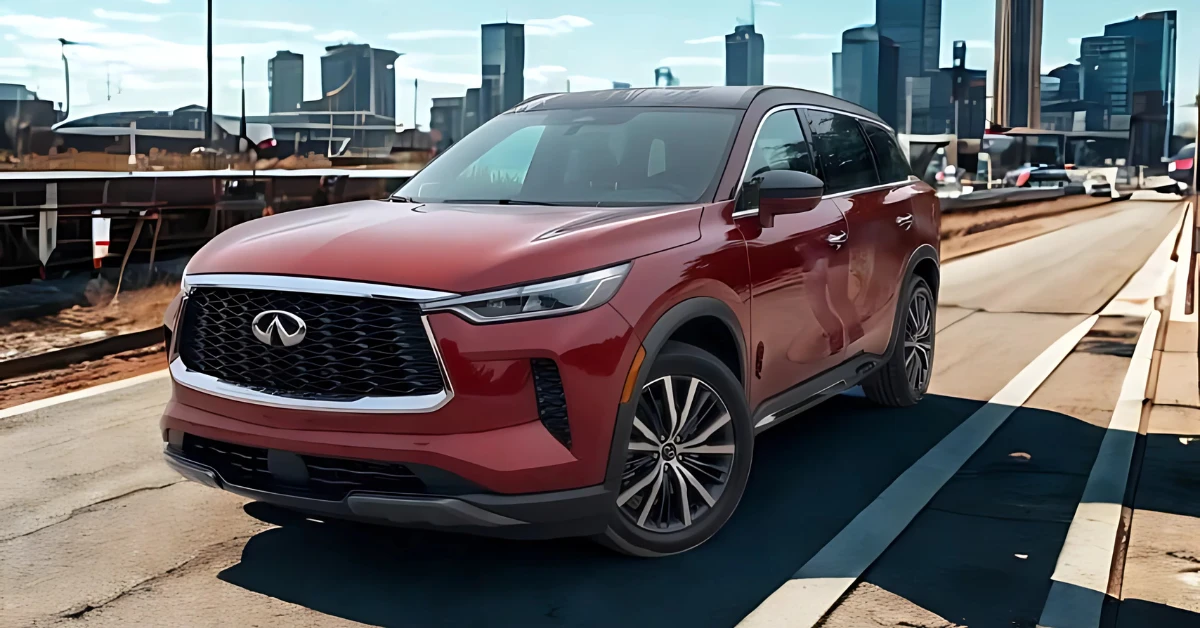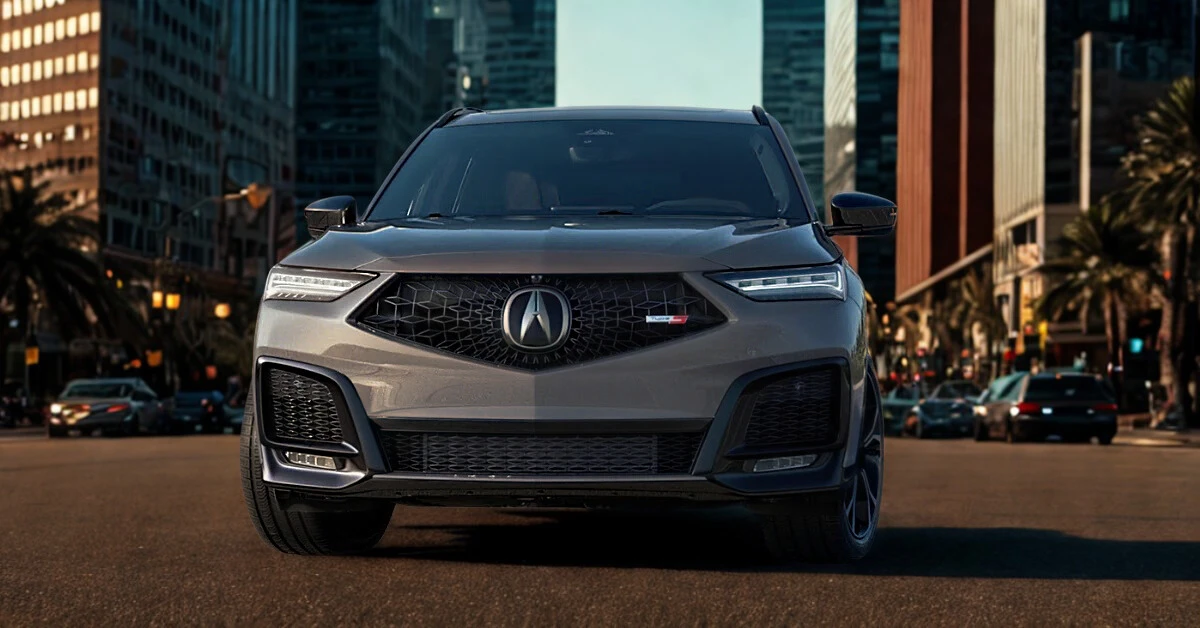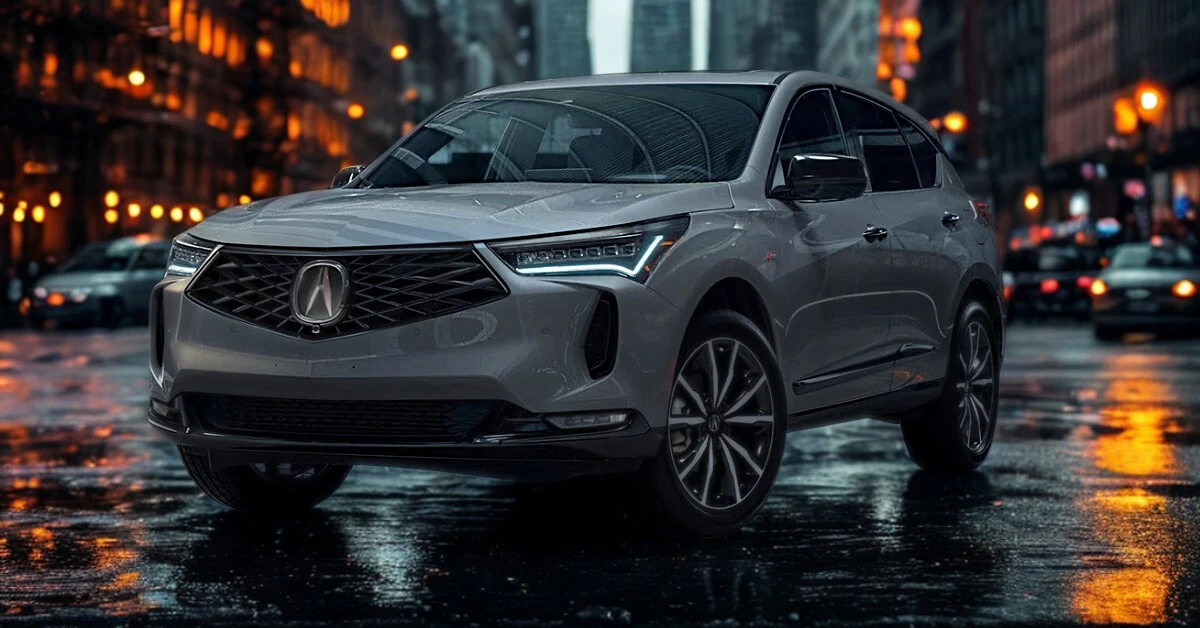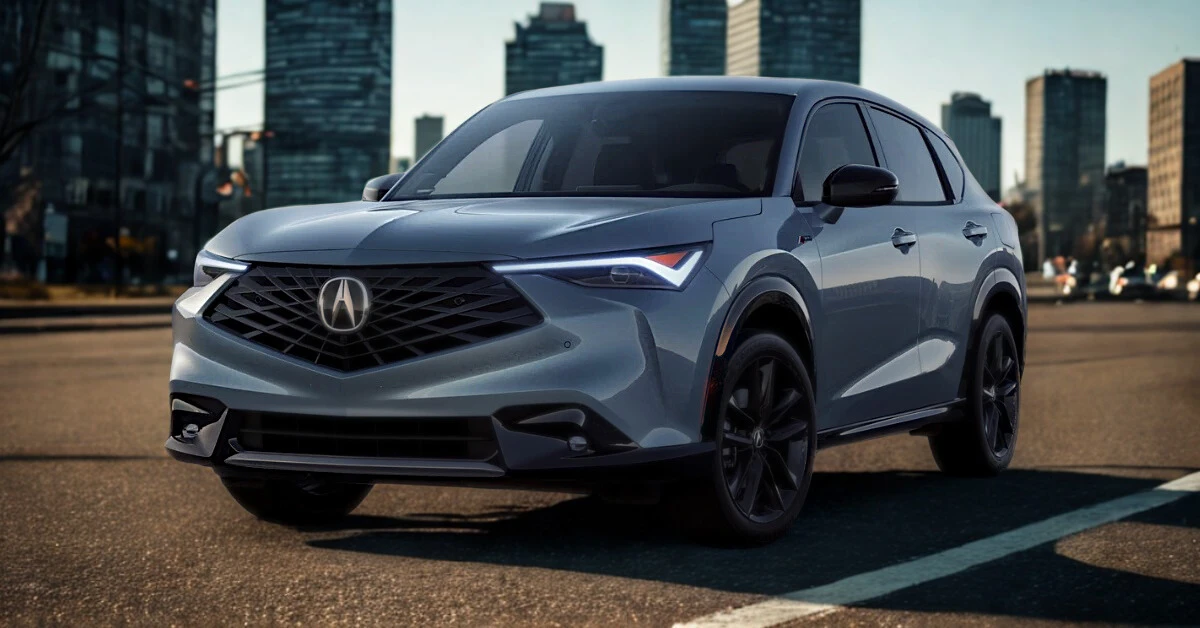2025 Ford Explorer Specifications
- POWERTRAINS
- TRIMS
- COLORS
- DIMENSIONS
| Specification | Explorer Active RWD | Explorer Active 4WD | Explorer ST-Line RWD | Explorer ST-Line 4WD | Explorer Platinum RWD | Explorer Platinum 4WD | Explorer ST RWD | Explorer ST 4WD |
|---|---|---|---|---|---|---|---|---|
| Base Price | $41,380 | $43,380 | $46,190 | $48,190 | $53,695 | $55,695 | $55,835 | $57,835 |
| Engine Type | 2.3L EcoBoost I-4 | 2.3L EcoBoost I-4 | 2.3L EcoBoost I-4 | 2.3L EcoBoost I-4 | 2.3L EcoBoost I-4 | 2.3L EcoBoost I-4 | 3.0L EcoBoost V-6 | 3.0L EcoBoost V-6 |
| Fuel Type | Premium Unleaded | Premium Unleaded | Premium Unleaded | Premium Unleaded | Premium Unleaded | Premium Unleaded | Premium Unleaded | Premium Unleaded |
| Displacement | 2.3L/140 cu. in. | 2.3L/140 cu. in. | 2.3L/140 cu. in. | 2.3L/140 cu. in. | 2.3L/140 cu. in. | 2.3L/140 cu. in. | 3.0L/183 cu. in. | 3.0L/183 cu. in. |
| Fuel System | Gasoline Direct Injection | Gasoline Direct Injection | Gasoline Direct Injection | Gasoline Direct Injection | Gasoline Direct Injection | Gasoline Direct Injection | Gasoline Direct Injection | Gasoline Direct Injection |
| Horsepower | 300 @ 5500 rpm | 300 @ 5500 rpm | 300 @ 5500 rpm | 300 @ 5500 rpm | 300 @ 5500 rpm | 300 @ 5500 rpm | 400 @ 5500 rpm | 400 @ 5500 rpm |
| Torque | 310 lb-ft @ 3500 rpm | 310 lb-ft @ 3500 rpm | 310 lb-ft @ 3500 rpm | 310 lb-ft @ 3500 rpm | 310 lb-ft @ 3500 rpm | 310 lb-ft @ 3500 rpm | 415 lb-ft @ 3500 rpm | 415 lb-ft @ 3500 rpm |
| Transmission | 10-Speed Automatic | 10-Speed Automatic | 10-Speed Automatic | 10-Speed Automatic | 10-Speed Automatic | 10-Speed Automatic | 10-Speed Automatic w/ Paddle Shifters | 10-Speed Automatic w/ Paddle Shifters |
| Drive Type | Rear-Wheel Drive | Four-Wheel Drive | Rear-Wheel Drive | Four-Wheel Drive | Rear-Wheel Drive | Four-Wheel Drive | Rear-Wheel Drive | Four-Wheel Drive |
| Fuel Economy (city/hwy/combined) | 20/29/24 mpg | 20/27/23 mpg | 20/29/24 mpg | 20/27/23 mpg | 20/29/24 mpg | 20/27/23 mpg | 18/25/21 mpg | 18/25/20 mpg |
| Fuel Tank Capacity | 18.6 gal. | 18.6 gal. | 18.6 gal. | 18.6 gal. | 18.6 gal. | 18.6 gal. | 20.2 gal. | 20.2 gal. |
| Range (city/hwy) | 372/539.4 miles | 372/502.2 miles | 372/539.4 miles | 372/502.2 miles | 372/539.4 miles | 372/502.2 miles | 363.6/505 miles | 363.6/505 miles |
| EPA Greenhouse Gas Score | 5.0 | 5.0 | 5.0 | 5.0 | 5.0 | 5.0 | 4.0 | 4.0 |
| CO2 Emissions | 7.3 tons/year | 7.6 tons/year | 7.3 tons/year | 7.6 tons/year | 7.3 tons/year | 7.6 tons/year | 8.3 tons/year | 8.9 tons/year |
| Max Towing Capacity | 5,000 lbs | 5,000 lbs | 5,000 lbs | 5,000 lbs | 5,000 lbs | 5,000 lbs | 5,000 lbs | 5,000 lbs |
| Curb Weight | 4,344 lbs | 4,457 lbs | 4,344 lbs | 4,457 lbs | 4,344 lbs | 4,457 lbs | 4,670 lbs | 4,766 lbs |
| Suspension Type (F/R) | Strut / Multi-Link | Strut / Multi-Link | Strut / Multi-Link | Strut / Multi-Link | Strut / Multi-Link | Strut / Multi-Link | Strut / Multi-Link | Strut / Multi-Link |
| Suspension Tuning | Standard | Standard | Standard | Standard | Standard | Standard | Sport Tuned | Sport Tuned |
| Special Features | Auto Start-Stop | Auto Start-Stop, Hill Descent Control | Auto Start-Stop, Terrain Management System | Auto Start-Stop, Terrain Management System | Auto Start-Stop, Adaptive Headlamps | Auto Start-Stop, Adaptive Headlamps | Auto Start-Stop, Performance-Tuned Exhaust | Auto Start-Stop, Performance-Tuned Exhaust |
Interior Features
| Feature | Explorer Active RWD | Explorer Active 4WD | Explorer ST-Line RWD | Explorer ST-Line 4WD | Explorer Platinum RWD | Explorer Platinum 4WD | Explorer ST RWD | Explorer ST 4WD |
|---|---|---|---|---|---|---|---|---|
| Seating Capacity | 6 | 6 | 7 | 7 | 6 | 6 | 6 | 6 |
| Seating Material | Unique Heated Cloth | Unique Heated Cloth | Heated Unique Cloth | Heated Unique Cloth | ActiveX Trimmed | ActiveX Trimmed | Heated/Ventilated Miko Sport | Heated/Ventilated Miko Sport |
| Front Seats | 10-way Power Driver, 4-way Power Passenger | 10-way Power Driver, 4-way Power Passenger | 10-way Power Driver, 8-way Power Passenger | 8-way Power Driver, 6-way Power Passenger | 8-way Power Driver w/Memory, 6-way Power Passenger | 8-way Power Driver w/Memory, 6-way Power Passenger | 8-way Power Driver w/Memory, 6-way Power Passenger | 8-way Power Driver w/Memory, 6-way Power Passenger |
| 2nd Row Seats | Captain’s Chairs | Captain’s Chairs | 35-30-35 Split-Bench | 35-30-35 Split-Bench | Captain’s Chairs | Captain’s Chairs | Captain’s Chairs | Captain’s Chairs |
| 3rd Row Seats | 50-50 Split | 50-50 Split | 50-50 Split | 50-50 Split | 50-50 Split | 50-50 Split | 50-50 Split | 50-50 Split |
| Steering Wheel | Leather | Leather | Heated Leather | Heated Leather | Heated Leather | Heated Leather | Sport Heated Leather | Sport Heated Leather |
| Climate Control | Voice Activated Dual Zone | Voice Activated Dual Zone | Voice Activated Dual Zone | Voice Activated Dual Zone | Voice Activated Dual Zone | Voice Activated Dual Zone | Voice Activated Dual Zone w/Rear Controls | Voice Activated Dual Zone w/Rear Controls |
| Interior Trim | Piano Black/Metal-Look | Piano Black/Metal-Look | Cloth/Metal-Look | Cloth/Metal-Look | Simulated Wood/Metal-Look | Simulated Wood/Metal-Look | Cloth/Metal-Look | Cloth/Metal-Look |
Technology
| Feature | Explorer Active RWD | Explorer Active 4WD | Explorer ST-Line RWD | Explorer ST-Line 4WD | Explorer Platinum RWD | Explorer Platinum 4WD | Explorer ST RWD | Explorer ST 4WD |
|---|---|---|---|---|---|---|---|---|
| Touchscreen | 13.2″ Color LCD | 13.2″ Color LCD | 13.2″ Color LCD | 13.2″ Color LCD | 13.2″ Color LCD | 13.2″ Color LCD | 13.2″ Color LCD | 13.2″ Color LCD |
| Audio System | AM/FM Stereo, 6 speakers | AM/FM Stereo, 6 speakers | B&O Sound System, 10 speakers | B&O Sound System, 10 speakers | B&O Sound System, 14 speakers | B&O Sound System, 14 speakers | B&O Sound System, 10 speakers | B&O Sound System, 14 speakers |
| Apple CarPlay/Android Auto | Wireless | Wireless | Wireless | Wireless | Wireless | Wireless | Wireless | Wireless |
| Voice Recognition | Alexa Built-in | Alexa Built-in | Alexa Built-in | Alexa Built-in | Alexa Built-in | Alexa Built-in | Alexa Built-in | Alexa Built-in |
| Navigation | Standard | Standard | Standard | Standard | Standard | Standard | Standard | Standard |
| Wi-Fi Hotspot | Standard | Standard | Standard | Standard | Standard | Standard | Standard | Standard |
| Bluetooth | Standard | Standard | Standard | Standard | Standard | Standard | Standard | Standard |
| SiriusXM | 3-month subscription | 3-month subscription | 3-month subscription | 3-month subscription | 3-month subscription | 3-month subscription | 3-month subscription | 3-month subscription |
| USB Ports | Standard | Standard | Standard | Standard | Standard | Standard | Standard | Standard |
| Digital Instrument Cluster | Standard | Standard | Standard w/Redundant Digital Speedometer | Standard w/Redundant Digital Speedometer | Standard w/Redundant Digital Speedometer | Standard w/Redundant Digital Speedometer | Standard w/Redundant Digital Speedometer | Standard w/Redundant Digital Speedometer |
| Interior 120V AC Power Outlet | Not Standard | Not Standard | Not Standard | Not Standard | Standard | Standard | Standard | Standard |
Safety & Driver Assistance
| Feature | Explorer Active RWD | Explorer Active 4WD | Explorer ST-Line RWD | Explorer ST-Line 4WD | Explorer Platinum RWD | Explorer Platinum 4WD | Explorer ST RWD | Explorer ST 4WD |
|---|---|---|---|---|---|---|---|---|
| Adaptive Cruise Control | With Traffic Stop-Go | With Traffic Stop-Go | With Traffic Stop-Go | With Traffic Stop-Go | With Traffic Stop-Go | With Traffic Stop-Go | With Traffic Stop-Go | With Traffic Stop-Go |
| Pre-Collision Assist | With Pedestrian Detection | With Pedestrian Detection | With Pedestrian Detection | With Pedestrian Detection | With Pedestrian Detection | With Pedestrian Detection | With Pedestrian Detection | With Pedestrian Detection |
| Lane Keeping Assist | Standard | Standard | Standard | Standard | Standard | Standard | Standard | Standard |
| Lane Departure Warning | Standard | Standard | Standard | Standard | Standard | Standard | Standard | Standard |
| Blind Spot Information | Standard | Standard | Standard | Standard | Standard | Standard | Standard | Standard |
| Rear Cross-Traffic Braking | Standard | Standard | Standard | Standard | Standard | Standard | Standard | Standard |
| Front Cross Traffic Mitigation | Standard | Standard | Standard | Standard | Standard | Standard | Standard | Standard |
| Driver Monitoring Alert | Standard | Standard | Standard | Standard | Standard | Standard | Standard | Standard |
| Evasion Assist | Standard | Standard | Standard | Standard | Standard | Standard | Standard | Standard |
| Front Parking Sensors | Not Standard | Not Standard | Standard | Standard | Standard | Standard | Standard | Standard |
| Rear Parking Sensors | Standard | Standard | Standard | Standard | Standard | Standard | Standard | Standard |
| Surround View Camera | Not Standard | Not Standard | Aerial View Camera System | Aerial View Camera System | Aerial View Camera System | Aerial View Camera System | Aerial View Camera System | Aerial View Camera System |
| Back-Up Camera | With Washer | With Washer | With Washer | With Washer | With Washer | With Washer | With Washer | With Washer |
| Front Camera | Not Standard | Not Standard | With Washer | With Washer | With Washer | With Washer | With Washer | With Washer |
| BlueCruise | Not Standard | Not Standard | 90-day free trial | 90-day free trial | 90-day free trial | 90-day free trial | 90-day free trial | 90-day free trial |
| Airbags | Front, Side, Curtain, Knee | Front, Side, Curtain, Knee | Front, Side, Curtain, Knee | Front, Side, Curtain, Knee | Front, Side, Curtain, Knee | Front, Side, Curtain, Knee | Front, Side, Curtain, Knee | Front, Side, Curtain, Knee |
Exterior Features
| Feature | Explorer Active RWD | Explorer Active 4WD | Explorer ST-Line RWD | Explorer ST-Line 4WD | Explorer Platinum RWD | Explorer Platinum 4WD | Explorer ST RWD | Explorer ST 4WD |
|---|---|---|---|---|---|---|---|---|
| Sunroof | Not Standard | Not Standard | Not Standard | Not Standard | Express Open/Close Sliding & Tilting | Express Open/Close Sliding & Tilting | Not Standard | Not Standard |
| Power Liftgate | Standard | Standard | Standard | Standard | Standard | Standard | Standard | Standard |
| Side Mirrors | Black, Power, Heated | Black, Power, Heated | Black, Power, Heated | Black, Power, Heated | Black, Power, Heated w/Auto Dimming & Power Folding | Black, Power, Heated w/Auto Dimming & Power Folding | Black, Power, Heated w/Auto Dimming & Power Folding | Black, Power, Heated w/Auto Dimming & Power Folding |
| LED Headlights | Auto On/Off | Auto On/Off | Auto On/Off | Auto On/Off | Auto On/Off with Adaptive | Auto On/Off with Adaptive | Auto On/Off | Auto On/Off |
| Auto High-Beam | Standard | Standard | Standard | Standard | Standard | Standard | Standard | Standard |
| Fog Lights | Not Standard | Not Standard | Standard | Standard | Standard | Standard | Standard | Standard |
| Wipers | Speed Sensitive Variable Intermittent | Speed Sensitive Variable Intermittent | Speed Sensitive Rain Detecting | Speed Sensitive Rain Detecting | Speed Sensitive Rain Detecting | Speed Sensitive Rain Detecting | Speed Sensitive Variable Intermittent | Speed Sensitive Variable Intermittent |
| Body Side Cladding | Black | Black | Black | Black | Metal-Look Insert | Metal-Look Insert | Black | Black |
| Grille | Black w/Chrome Accents | Black w/Chrome Accents | Black | Black | Black w/Metal-Look Accents | Black w/Metal-Look Accents | Black | Black |
| Window Trim | Black | Black | Black | Black | Black | Black | Black | Black |
| Exhaust | Quasi-Dual Stainless Steel | Quasi-Dual Stainless Steel | Quasi-Dual Stainless Steel | Quasi-Dual Stainless Steel | Dual w/Chrome Finisher | Dual w/Chrome Finisher | Dual w/Chrome Finisher | Dual w/Chrome Finisher |
Suspension & Chassis
| Feature | Explorer Active RWD | Explorer Active 4WD | Explorer ST-Line RWD | Explorer ST-Line 4WD | Explorer Platinum RWD | Explorer Platinum 4WD | Explorer ST RWD | Explorer ST 4WD |
|---|---|---|---|---|---|---|---|---|
| Front Suspension | Strut | Strut | Strut | Strut | Strut | Strut | Strut | Strut |
| Rear Suspension | Multi-Link | Multi-Link | Multi-Link | Multi-Link | Multi-Link | Multi-Link | Multi-Link | Multi-Link |
| Suspension Tuning | Standard | Standard | Standard | Standard | Standard | Standard | Sport Tuned | Sport Tuned |
| Front Anti-Roll Bar | Standard | Standard | Standard | Standard | Standard | Standard | Standard | Standard |
| Rear Anti-Roll Bar | Standard | Standard | Standard | Standard | Standard | Standard | Standard | Standard |
| Power Steering | Electric Power-Assist | Electric Power-Assist | Electric Power-Assist | Electric Power-Assist | Electric Power-Assist | Electric Power-Assist | Electric Power-Assist | Electric Power-Assist |
| Brake Type | 4-Wheel Disc w/ABS | 4-Wheel Disc w/ABS | 4-Wheel Disc w/ABS | 4-Wheel Disc w/ABS | 4-Wheel Disc w/ABS | 4-Wheel Disc w/ABS | 4-Wheel Disc w/ABS | 4-Wheel Disc w/ABS |
| Front Brake Rotors | 13.6 in. | 13.6 in. | 13.6 in. | 13.6 in. | 13.6 in. | 13.6 in. | 13.6 in. | 13.6 in. |
| Rear Brake Rotors | 12.6 in. | 12.6 in. | 12.6 in. | 12.6 in. | 12.6 in. | 12.6 in. | 12.8 in. | 12.8 in. |
| Electric Parking Brake | Standard | Standard | Standard | Standard | Standard | Standard | Standard | Standard |
| Brake Assist | Standard | Standard | Standard | Standard | Standard | Standard | Standard | Standard |
Wheels & Tires
| Feature | Explorer Active RWD | Explorer Active 4WD | Explorer ST-Line RWD | Explorer ST-Line 4WD | Explorer Platinum RWD | Explorer Platinum 4WD | Explorer ST RWD | Explorer ST 4WD |
|---|---|---|---|---|---|---|---|---|
| Wheels | 18″ x 7.5″ Aluminum | 18″ x 7.5″ Aluminum | 20″ x 8″ Aluminum | 20″ x 8″ Aluminum | 20″ x 8″ Aluminum | 20″ x 8″ Aluminum | 21″ x 9″ Aluminum | 21″ x 9″ Aluminum |
| Wheel Finish | Sparkle Silver-Painted | Sparkle Silver-Painted | Ebony-Painted Machined | Ebony-Painted Machined | Luster Nickel-Painted | Luster Nickel-Painted | Magnetite-Painted | Magnetite-Painted |
| Tires | P255/65HR18 | P255/65HR18 | P255/55VR20 | P255/55VR20 | P255/55VR20 | P255/55VR20 | P275/45WR21 | P275/45WR21 |
| Spare Tire Type | Tire Mobility Kit | Tire Mobility Kit | Tire Mobility Kit | Tire Mobility Kit | Tire Mobility Kit | Tire Mobility Kit | Tire Mobility Kit | Tire Mobility Kit |
Cargo Capacity
| Feature | Explorer Active RWD | Explorer Active 4WD | Explorer ST-Line RWD | Explorer ST-Line 4WD | Explorer Platinum RWD | Explorer Platinum 4WD | Explorer ST RWD | Explorer ST 4WD |
|---|---|---|---|---|---|---|---|---|
| Behind 3rd Row | 16.3 cu. ft. | 16.3 cu. ft. | 16.3 cu. ft. | 16.3 cu. ft. | 16.3 cu. ft. | 16.3 cu. ft. | 16.3 cu. ft. | 16.3 cu. ft. |
| Behind 2nd Row | 46.0 cu. ft. | 46.0 cu. ft. | 46.0 cu. ft. | 46.0 cu. ft. | 46.0 cu. ft. | 46.0 cu. ft. | 46.0 cu. ft. | 46.0 cu. ft. |
| Total Passenger Volume | 152.9 cu. ft. | 152.9 cu. ft. | 152.9 cu. ft. | 152.9 cu. ft. | 146.0 cu. ft. | 146.0 cu. ft. | 151.8 cu. ft. | 151.8 cu. ft. |
Convenience Features
| Feature | Explorer Active RWD | Explorer Active 4WD | Explorer ST-Line RWD | Explorer ST-Line 4WD | Explorer Platinum RWD | Explorer Platinum 4WD | Explorer ST RWD | Explorer ST 4WD |
|---|---|---|---|---|---|---|---|---|
| HomeLink Garage Opener | Not Standard | Not Standard | Standard | Standard | Standard | Standard | Standard | Standard |
| Proximity Key Entry | Standard | Standard | Standard | Standard | Standard | Standard | Standard | Standard |
| Push Button Start | Standard | Standard | Standard | Standard | Standard | Standard | Standard | Standard |
| Remote Start | Standard | Standard | Standard | Standard | Standard | Standard | Standard | Standard |
| Power Tilt/Telescoping Steering | Manual | Manual | Manual | Manual | Manual | Manual | Manual | Manual |
| Auto-Dimming Rearview Mirror | Day-Night | Day-Night | Day-Night | Day-Night | Day-Night Auto-Dimming | Day-Night Auto-Dimming | Day-Night Auto-Dimming | Day-Night Auto-Dimming |
| 12V Power Outlets | 3 | 3 | 3 | 3 | 3 | 3 | 3 | 3 |
| Memory Settings | Not Standard | Not Standard | Not Standard | Not Standard | Door Mirrors, Steering Wheel | Door Mirrors, Steering Wheel | Door Mirrors | Door Mirrors |
Off-Road Capability
| Feature | Explorer Active RWD | Explorer Active 4WD | Explorer ST-Line RWD | Explorer ST-Line 4WD | Explorer Platinum RWD | Explorer Platinum 4WD | Explorer ST RWD | Explorer ST 4WD |
|---|---|---|---|---|---|---|---|---|
| Ground Clearance | 7.6 inches | 8.2 inches | 7.6 inches | 8.2 inches | 7.6 inches | 8.2 inches | 7.6 inches | 7.8 inches |
| Hill Descent Control | Not Available | Standard | Not Available | Standard | Not Available | Standard | Not Available | Standard |
| Skid Plates | Not Standard | Not Standard | 2 Skid Plates | 2 Skid Plates | 2 Skid Plates | 2 Skid Plates | 2 Skid Plates | 2 Skid Plates |
| Auto Locking Hubs | Not Available | Standard | Not Available | Standard | Not Available | Standard | Not Available | Standard |
| 4WD System | Not Available | Automatic Full-Time | Not Available | Automatic Full-Time | Not Available | Automatic Full-Time | Not Available | Automatic Full-Time |
Warranty & Coverage
| Feature | Explorer Active RWD | Explorer Active 4WD | Explorer ST-Line RWD | Explorer ST-Line 4WD | Explorer Platinum RWD | Explorer Platinum 4WD | Explorer ST RWD | Explorer ST 4WD |
|---|---|---|---|---|---|---|---|---|
| Basic Warranty | 3 years/36,000 miles | 3 years/36,000 miles | 3 years/36,000 miles | 3 years/36,000 miles | 3 years/36,000 miles | 3 years/36,000 miles | 3 years/36,000 miles | 3 years/36,000 miles |
| Powertrain Warranty | 5 years/60,000 miles | 5 years/60,000 miles | 5 years/60,000 miles | 5 years/60,000 miles | 5 years/60,000 miles | 5 years/60,000 miles | 5 years/60,000 miles | 5 years/60,000 miles |
| Corrosion Warranty | 5 years/Unlimited miles | 5 years/Unlimited miles | 5 years/Unlimited miles | 5 years/Unlimited miles | 5 years/Unlimited miles | 5 years/Unlimited miles | 5 years/Unlimited miles | 5 years/Unlimited miles |
| Roadside Assistance | 5 years/60,000 miles | 5 years/60,000 miles | 5 years/60,000 miles | 5 years/60,000 miles | 5 years/60,000 miles | 5 years/60,000 miles | 5 years/60,000 miles | 5 years/60,000 miles |
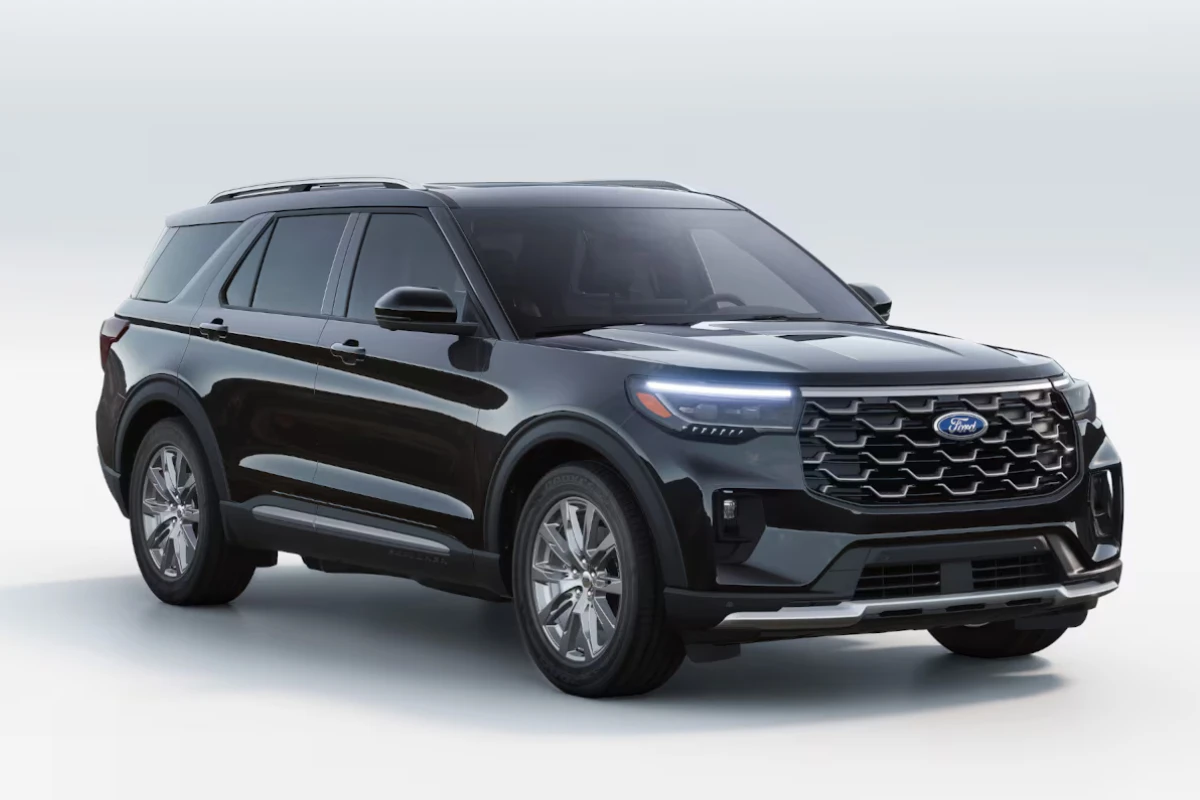
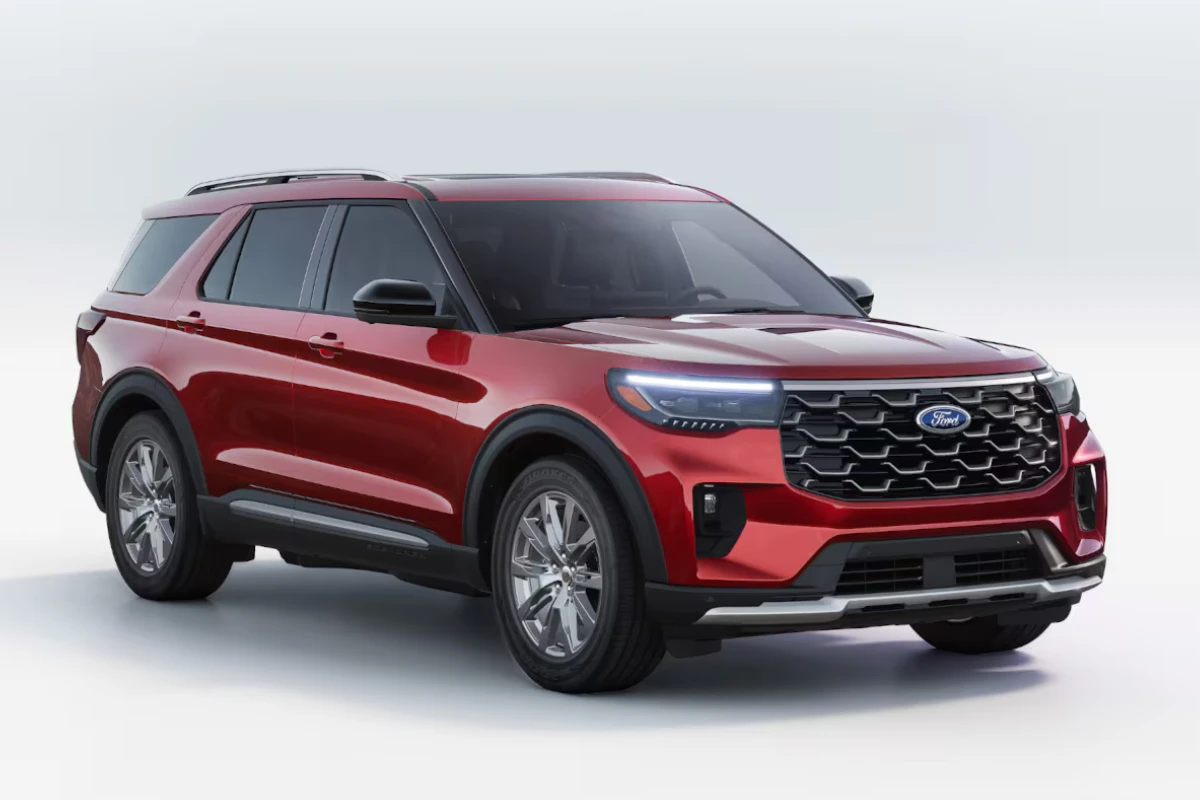

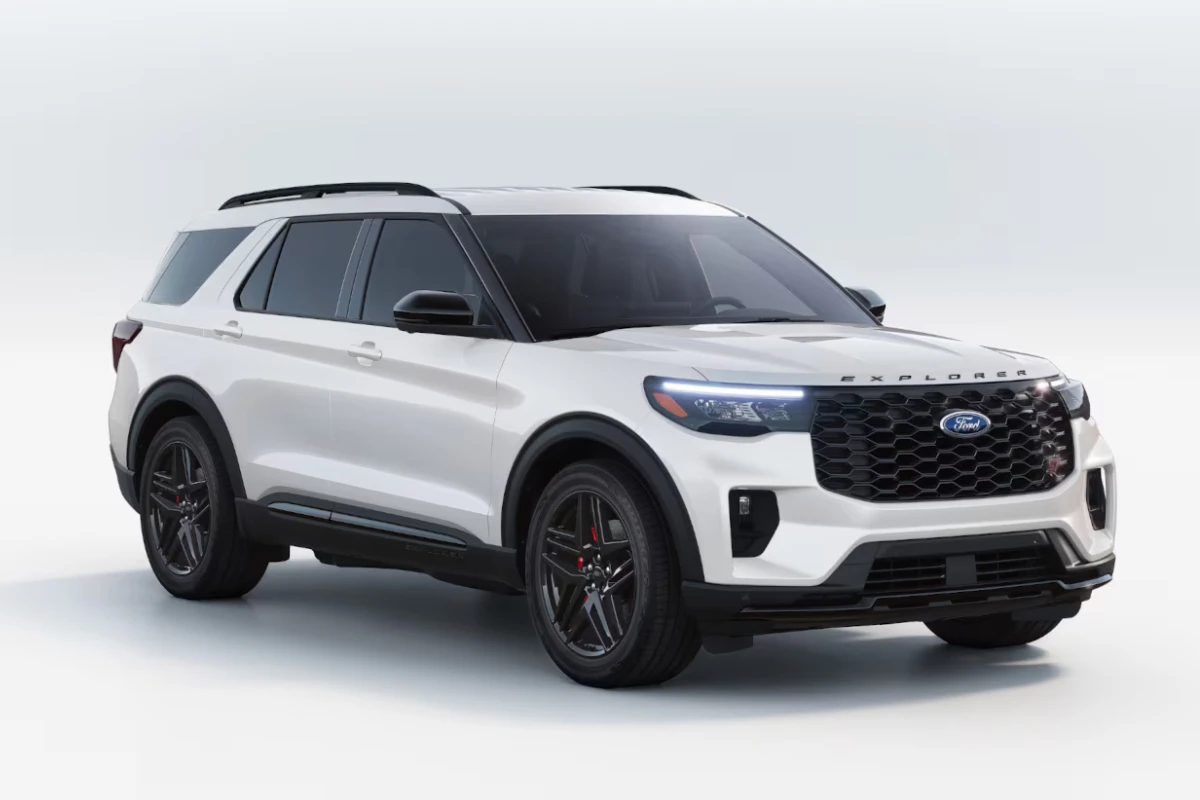
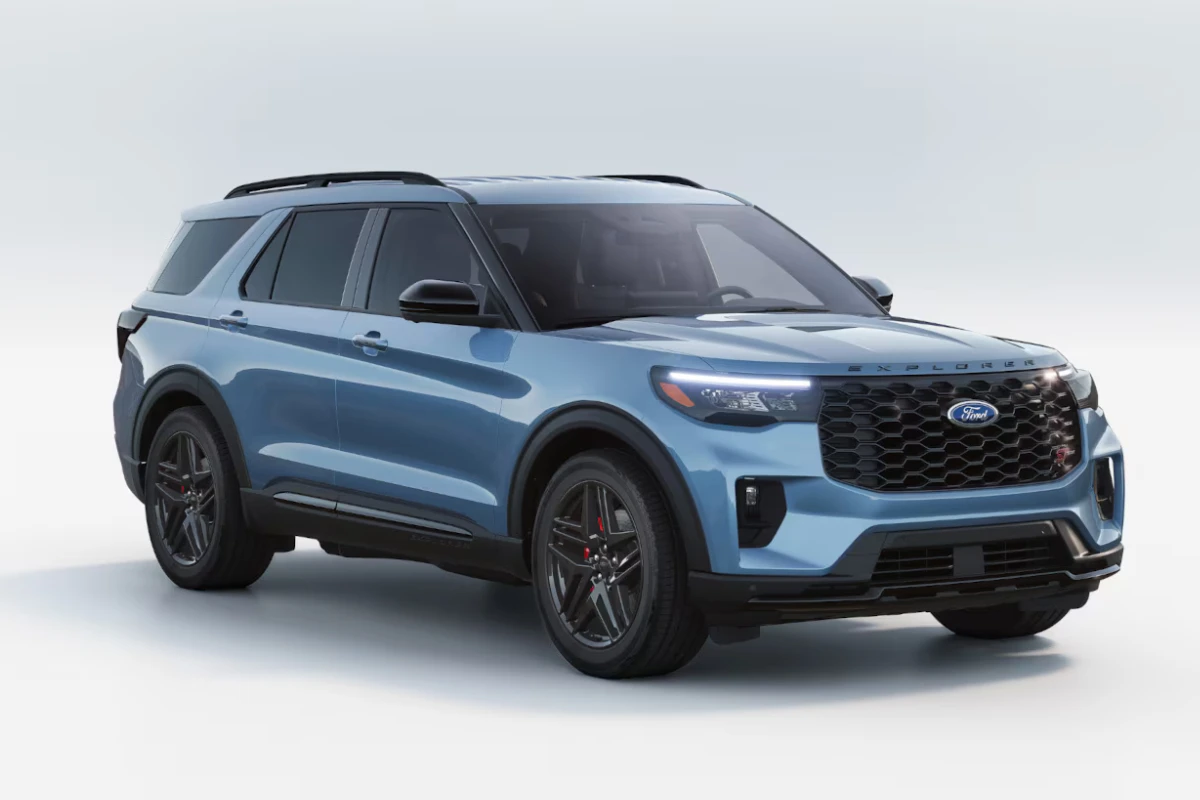
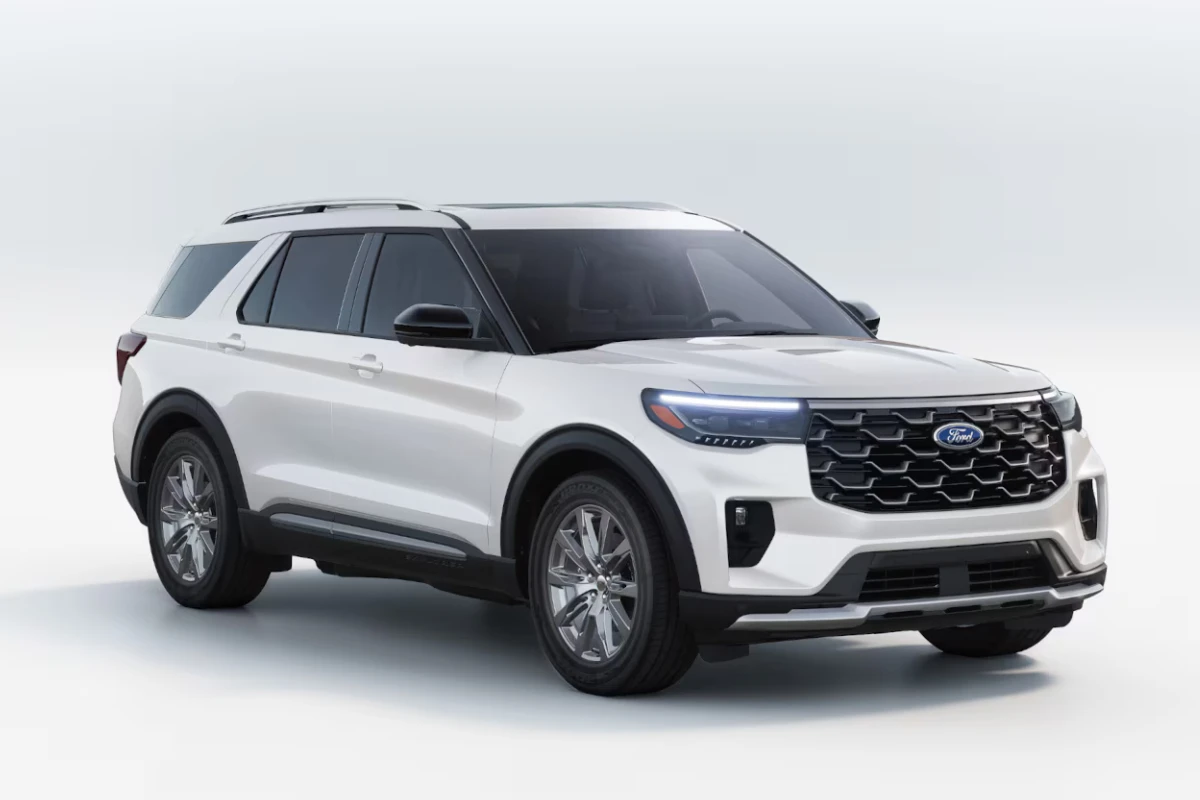
Exterior Dimensions
| Dimension | Explorer Active RWD | Explorer Active 4WD | Explorer ST-Line RWD | Explorer ST-Line 4WD | Explorer Platinum RWD | Explorer Platinum 4WD | Explorer ST RWD | Explorer ST 4WD |
|---|---|---|---|---|---|---|---|---|
| Starting MSRP | $41,380 | $43,380 | $46,190 | $48,190 | $53,695 | $55,695 | $55,835 | $57,835 |
| Wheelbase | 119.1 in | 119.1 in | 119.1 in | 119.1 in | 119.1 in | 119.1 in | 119.1 in | 119.1 in |
| Overall Length | 198.8 in | 198.8 in | 198.8 in | 198.8 in | 198.8 in | 198.8 in | 198.8 in | 198.8 in |
| Overall Width (without mirrors) | 78.9 in | 78.9 in | 78.9 in | 78.9 in | 78.9 in | 78.9 in | 78.9 in | 78.9 in |
| Overall Height | 69.6 in | 70.2 in | 69.6 in | 70.2 in | 69.6 in | 70.2 in | 69.6 in | 69.8 in |
| Front Track Width | 66.9 in | 66.9 in | 66.9 in | 66.9 in | 66.9 in | 66.9 in | 66.9 in | 66.9 in |
| Rear Track Width | 66.9 in | 66.9 in | 66.9 in | 66.9 in | 66.9 in | 66.9 in | 66.9 in | 66.9 in |
| Ground Clearance | 7.6 in | 8.2 in | 7.6 in | 8.2 in | 7.6 in | 8.2 in | 7.6 in | 7.8 in |
| Liftover Height | 32.8 in | 32.8 in | 32.8 in | 32.8 in | 32.8 in | 32.8 in | 32.8 in | 32.8 in |
Interior Dimensions
| Dimension | Explorer Active RWD | Explorer Active 4WD | Explorer ST-Line RWD | Explorer ST-Line 4WD | Explorer Platinum RWD | Explorer Platinum 4WD | Explorer ST RWD | Explorer ST 4WD |
|---|---|---|---|---|---|---|---|---|
| Passenger Capacity | 6 | 6 | 7 | 7 | 6 | 6 | 6 | 6 |
| Total Passenger Volume | 152.9 cu ft | 152.9 cu ft | 152.9 cu ft | 152.9 cu ft | 146.0 cu ft | 146.0 cu ft | 151.8 cu ft | 151.8 cu ft |
| Front Head Room | 40.7 in | 40.7 in | 40.7 in | 40.7 in | 38.9 in | 38.9 in | 40.7 in | 40.7 in |
| Front Leg Room | 43.0 in | 43.0 in | 43.0 in | 43.0 in | 42.9 in | 42.9 in | 42.9 in | 42.9 in |
| Front Shoulder Room | 62.1 in | 62.1 in | 62.1 in | 62.1 in | 62.1 in | 62.1 in | 62.1 in | 62.1 in |
| Front Hip Room | 59.2 in | 59.2 in | 59.2 in | 59.2 in | 59.2 in | 59.2 in | 59.2 in | 59.2 in |
| Second Row Head Room | 40.5 in | 40.5 in | 40.5 in | 40.5 in | 38.2 in | 38.2 in | 40.5 in | 40.5 in |
| Second Row Leg Room | 39.0 in | 39.0 in | 39.0 in | 39.0 in | 38.3 in | 38.3 in | 38.3 in | 38.3 in |
| Second Row Shoulder Room | 61.9 in | 61.9 in | 61.9 in | 61.9 in | 61.9 in | 61.9 in | 61.9 in | 61.9 in |
| Second Row Hip Room | 59.1 in | 59.1 in | 59.1 in | 59.1 in | 59.1 in | 59.1 in | 59.1 in | 59.1 in |
| Third Row Head Room | 38.9 in | 38.9 in | 38.9 in | 38.9 in | 38.9 in | 38.9 in | 38.9 in | 38.9 in |
| Third Row Leg Room | 32.2 in | 32.2 in | 32.2 in | 32.2 in | 32.2 in | 32.2 in | 32.2 in | 32.2 in |
| Third Row Shoulder Room | 54.6 in | 54.6 in | 54.6 in | 54.6 in | 54.6 in | 54.6 in | 54.6 in | 54.6 in |
| Third Row Hip Room | 40.9 in | 40.9 in | 40.9 in | 40.9 in | 40.9 in | 40.9 in | 40.9 in | 40.9 in |
Cargo Dimensions
| Dimension | Explorer Active RWD | Explorer Active 4WD | Explorer ST-Line RWD | Explorer ST-Line 4WD | Explorer Platinum RWD | Explorer Platinum 4WD | Explorer ST RWD | Explorer ST 4WD |
|---|---|---|---|---|---|---|---|---|
| Cargo Space Behind Third Row | 16.3 cu ft | 16.3 cu ft | 16.3 cu ft | 16.3 cu ft | 16.3 cu ft | 16.3 cu ft | 16.3 cu ft | 16.3 cu ft |
| Cargo Space Behind Second Row | 46.0 cu ft | 46.0 cu ft | 46.0 cu ft | 46.0 cu ft | 46.0 cu ft | 46.0 cu ft | 46.0 cu ft | 46.0 cu ft |
| Cargo Space/Area Length Behind First Row | 84.1 in | 84.1 in | 84.1 in | 84.1 in | 84.1 in | 84.1 in | 84.1 in | 84.1 in |
| Cargo Space/Area Length Behind Second Row | 49.8 in | 49.8 in | 49.8 in | 49.8 in | 49.8 in | 49.8 in | 49.8 in | 49.8 in |
| Cargo Space/Area Length Behind Third Row | 20.8 in | 20.8 in | 20.8 in | 20.8 in | 20.8 in | 20.8 in | 20.8 in | 20.8 in |
| Cargo Space/Area Width at Beltline | 64.5 in | 64.5 in | 64.5 in | 64.5 in | 64.5 in | 64.5 in | 64.5 in | 64.5 in |
| Cargo Bed Width Between Wheelhousings | 47.6 in | 47.6 in | 47.6 in | 47.6 in | 47.6 in | 47.6 in | 47.6 in | 47.6 in |
| Cargo Bed Height | 32.8 in | 32.8 in | 32.8 in | 32.8 in | 32.8 in | 32.8 in | 32.8 in | 32.8 in |
Weight & Capacity
| Dimension | Explorer Active RWD | Explorer Active 4WD | Explorer ST-Line RWD | Explorer ST-Line 4WD | Explorer Platinum RWD | Explorer Platinum 4WD | Explorer ST RWD | Explorer ST 4WD |
|---|---|---|---|---|---|---|---|---|
| Base Curb Weight | 4,344 lbs | 4,457 lbs | 4,344 lbs | 4,457 lbs | 4,344 lbs | 4,457 lbs | 4,670 lbs | 4,766 lbs |
| Maximum Towing Capacity | 5,000 lbs | 5,000 lbs | 5,000 lbs | 5,000 lbs | 5,000 lbs | 5,000 lbs | 5,000 lbs | 5,000 lbs |
| Fuel Tank Capacity | 18.6 gal | 18.6 gal | 18.6 gal | 18.6 gal | 18.6 gal | 18.6 gal | 20.2 gal | 20.2 gal |
Wheels & Tires
| Dimension | Explorer Active RWD | Explorer Active 4WD | Explorer ST-Line RWD | Explorer ST-Line 4WD | Explorer Platinum RWD | Explorer Platinum 4WD | Explorer ST RWD | Explorer ST 4WD |
|---|---|---|---|---|---|---|---|---|
| Front Wheel Size | 18 x 7.5 in | 18 x 7.5 in | 20 x 8 in | 20 x 8 in | 20 x 8 in | 20 x 8 in | 21 x 9 in | 21 x 9 in |
| Rear Wheel Size | 18 x 7.5 in | 18 x 7.5 in | 20 x 8 in | 20 x 8 in | 20 x 8 in | 20 x 8 in | 21 x 9 in | 21 x 9 in |
| Front Tire Size | P255/65HR18 | P255/65HR18 | P255/55VR20 | P255/55VR20 | P255/55VR20 | P255/55VR20 | P275/45WR21 | P275/45WR21 |
| Rear Tire Size | P255/65HR18 | P255/65HR18 | P255/55VR20 | P255/55VR20 | P255/55VR20 | P255/55VR20 | P275/45WR21 | P275/45WR21 |
| Spare Tire | Tire Mobility Kit | Tire Mobility Kit | Tire Mobility Kit | Tire Mobility Kit | Tire Mobility Kit | Tire Mobility Kit | Tire Mobility Kit | Tire Mobility Kit |
| Wheel Material | Aluminum | Aluminum | Aluminum | Aluminum | Aluminum | Aluminum | Aluminum | Aluminum |
2025 Ford Explorer Overview:
The 2025 Ford Explorer has gotten a pretty big update, or what they call a mid-cycle refresh. This SUV has been a go-to for families in America, and now it’s stepping up its game while keeping that trusted vibe. They’ve cut down the Explorer lineup from eight trims to just four: Active (which is the base model), ST-Line, Platinum, and the sporty ST. This makes it a lot easier for folks to pick the right Explorer without getting lost in too many options, yet still offers choices for those looking for value, sportiness, luxury, or just solid performance.
Now, in the tough world of midsize three-row SUVs, the Explorer has some serious competition, like the Toyota Grand Highlander, Chevrolet Traverse, Kia Telluride, Hyundai Palisade, Honda Pilot, and Jeep Grand Cherokee L. Each of these rivals has its own strengths. For instance, the Grand Highlander boasts a hybrid option and great space in the third row, while the Traverse is known for its roomy cargo area. Then you’ve got the Telluride and Palisade twins that really shine when it comes to value and the quality of their interiors. And let’s not forget the Honda Pilot, which offers a comfy ride but doesn’t quite match the Explorer’s performance, especially when you look at the ST trim.
What really makes the Explorer stand out in this crowded market? Well, it’s got a rear-wheel-drive-based setup (and you can get all-wheel drive, too), which gives it a more fun driving experience compared to most front-wheel-drive SUVs. This platform is shared with the Lincoln Aviator, helping with better weight distribution and handling. Plus, the 2025 refresh tackles some of the previous model’s shortcomings, like that vertical touchscreen that everyone found a bit awkward. Now, they’ve swapped it out for a more user-friendly 13.2-inch horizontal display.
Ford has consistently sold between 180,000 to 200,000 Explorers each year in the U.S., which speaks to its popularity. The Explorer’s been around since 1991, and the current sixth generation—introduced in 2020—brings back that rear-wheel-drive layout from the earlier models after years of focusing on front-wheel drive. With this 2025 update, Ford is keeping this strong seller competitive as it hits the midpoint of its generation.
As for pricing, the 2025 Explorer kicks off at about $41,220 for the entry-level Active trim and goes up to around $56,800 for the performance-focused ST model. If you load up the higher-end models with all the options, you could be looking at just over $60,000. So, yeah, it sits right in the middle of the midsize SUV market, catering to a variety of budgets and preferences.
On the outside, you’ll notice some significant changes for 2025, like a revamped front fascia with a bigger grille, new headlight designs, and rear taillights that now have this sleek black element connecting them, complete with Explorer branding. Inside, the dashboard has been completely redesigned around that new horizontally-oriented touchscreen, plus they’ve improved the materials throughout the cabin. All of these updates combine to create a noticeable enhancement while keeping that familiar Explorer feel.
Engine Options and Performance Specs:
The 2025 Ford Explorer brings two solid powertrain options to the table, both linked up with a 10-speed automatic transmission. If you’re looking at the Active, ST-Line, or Platinum trims, you’ll find the standard engine is a 2.3-liter, turbocharged EcoBoost four-cylinder that packs a punch with 300 horsepower and 310 lb-ft of torque. It’s actually impressive for a vehicle this size, letting the Explorer go from 0 to 60 mph in about 6.0 seconds. The turbocharger really helps with low-end torque, so it feels responsive when you’re just driving around town.
If you’re after something with a bit more oomph, the Explorer ST offers a 3.0-liter twin-turbocharged EcoBoost V6 right out of the gate, cranking out a hefty 400 horsepower and 415 lb-ft of torque. You can even opt for this engine on the Platinum trim. With this powerhouse, the Explorer ST zips from 0 to 60 mph in around 5.1 seconds – which is honestly quite fast for a family SUV that seats three rows of passengers. The twin-turbo V6 delivers that power with hardly any lag, making those highway passes feel like a breeze.
When it comes to the 10-speed automatic transmission, it usually does its job well, giving nice, smooth shifts during regular driving. That said, we did catch some hesitation on downshifts when you need to pick up speed, especially if you’re already rolling. But when you hit the gas hard from a stop, the transmission does a decent job of managing power delivery, really helping the Explorer utilize its potential. Both engines pair nicely with the transmission, though the V6 seems to have a slight edge in terms of compatibility.
One thing that’s missing from the 2025 lineup is the hybrid option that was available before. Ford has decided to drop this, which might not sit well with those who are conscious about fuel economy. So, the Explorer now lacks an electrified option just when competitors like the Toyota Grand Highlander are offering hybrids that shine in fuel efficiency. Still, the standard engines do manage to deliver competitive efficiency for what they offer.
If towing is on your agenda, the Explorer can handle a maximum of 5,000 pounds, no matter which engine you choose. That’s on par with some key competitors and should be enough for most weekend warrior tasks, like hauling a medium-sized boat or a small camper. Plus, the tow package comes with a Class III trailer hitch, wiring harness, and trailer sway control as standard, which is pretty handy.
All models of the Explorer come with rear-wheel drive, but if you want all-wheel drive, you can get it for about $2,000 extra. This system can direct power to the front wheels when it’s needed for better traction, but it keeps a rear bias for improved handling. And under normal conditions, it can even disconnect the front axle to help save on fuel.
Closer Look at the Ford Explorer Brakes:
The braking system of the 2025 Ford Explorer definitely varies depending on the trim level, and let us tell you, there are some impressive upgrades for those performance-focused models. The base Active and the more luxurious Platinum trims come with standard brakes that do a solid job of stopping power for your everyday driving needs. In our testing, we found that these models consistently delivered reliable braking performance with a nice feel on the pedal. This made it easy to manage stops smoothly in traffic, and you could count on them when you needed to stop quickly.
If you step up to the ST and ST-Line trims—especially with the performance package—you’re getting some upgraded brakes that are actually shared with the Ford Police Interceptor version of the Explorer. These brakes are no joke; they come with larger rotors and flashy red-painted calipers, which boost that stopping power and help resist fade when you’re driving a bit more spiritedly. In our tests with the ST model, it was impressive to see the Explorer come to a stop from 70 mph in just 172 feet. Not too shabby for a vehicle that weighs almost 4,800 pounds!
You’ll notice that the pedal feel varies a bit between the standard brakes and the performance ones. The ST’s brakes give you a firmer initial bite and a more consistent response as you press down on the pedal, which boosts your confidence, especially when driving aggressively. On the other hand, the standard brakes on the other trims are designed for a smoother engagement, focusing on comfort for family trips without feeling too mushy or unclear.
Every Explorer model out there benefits from an electronic brake booster. This nifty feature ensures you get a consistent pedal feel no matter the driving conditions. Plus, it supports all those driver assistance features that rely on automatic braking—think adaptive cruise control with stop-and-go and the automatic emergency braking system.
Another cool aspect of the Explorer’s braking system is the standard brake-based torque vectoring. This tech can apply braking force to the inside wheels when you’re cornering, which really helps with handling. You can especially feel this in the ST model; it makes the nearly 2.5-ton SUV feel surprisingly nimble, given its size.
Oh, and if you go for the all-wheel-drive option, the Explorer comes with hill descent control. This feature automatically adjusts the brakes to keep a steady speed when you’re tackling steep downhill paths. While most folks might not use this all that often, it definitely adds a layer of confidence for those times when you find yourself on unpaved roads or in tricky terrain.
Steering and Suspension Performance on Various Terrains:

So, what about the steering system in the 2025 Ford Explorer? Well, it’s pretty accurate and has a decent weight across the different trim levels, though you might wish for a bit more feedback. You see, the electrically assisted power steering varies depending on which trim you choose. Take the ST, for instance; it has a noticeably heftier feel, which fits its performance-driven persona. Now, some folks might think the ST’s steering is a tad too heavy for everyday driving. But, hey, it definitely adds to that sporty vibe, especially when you’re tackling those twisty backroads.
When it comes to suspension tuning, this is where things get interesting. The base Active and the more luxurious Platinum models are designed with comfort in mind. Still, they manage to handle it respectably well. For 2025, Ford has made some tweaks to the suspension across the lineup, improving both the ride quality and handling. The chassis feels stiffer now, which means less flex when you’re going around corners and better protection from any harsh bumps you might hit.
The ST model? It’s got a sport-tuned suspension that’s all about firmer springs, dampers, and anti-roll bars. This setup cuts down on body roll while you’re turning and gives you a quicker response when you steer. But here’s the catch – the ride is noticeably firmer, so you’ll feel more of those road imperfections inside. It’s not brutally uncomfortable, but if you’re looking for pure comfort, the ST might not be your best bet, especially for families.
Now, if you want something in the middle, the ST-Line is a solid choice. It shares some visual traits with the ST but keeps a more comfort-focused suspension. Just a heads up – if you opt for the bigger 21-inch wheels (like those on the ST), the ride might take a bit of a hit since there’s less tire sidewall to cushion the bumps.
One thing all Explorer models have going for them is the rear-wheel-drive setup, which helps with weight distribution compared to those front-drive competitors. This advantage makes the Explorer feel more balanced in corners and super stable on the highway. Even the base model offers a more engaging ride than a lot of other three-row SUVs out there.
As for ride quality, the Explorer tends to feel a bit firmer than rivals like the Honda Pilot or the Kia Telluride. This is especially true for the ST, but even the trims aimed at comfort still focus more on body control than just being plush. The good news? The Explorer holds its own over bumpy roads and doesn’t sway too much during quick changes in direction.
Tires and Traction:
The 2025 Ford Explorer comes with a variety of tire choices across its different trims, and each one kinda gives a unique mix of comfort, handling, and all-weather capability. So, if you start with the base Active trim, you’ll find it has 18-inch aluminum wheels fitted with all-season tires. These tires are all about comfort and durability, which is nice.
Then, if you step up to the ST-Line, you’ll get 20-inch machined aluminum wheels. These have a bit of a lower profile, which really ups the vehicle’s visual appeal, but hey, they still manage to keep a decent ride quality, so that’s a win-win, right?
Now, if you’re looking at the performance-focused ST trim, you’re gonna see even bigger 21-inch aluminum wheels paired with 275/45R21 Pirelli Scorpion Zero all-season tires. These tires are impressive, offering great grip in dry conditions while still being usable all year round. Trust me, during our tests, they handled really well and gave good traction when driving spiritedly, though we gotta say, the lower sidewall does make the ride a bit firmer.
In the Platinum trim, you start with standard 20-inch wheels, but you can opt for 21-inch wheels through various packages. The base 20-inch setup strikes a nice balance between ride comfort and handling, which is perfect for those folks who care about passenger comfort. Sure, the 21-inch wheels look great, but they do come with a trade-off: Less sidewall height means a bit of a rougher ride on bumpy roads.
If you’re interested in the all-wheel-drive models, they come with tires that can handle some light off-roading. But, just to be clear, none of these tires are true all-terrain types. There’s a “Trail” drive mode in the all-wheel-drive versions that tweaks the traction control and powertrain settings to help with grip on unpaved surfaces. But honestly, the Explorer’s all-season tires and its ground clearance (which ranges from 7.9 to 8.2 inches, depending on the trim) kinda limit how rugged it can be compared to other more off-road capable vehicles.
About tire noise: Ford did a pretty decent job keeping it down across the lineup. You won’t hear much road noise creeping into the cabin when you’re cruising on the highway. That’s especially nice with the larger wheel and tire combos since those usually kick up more noise in other cars. It seems Ford’s focus on sound insulation and the Explorer’s sturdy platform really helps here.
For those living in chillier areas, the winter performance is definitely worth mentioning. The standard all-season tires can handle light snow decently well when paired with all-wheel drive, but if you’re often facing tough winter weather, you might wanna consider getting dedicated winter tires. The Continental ExtremeContact DWS06 Plus has been highlighted as a solid all-season choice for the Explorer, giving you better snow traction without the hassle of switching tires every season.
Inside the Ford Explorer:
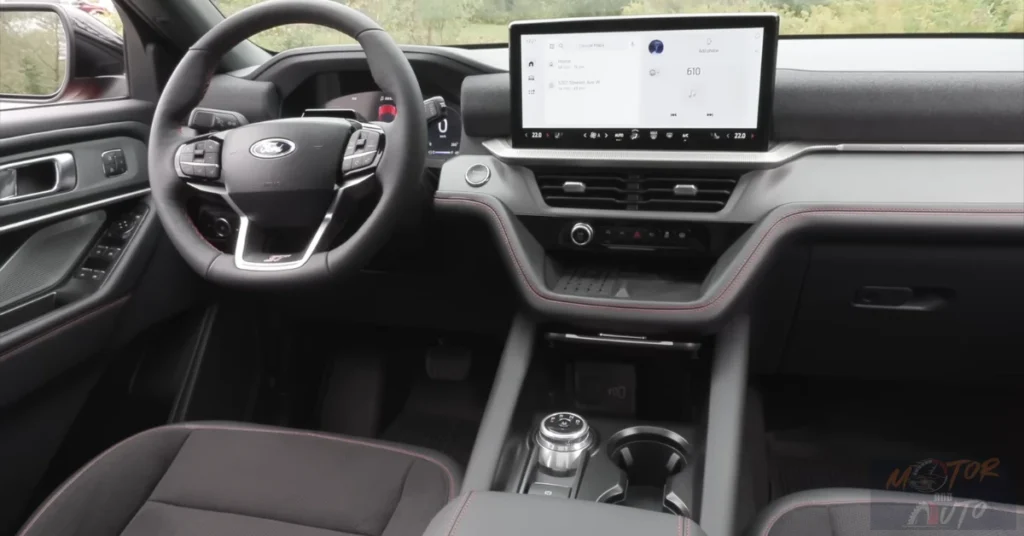
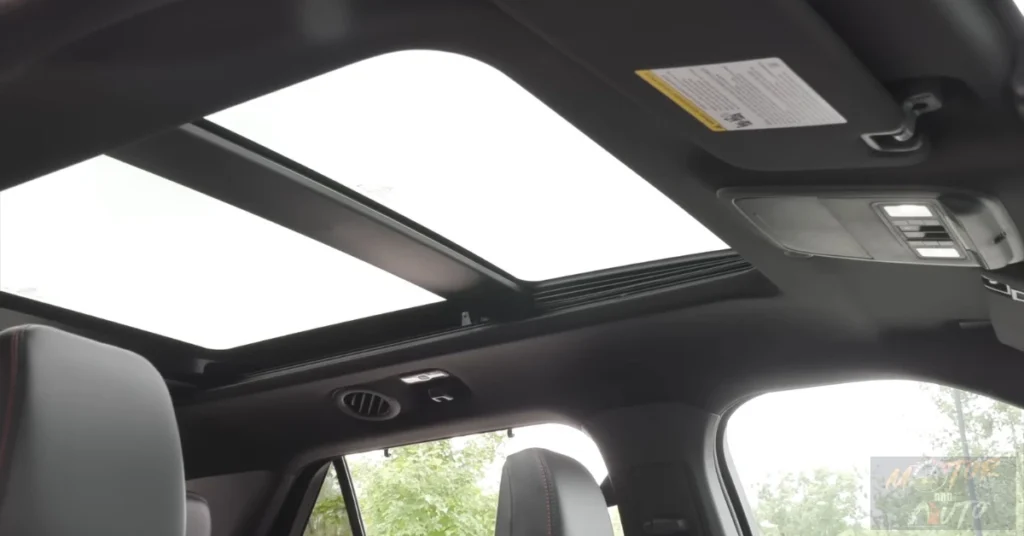
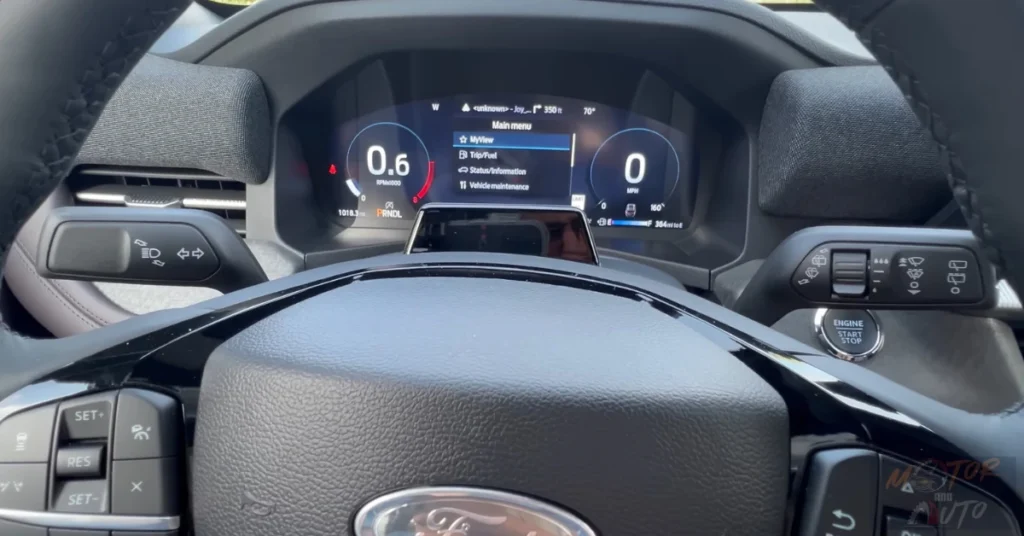
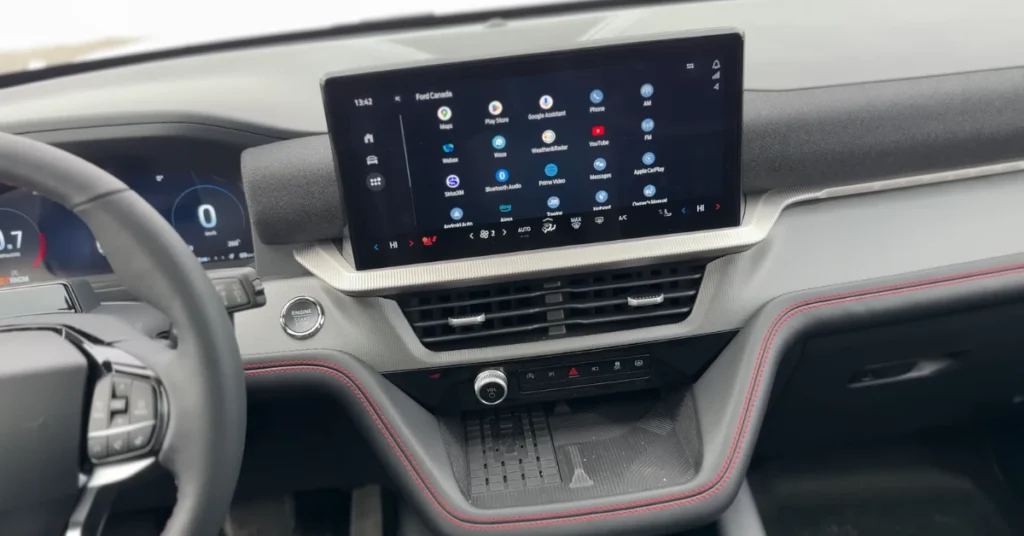
The interior of the 2025 Ford Explorer has gotten some pretty significant updates, which really tackle one of the biggest complaints about the previous model. The most eye-catching change? Well, they’ve completely redesigned the dashboard! Now, instead of that awkward vertical tablet-style display, there’s a sleek horizontal 13.2-inch touchscreen. This switch not only makes the layout feel more ergonomic but also gives the whole interior a modern, balanced vibe.
About materials—there have been huge improvements here, too. Even the base Active model now has more soft-touch surfaces and a better panel fit than before. If you step up the trim levels, it just gets fancier. The Platinum trim, for example, comes with genuine leather upholstery that has these nice quilted inserts, plus tons of soft-touch areas throughout the cabin. The ST model goes for a sportier look with leather seats that have microsuede inserts and some striking red contrast stitching that really pops.
A fresh design feature for 2025 is this speaker bar that spans the dashboard. It not only gives the interior a more upscale appearance but also houses some Bang & Olufsen speakers in the higher trims. This horizontal design element helps to visually expand the cabin, making it feel more open and modern. Oh, and there’s a handy shelf-like area below the infotainment screen for your smartphone, and—bonus!—you can get wireless charging in the higher trims.
Now, about the digital interfaces—Ford has revamped these for 2025. The standard 12.3-inch digital instrument cluster is sharp and offers different display options so you can choose what info you want to see. The new central touchscreen, which is also 13.2 inches, runs on Ford’s latest Digital Experience interface powered by Google’s Android Automotive platform. This means it’s much more responsive and user-friendly than the previous Sync system.
Connectivity options are comprehensive across all trim levels. Wireless Apple CarPlay and Android Auto are standard, allowing seamless integration with smartphones without cumbersome cables. A 4G LTE Wi-Fi hotspot is included, capable of connecting up to 10 devices simultaneously. The Explorer also supports Ford’s Phone As A Key technology, which allows owners to use their smartphone to unlock and start the vehicle without the physical key fob – particularly useful when activities like swimming or running might make carrying keys inconvenient.
For those who enjoy a little ambiance, the higher trims offer ambient lighting with customizable colors that really elevate the cabin’s feel at night. The ST model has a cool red lighting scheme that fits its sporty persona, and you’ll also find illuminated ST logos on the door sill plates. The Platinum, on the other hand, features a more refined lighting setup with a wider range of colors.
Overall, the design philosophy in the Explorer is a solid mix of form and function. Most controls are easy to reach and intuitive, although some might find moving the climate controls to the touchscreen a bit annoying if they’re fans of physical knobs and buttons. The rotary gear selector is a nice touch too—it frees up space in the console compared to a traditional shifter, which helps create that open feeling in the cabin. Plus, storage is plentiful! You’ve got a deep center console, spacious door pockets, and various smaller bins to stash your stuff.
Exterior Design Impressions:
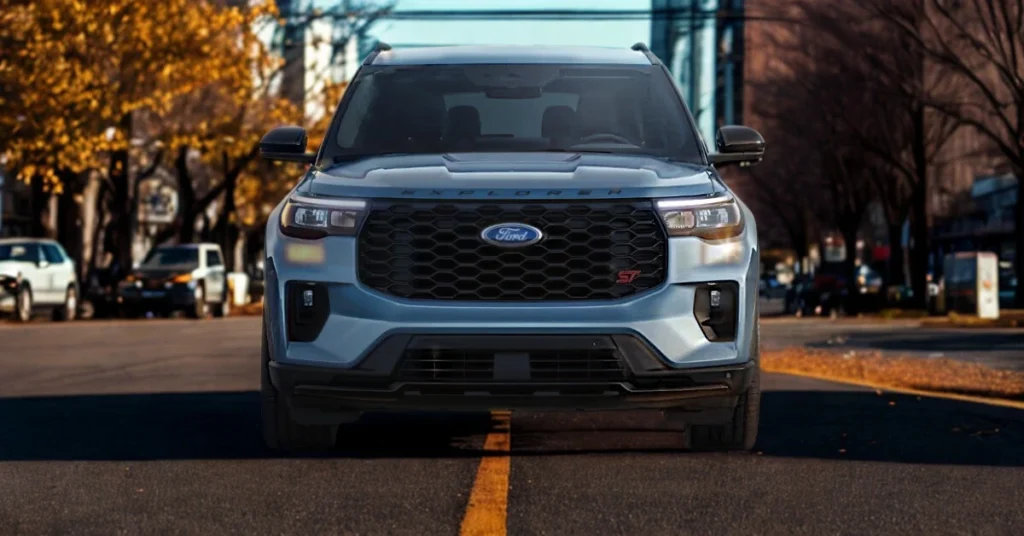
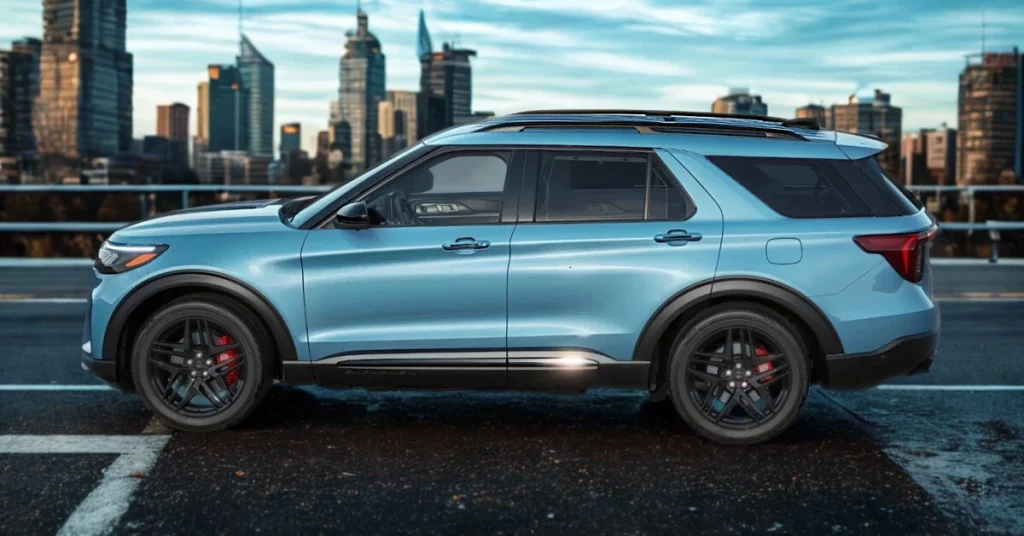
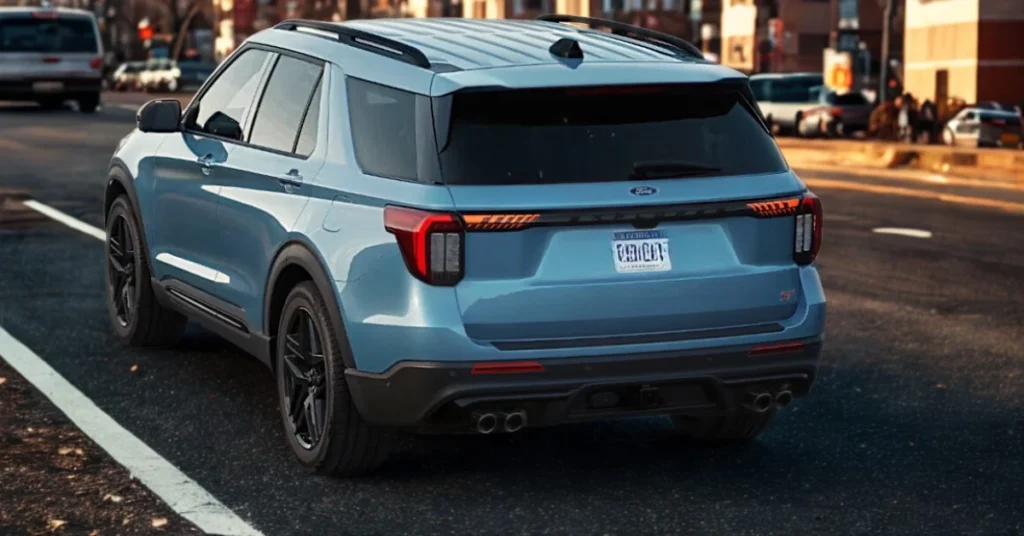
The 2025 Ford Explorer has received a significant facelift, bringing a fresh vibe to its look while still keeping that recognizable shape we all know. Up front, the changes are hard to miss: there’s a bigger, bolder grille that’s paired with sleek new LED headlights. And here’s the cool part—each trim level gets its own unique grille style. The Active has a shiny silver mesh, the ST-Line and ST go for a sporty black honeycomb design, and the Platinum features a classy chrome finish that highlights its premium status in the lineup.
Moving to the sides, the Explorer sticks to its guns, keeping that smooth roofline and strong character lines that have been its trademark since 2020. With rear-wheel-drive proportions, it stands out with a more dynamic stance compared to many of its front-wheel-drive rivals. The hood’s longer, and overall, it just looks more balanced. For 2025, Ford has introduced some new wheel designs, too. They range from 18 inches on the base Active to a hefty 21 inches on the ST, which really amps up the vehicle’s presence on the road.
Now, check out the back. It’s got some cool updates for 2025, like the redesigned LED taillights that now connect with a black element across the liftgate, showcasing the Explorer name in a bold way. This horizontal light strip gives it a more modern and cohesive look. Depending on which trim you go for, the exhaust treatment varies a lot—the ST flaunts sporty quad exhaust outlets, while the other trims keep it more subtle, with some hidden outlets.
Color choices also play a big role in what makes the Explorer stand out. The ST looks super sharp in Rapid Red, highlighting its sporty styling, whereas the Platinum comes off as really sophisticated in Star White Tri-Coat Metallic. There’s a new shade for 2025 called Vapor Blue, which strikes a nice balance with its unique but not over-the-top look. Ford is also offering a black-painted roof option for the Platinum, ST, and ST-Line trims this year, creating a snazzy two-tone effect that adds a bit of flair.
On the functional side, there are updates here too. All models come with standard LED lighting at both the front and back, and the Platinum trim gets fancy adaptive headlights that adjust their beam based on what’s going on around you. If you’re looking at the Platinum or ST models, you’ll also find power-folding side mirrors with puddle lamps, and roof rails are standard across the board, boosting utility. They’ve even added functional air curtains on the front sides to help with aerodynamics, which also adds a more technical vibe to the Explorer.
Oh, and we’ve gotta give a shoutout to the ST-Line. It’s pretty cool because it offers much of that sporty look the ST has, without all the performance bits. You get blacked-out exterior details, unique badging, and the option for those same 21-inch wheels that the ST has. So, if you want that sporty aesthetic without breaking the bank, this is a solid choice. It’s part of a growing trend in the industry where more brands are offering appearance packages that mimic the performance models.
Comfort and Convenience Features
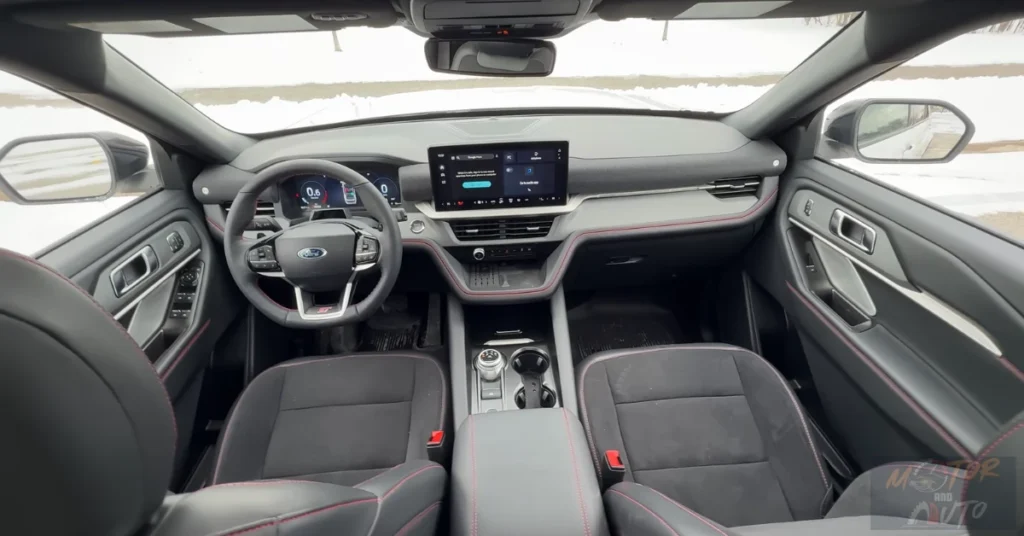
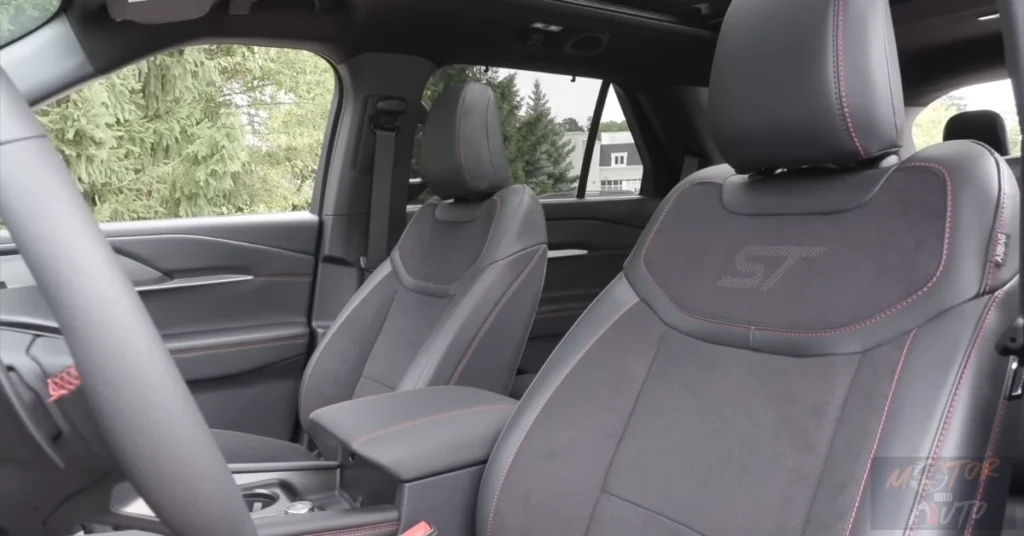
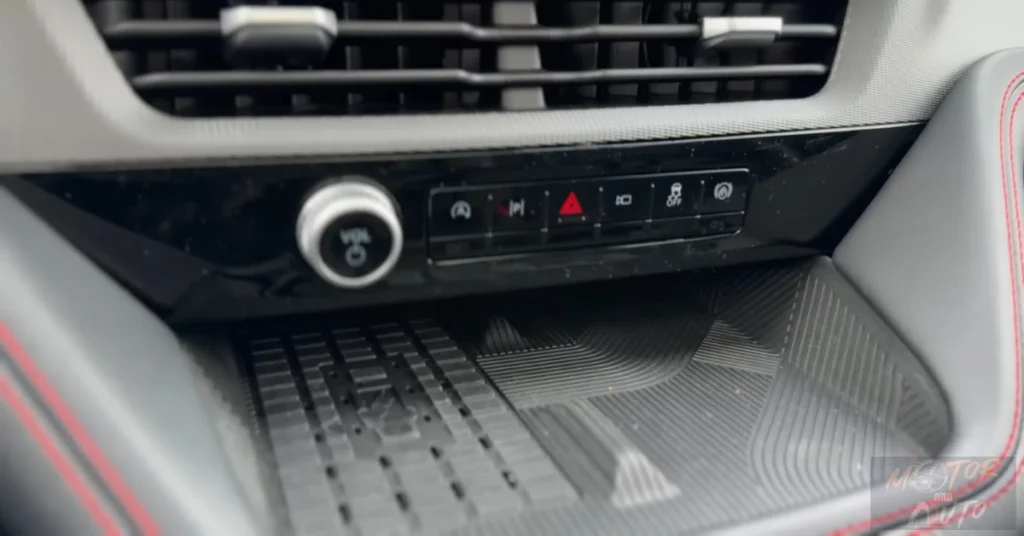
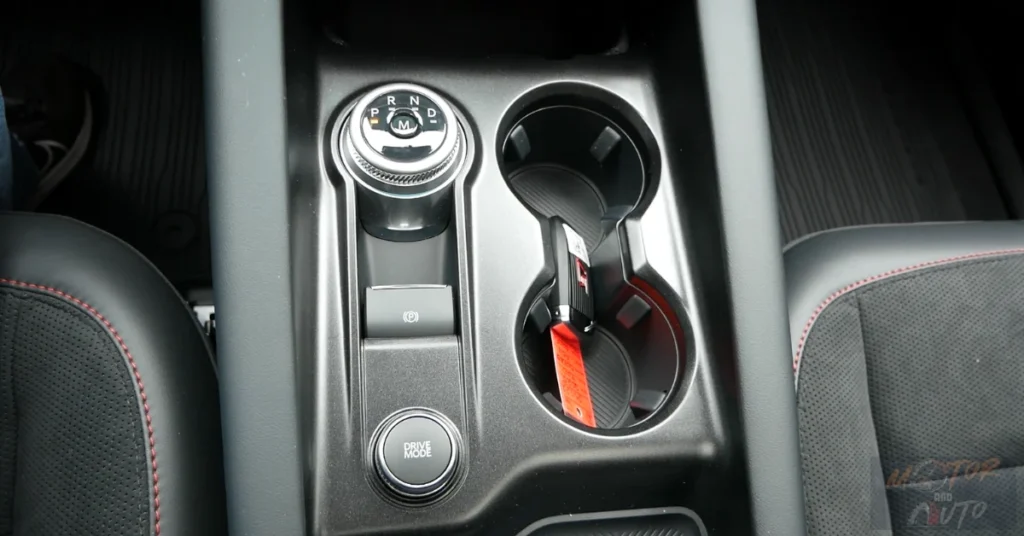
The 2025 Ford Explorer really shines when it comes to making sure passengers are comfy and have all the handy features they need. You’ll find that the front seats in every trim are designed to support you well on those long drives. Even the base Active model comes with a 10-way power adjustment for the driver, which is pretty neat. Now, if you step up to the Platinum or ST trims, things get even fancier. They include multi-contour seats that come with a massage function—yeah, you heard that right! This kind of feature is pretty rare in this segment, and honestly, it adds a nice touch of luxury. We took the Explorer out for some long drives, and those seats? Super comfy! The massage feature was a real treat during those extended journeys.
Now, let’s talk about the second row. It’s a bit of a mixed bag, depending on how you configure it. If you go for the Platinum or ST trims, you’ll get captain’s chairs as standard, but you can swap those for a bench seat at no extra cost if you want to fit in more people—up to seven! The captain’s chairs are really comfy for adults, giving you decent legroom at 38.2 inches, plus they slide and recline. If you opt for the bench, you still get to slide and recline, and it opens up space for an extra passenger. Oh, and all Explorer trims above the base Active also come with heated second-row seats, which is definitely a bonus when it’s chilly out.
However, the third row? Well, that’s where things get a little tricky compared to some competitors. Getting in is a breeze thanks to a one-touch button that moves the second row forward easily. However, the seating position is a bit low, which means adults might find themselves sitting with their knees up. You get about 32.2 inches of legroom back there—pretty standard for the class, but not quite as spacious as some top contenders. And while the seat cushions could use a bit more support for taller folks, there’s actually a decent amount of headroom, even for those who are a bit taller. So, it’s good for kids and teens, but adults might not want to be back there for long trips.
As for climate control, it’s well done across the board, featuring a tri-zone automatic system. Everyone gets to set their own temperature—driver, front passenger, and rear passenger. Rear folks have their own controls on the back of the center console, plus air vents in the second and third rows. The Platinum and ST models take it up a notch with heated and ventilated front seats, though the second row doesn’t get the ventilation option—something that some competitors do offer.
When it comes to tech, the Explorer does a solid job of keeping everyone connected. You’ll find multiple USB ports (both Type-A and Type-C) scattered throughout all three rows so everyone can charge their devices. If you choose a higher trim, you’ll also get a wireless charging pad for the front passengers and a handy 110V power outlet in the second row. Plus, there’s a panoramic moonroof available on all trims, and it’s standard on the higher specs, which brightens up the cabin and gives it a more open feel, especially for those in the back.
Storage? Oh, there’s plenty of that too! The center console is deep enough for tablets and small bags, and there’s a handy shelf under the infotainment screen for your smartphone. Door pockets are nice and roomy in both the front and back, complete with bottle holders. If you’ve got captain’s chairs in the second row, there’s a small console between the seats that comes with extra cupholders and storage. Ford really thought about families when designing this cabin—there are spots for all sorts of small items like sunglasses, toll transponders, and charging cables. It’s pretty clear they get how families use their vehicles!
Audio systems vary by trim level, with even the base Active getting a decent standard setup. Moving up to the ST-Line brings a 12-speaker Bang & Olufsen sound system, while the Platinum and ST models feature an enhanced 14-speaker B&O arrangement. We found the premium system particularly impressive, delivering clear highs, well-defined midrange, and substantial bass without distortion at higher volumes. The system includes a dedicated subwoofer and carefully placed speakers throughout the cabin for an immersive listening experience
Entertainment options extend beyond traditional audio with built-in gaming capabilities (usable only when parked) and streaming video services that can be used during charging stops or while waiting. These features, accessible through the Google Play Store, transform the Explorer into a mobile entertainment center when not in motion. The system even supports certain conference-calling applications like Cisco WebEx, potentially allowing the vehicle to serve as a mobile office.
Safety and Security:
The 2025 Ford Explorer is packed with a great selection of safety features, no matter which trim level you choose. Even the base Active model comes with Ford’s Co-Pilot360 suite. This includes handy stuff like pre-collision assist with automatic emergency braking, blind spot monitoring with cross-traffic alert, a lane-keeping system, auto high-beam headlights, and a rearview camera. So, even if you’re looking at the cheapest option, you still get the latest in safety tech without having to fork out extra cash for fancy packages.
About the upgrades for 2025: One of the major improvements is the addition of BlueCruise—except, of course, on that base Active trim. This hands-free driving feature lets you take your hands off the wheel on mapped divided highways (and there are over 130,000 miles of those in North America!). It uses a camera that looks at the driver to make sure you’re paying attention. When we tried it out on various highways, BlueCruise really impressed us. It kept the Explorer steady in its lane, even on gentle curves, and it was smooth when accelerating and braking in traffic. You get a free trial to start, but after that, you’ll need a subscription to keep using it.
The Explorer’s sturdy design comes from its rear-wheel-drive platform, created with modern crash safety standards in mind. Now, the 2025 model hasn’t been crash-tested by either NHTSA or IIHS yet, but the 2024 version, which is structurally the same, scored a solid 5-star rating from NHTSA and did well in IIHS tests. Plus, the Explorer has a strong passenger cell and a variety of airbags, including side-curtain airbags that cover all three rows of seating.
As for additional safety features, they do differ depending on the trim. If you go for the ST-Line, Platinum, or ST models, you’ll get a standard 360-degree camera system. This is super helpful for parking in tight spots, giving you multiple views, like a bird’s-eye perspective and close-ups of the front wheels. It makes parking easier, even though the Explorer is a bit on the larger side. The image quality is decent, but it’s not the best out there.
When it comes to security, there’s Ford’s SecuriCode keyless entry keypad—a nifty feature that lets you access your vehicle by entering a code on a touch-sensitive pad tucked away in the B-pillar. This comes in handy when you’re doing activities like swimming or hiking, where lugging around a key isn’t really practical. Plus, all Explorer models include Ford’s MyKey system, which lets parents set certain driving restrictions (like max speed or volume limits) for younger drivers.
Active safety features go beyond just the electronic aids. On certain trims, like the ST model, you get upgraded brakes that can stop quicker and resist fading during repeated hard stops. This could make a difference in an emergency. And let’s not forget about the improved all-wheel-drive system available across the board, which provides better stability in bad weather by automatically shifting torque between the axles as needed to keep you on track.
On the Road with the Ford Explorer:
When you get behind the wheel of the 2025 Ford Explorer, it’s pretty clear that it offers a driving experience that’s all about balancing everyday practicality with some surprising capability when you really push it. The standard 2.3-liter turbocharged four-cylinder engine? Well, it actually gives you better acceleration than you might think. You’ll find it can effortlessly get this SUV up to highway speeds, and it does so with a good dose of confidence. Throttle response is solid, too—there’s hardly any turbo lag, and the mid-range torque is strong enough to make passing on the highway feel like a breeze. Plus, the engine sounds quite refined for a four-cylinder, thanks to Ford’s smart acoustic engineering, which does a great job of muting that typical buzz you often hear with bigger four-cylinders.
If you step up to the Explorer ST, things really change. With a heart-pounding 400-horsepower twin-turbo V6, the driving experience just gets a whole lot more exciting. This engine can go from 0 to 60 mph in just over 5 seconds, which puts it right up there among the fastest three-row SUVs, no matter the price. It pulls strongly throughout the entire rev range and the exhaust note is purposeful and gets even better in Sport mode, but it’s never so loud that it becomes annoying. The 10-speed automatic transmission usually does a nice job with both engines, although there are times it seems to take a little too long to find the right gear during moderate acceleration. You can shift manually using the paddle shifters, but honestly, it doesn’t add much to the fun factor since the response can be a bit sluggish.
Handling varies across the different trims. All models enjoy the benefits of a rear-wheel-drive architecture, giving them a natural balance that you just don’t get with front-drive competitors. The base Active and the more luxurious Platinum versions handle well enough, showing controlled body roll in corners while still prioritizing comfort and decent dynamics. Then there’s the ST. With its sport-tuned suspension, it turns the Explorer into quite the performer on twisting roads. Body roll is kept to a minimum, turn-in feels snappier, and the car stays composed even when you push it hard.
Now, let’s talk about ride quality because this might be the biggest compromise in the Explorer lineup. Even though Ford has made improvements to the suspension for 2025, the Explorer still rides a bit firmer than many of its competitors, especially the models with those bigger wheels. The ST, with its sport suspension, tends to let in more of those road imperfections, which might not sit well with families used to a softer ride. It’s basically the tradeoff you make for the Explorer’s sharper handling compared to softer rides like the Honda Pilot or Kia Telluride.
When you hit the highway, the Explorer shows off its refinement. You’ll notice good stability and hardly any wind noise, even when you’re cruising at higher speeds. The BlueCruise hands-free driving system is a nice touch, too. It does a great job on divided highways, keeping you in your lane and managing speed changes smoothly. Just a heads-up, though: it requires you to keep your eyes on the road with an infrared camera monitoring you, but when it’s compatible, it allows for some real hands-free driving. This feature can seriously cut down on driver fatigue during those long highway treks.
As for off-road capabilities, that can depend on the configuration you choose. If you go for an all-wheel-drive model, you’ll get a Terrain Management System that has specific modes for different conditions, including a dedicated Trail mode that tweaks throttle response, transmission behavior, and traction control for unpaved paths. Now, it’s not quite the off-roader that the Bronco is, but the Explorer handles dirt roads, gravel, and moderate trails confidently, especially with all-wheel drive. Ground clearance varies from 7.9 to 8.2 inches, depending on the trim, which is good enough for most light off-road situations.
Ford Explorer Rear Seat Comfort
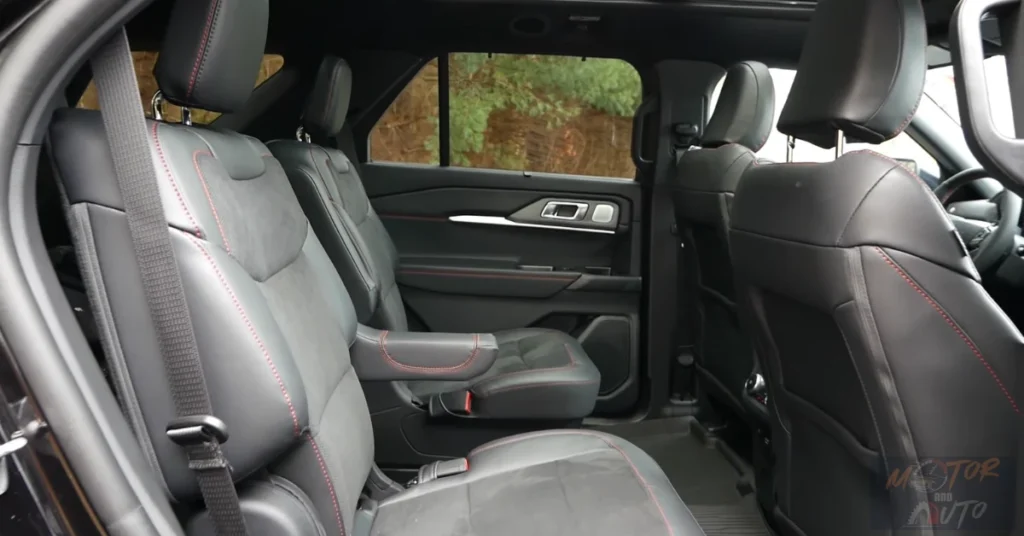


When it comes to the Explorer’s second-row seating, you’ve got two choices. You can opt for a three-person bench seat, which bumps the total passenger capacity up to seven. Or, if you prefer a bit of luxury, there are captain’s chairs that cut the seating down to six but make getting to the third row a whole lot easier. The captain’s chairs are standard in the Platinum and ST models, while the bench seat comes with the Active and ST-Line trims. A neat little thing—Ford lets you pick the bench seat at no extra cost on the higher trims, giving buyers some nice flexibility no matter what model they go for.
Now, let’s talk comfort. The second row is pretty darn good, really. You’ve got a generous 38.2 inches of legroom and decent headroom too—even with that big panoramic moonroof up there. The seats are comfy and supportive, just right for those longer drives. And if you’re in one of the higher trims, the second-row seats are heated. Trust me, rear passengers will be thankful for that when the weather gets chilly. Those captain’s chairs feel almost luxurious, with loads of space and individual armrests. If you go with the bench, the 40/20/40 split means you can fold down just the middle part to create an armrest or a pass-through to the cargo area, which is super handy.
The second row also slides forward and backward on rails, which is great for adjusting legroom or making more room for those sitting in the third row. This adjustability is a lifesaver for families with child seats, letting you optimize space based on who’s riding along. The seats can recline too, although the range isn’t as impressive as some competitors. So, while you can lean back a bit for comfort, it doesn’t quite allow for that ultimate relaxation on those long trips.
Getting to the third row? It’s a breeze. There’s a one-touch mechanism that slides and tilts the second-row seats forward, creating a nice passage to the back seats. And get this—this system works even if you’ve got forward-facing child seats in place (just not the rear-facing ones), which is a big win for families. It operates smoothly and doesn’t take much effort, making it easy for older kids to handle solo.
As for the third row, it can fit two passengers, complete with their own three-point seatbelts. Comfort here is decent, but it’s not top-notch. The low seat cushion height means adults might find their knees sitting a bit higher than they’d like. You’ve got about 32.2 inches of legroom—kind of average for this segment but definitely less than what you’d find in class leaders like the Grand Highlander and Traverse. However, headroom is surprisingly generous, even for taller folks, thanks to some clever design in the headliner.
When it comes to amenities for those sitting in the back, the Explorer doesn’t skimp. Passengers in the second row have their own climate control zone, complete with vents and controls right on the back of the center console. USB charging ports? You’ve got plenty—two USB-C ports in the second row and another two in the third row on most trims. If you step up to the higher trims, they even throw in a household-style 110V power outlet for good measure. Cupholders are thoughtfully placed throughout, with door bottle holders and dedicated cupholders in both rows. Plus, the second row has manual sunshades built into the doors, which can shield passengers from direct sunlight or cut down glare on their screens.
Bootspace and Practicality
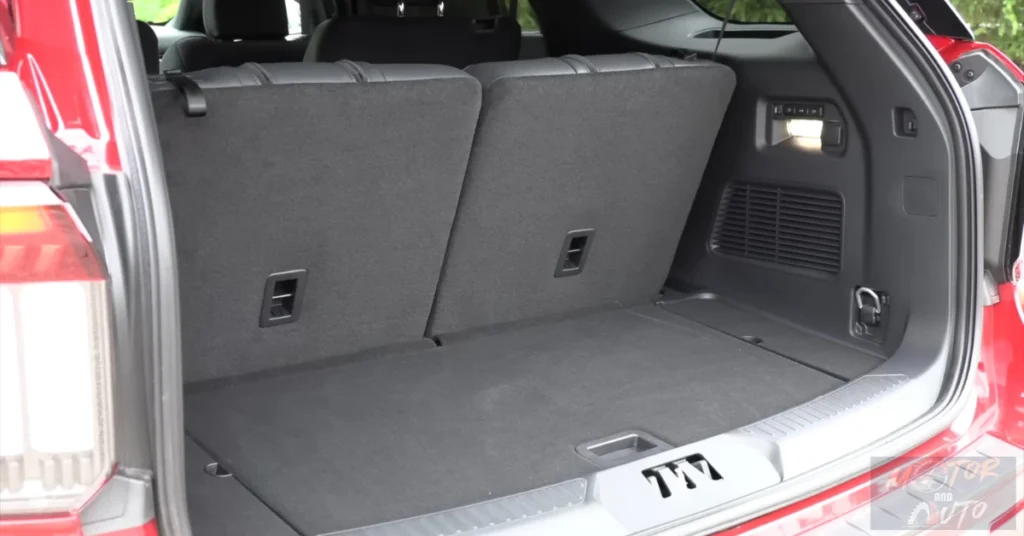

The Explorer offers a versatile cargo space that families can really appreciate. You’ve got 18.2 cubic feet behind the third row and 47.9 cubic feet behind the second row, and when you fold all the back seats down, it opens up to a whopping 87.8 cubic feet. Now, sure, it might not have the absolute most space out there—those Chevrolet Traverse and Toyota Grand Highlander models do have it beat in that department—but the Explorer makes up for it with a smart design. When the seats are down, the load floor is flat, and the wide opening makes it way easier to load up bigger items. Plus, the liftgate opens high enough to keep taller people from bumping their heads, which is always a plus.
Starting in 2025, every trim level comes with a power liftgate, and if you opt for the Platinum or ST models, you get hands-free operation, too! You can just kick your foot under the rear bumper to open it up. This is super handy, especially when you’re juggling bags of groceries or luggage. And hey, if you’ve got a low garage ceiling, you can even set the liftgate to open at a specific height, which is a nice touch for tight spaces.
One of the standout features of the Explorer is the power-folding third row, which is standard on those higher trims. Just press a button in the cargo area, and you can lower or raise those third-row seats individually. This makes switching from carrying passengers to hauling cargo a breeze—no more struggling with seat adjustments while you’re trying to juggle other stuff.
You’ll also find a bunch of clever storage options in the cargo area. There’s a big underfloor compartment that’s perfect for stashing away valuables or things you don’t use often, like a roadside emergency kit. And on either side, there are these handy little bins for smaller items that might roll around while you’re driving. If you go for one of the higher trims, there’s a cargo cover that retracts easily and can be tucked away under the floor when you don’t need it—much nicer than those clunky removable covers that some other vehicles have.
The cargo area also comes with tie-down points so you can secure larger items during transport without worry. The second-row seats slide forward independently, which is great for finding a balance between having enough space for people and cargo when you need to haul both. When you fold down the second and third rows, you get almost a completely flat load floor, making it way easier to slide heavy items in—much better than designs that have a big lip or gap.
Oh, and let’s not forget the roof rails that come standard on all trims! They’re perfect for adding even more cargo capacity with roof-mounted accessories. Ford has a bunch of crossbars and cargo carriers you can get as dealer-installed extras, which is awesome if you’re planning to haul bikes, kayaks, or other gear. And with a towing capacity of 5,000 pounds across all powertrains, the Explorer really steps up for families with bigger toys, like boats or camping trailers.
The Ford Explorer Value Proposition: Is It Worth the Price?
The 2025 Ford Explorer lineup kicks off at around $41,220 for the base Active trim, and it goes all the way up to $56,800 for the sporty ST model. That’s quite a chunk of change, especially for families. So, is the Explorer really worth it? Well, we ought to look at what it offers compared to other vehicles out there and see how the different trims stack up in terms of value and features. The lineup’s been simplified a bit, which is a good move—it makes it easier for folks to figure out which model fits their needs and budget best.
Now, the Active trim is the new entry point, taking over from the previous XLT. It starts at $41,220 with rear-wheel drive. You might think, “It’s the base model—what can it possibly offer?” But actually, it’s well-equipped. You get a beefy 300-horsepower 2.3-liter EcoBoost engine, a 13.2-inch touchscreen with Ford’s Digital Experience, LED headlights, tri-zone climate control, and the full Co-Pilot360 safety suite. When you stack it up against the entry-level models from competitors like the Honda Pilot or Kia Telluride, the Active holds its own, even if it comes at a slight premium.
If you want to step it up, the ST-Line, priced at $45,980, gives you a sportier look and some extra goodies like heated second-row seats, a 12-speaker Bang & Olufsen sound system, and access to the BlueCruise hands-free driving system. It looks a lot like the full ST but doesn’t hit the wallet as hard, which is nice for those who want that sporty vibe without the crazy performance (and, let’s be honest, fuel consumption) of the twin-turbo V6. With options like a panoramic sunroof and 21-inch wheels, the ST-Line hits the sweet spot for buyers looking for style and value.
Now, if you’re leaning toward luxury, the Platinum trim starts at $53,120. It prioritizes premium features over sporty looks. Think genuine leather seating with quilted inserts, multi-contour front seats that even have a massage function, a 14-speaker sound system, power-folding third row, and adaptive headlights. One of the coolest things? You can opt for a 400-horsepower twin-turbo V6, which makes the Platinum a luxurious alternative to the ST. At this price, it’s edging into entry-level luxury territory, going head-to-head with things like the Acura MDX, but with more standard features for your bucks.
Then there’s the ST model—top of the line at $56,800. This one truly delivers on performance and also has all the luxe features you’d find in the Platinum. With that 400-horsepower engine, sport-tuned suspension, and performance brakes, the ST offers driving dynamics that a lot of competitors just can’t keep up with at any price. For those who need performance but also want some family-friendly space, the ST is a pretty good deal, especially when you compare it to other performance-oriented luxury SUVs that can easily go over $70,000 with similar features.
If you load up all the options—like the twin-panel moonroof, premium audio system, BlueCruise tech, and all-wheel drive—you might see the price dip into the low $60,000 range. Yeah, that’s a hefty investment, but here’s the kicker: similar European luxury SUVs would usually set you back an extra $10,000 to $20,000. So, in that light, even a fully-loaded Explorer seems like a decent value for everything it brings to the table.
Finally, let’s talk about resale value and ownership costs. The Explorer tends to do pretty well in the resale market, and its ownership costs aren’t too bad, either. Ford has a wide dealer network, which makes maintenance affordable and service accessible. Plus, the powertrains have proven to be reliable in recent years. And with popular features standard across the 2025 lineup, buyers won’t have to go for the higher trims to snag essentials like the latest infotainment system or comprehensive safety features. Pretty solid all around, wouldn’t you say?


